Canaux
108470 éléments (108470 non lus) dans 10 canaux
 Actualités
(48730 non lus)
Actualités
(48730 non lus)
 Hoax
(65 non lus)
Hoax
(65 non lus)
 Logiciels
(39066 non lus)
Logiciels
(39066 non lus)
 Sécurité
(1668 non lus)
Sécurité
(1668 non lus)
 Referencement
(18941 non lus)
Referencement
(18941 non lus)
éléments par Robert Johnson
BetaNews.Com
-

C-Suite in the hot seat -- Execs' responsibility regarding digital security
Publié: août 14, 2019, 6:02pm CEST par John DiLullo
Are you killing your numbers? Crushing your targets? Growing your team? Leading with authenticity and building a loyal following? What a shame it is that your tenure may already be over. While you were busy winning and shredding the competition, a cybercriminal breached your network. Don’t be too embarrassed, it happens to almost everyone these days. The average "dwell time" of an intruder is more than 100 days, so it’s hard to know exactly when that bucket of ice water was tossed on your dreams. Unfortunately, even if you’re doing everything right, recent examples illustrate that our jobs are on… [Continue Reading] -

Migrating infrastructure to the cloud -- what the board needs to know
Publié: juillet 18, 2019, 4:12pm CEST par Johnny Carpenter
If you serve on the board of a UK organization, it’s likely that digital transformation is high on your agenda as you look strategically at futureproofing your business. A key part of that is ensuring that the IT infrastructure supporting your company is functioning robustly as a platform on which to build competitiveness, rather than a legacy anchor holding back innovation and growth. Moving to an Infrastructure-as-a-Service (IAAS) set-up is increasingly the way that companies aim to unlock potential and enable more dynamic, flexible business processes. The benefits of IAAS are clear: It’s flexible and can easily scale as your… [Continue Reading] -

Why all-in-one is fast becoming the standard in CRM
Publié: juillet 18, 2019, 4:02pm CEST par John Oechsle
The conversation around CRM (customer relationship management) is always shifting. Over the past several years, we’ve seen cycles of increased focus on enterprise CRM technology and strategy and periods where the conversation has largely centered on the ways in which small and midsized businesses (SMBs) can utilize these tools to compete with larger corporations. At times we’ve seen a lot of buzz around CRM technology in specific industries (real estate, insurance and financial services comes to mind) and yet there’s also been a push toward customization and adaptability, particularly in the SMB space, for the CRM to flex to fit… [Continue Reading] -

3 attacks you'd miss without AI
Publié: juin 17, 2019, 3:40pm CEST par John DiLullo
There has been a lot of hype around AI to the point where some people are simply tuning it out. I think this is a mistake. While there are limits to what AI can do, there also are sophisticated attacks that we’d miss without it. The need for AI is driven by three fundamental yet significant changes in the enterprise computing environment. Sophisticated Threats: Adversaries obfuscate their attacks, create polymorphic delivery vehicles, and use automation to increase the volume of attacks. Complex IT Environments: Migrating workloads to the cloud, an exploding IoT population, and BYOD has expanded the attack surface… [Continue Reading] -

How AI is impacting security in 2019
Publié: mai 29, 2019, 7:26pm CEST par Marie Johnson
In 2019, cyber threats are occurring at a rapid pace. In fact, cyber attacks are the fastest growing crime globally and are continuously increasing in sophistication, size, and impact. At the same time, the number of qualified cybersecurity professionals is dwindling. In a recent blog post, Ann Johnson, the head of Microsoft’s cybersecurity solutions group, used estimated data from the research firm Cybersecurity Ventures to project a shortage of about 3.5 million qualified cybersecurity workers by 2022. Artificial intelligence (AI) can serve as a helpful tool in cybersecurity. AI can help businesses of all sizes and across many industries better… [Continue Reading] -

Data center and server room considerations: What you need to know
Publié: avril 12, 2019, 11:38pm CEST par Aaron Johnson
In the rapidly-evolving data-hungry IT environment, data center management is becoming increasingly intensive and complex. Team that with the constant pressure to control costs while increasing efficiency and capacity, data center traffic is projected to more than triple by 2020, driven primarily by our dependence to do business, communicate, and entertain over the Internet. The immense amount of data needed to support these activities requires not only a growing number of data centers, but new kinds of data center builds, which also necessitates new ways to manage them. In addition, green initiatives driven by power concerns and the implications of… [Continue Reading] -

Take your marketing automation further with AI
Publié: mars 8, 2019, 7:47pm CET par John Oechsle
It’s been said that artificial intelligence is the future, but I’d argue that AI is very much a thing of the here and now. It’s playing an increasingly significant role in marketing efforts, and is taking marketing automation to the next level. And during an era when customers are demanding fast and hyper-personalized service, AI-based technologies couldn’t be more critical. AI-based technologies bolster marketing automation efforts through personalized interactions. Your business can benefit on a multitude of fronts by embracing these game-changing advancements. Email marketing It’s easy for emails to get lost in the shuffle of a busy day. After… [Continue Reading] -

Bridging the IT skills gap: How to start today
Publié: novembre 1, 2018, 7:34pm CET par John Filipowicz
By the numbers, the IT skills gap seems easy to understand. According to Gartner, two-thirds of organizations aren’t addressing the IT skills gap how they should be. It is estimated that by 2019, IT tech specialists will fall by more than 5 percent, and by 2021, 40 percent of IT employees will be more involved with a business role than purely IT. These are major numbers. But it’s not just about a lack of people. Companies and individual employees alike are being constantly bombarded by the ever-increasing pace of technological development, making the task of playing catch-up a constant challenge… [Continue Reading] -

Are you the target of a Smishing attack?
Publié: août 29, 2018, 2:37pm CEST par John Kronick
Internet scam artists have found a new way to deceive user to surrender their personal information. It’s called SMISHING -- when someone tries to trick you into giving them your private information (including user IDs and passwords) via a text or SMS message. It is an emerging and growing threat, a form of criminal activity using social engineering techniques in the same way Phishing is for email scamming. Smishing may include tricking the user into downloading a Trojan horse, virus or other malware onto their cell phone or other mobile device. Criminals love Smishing because users tend to trust text… [Continue Reading] -

Why employees should aim to fail in 2018
Publié: janvier 9, 2018, 9:35pm CET par John
As children, most of us learned the hard way not to touch a hot stove. The instant searing pain and the lingering bite that followed and lasted for at least a couple days is the bitter reminder that we had messed up. But ask yourself, have you touched a hot stove since? The lesson learned here still follows us throughout our lives because learning from failure is the quickest path to growth. The first time one falls for a phishing email is no different. While companies are being targeted by hackers now more than ever, employees can greatly improve incident… [Continue Reading] -

The myth of cloud insecurity
Publié: novembre 7, 2017, 11:46pm CET par John B. Wood
It’s not exactly clear when the term "cloud" was first used to describe shared pools for configurable IT resources. However, it’s safe to say that it started creeping into our lexicon less than ten years ago. Back then, the official definition of cloud was even less clear than it is today. Regardless of what the cloud actually was, this mysterious cloud entity was widely assumed to be unsafe. That said, even from the beginning, I saw that the cloud offered many security advantages, especially to smaller companies that couldn’t afford to make infrastructure investments and hire many highly-skilled staff to… [Continue Reading] -

11 exercises to ensure your enterprise is 'cloud fit'
Publié: septembre 16, 2017, 12:53pm CEST par John Martinez
A cloud environment is like the human body. It can be viewed in different "states"and is a continuously evolving and adapting entity that requires constant vigilance in order to ensure it’s operating at its optimal state. That optimal state can be achieved through fitness, and when it comes to the cloud, getting fit is one of the best ways to eliminate vulnerabilities and threats that could cause damage. We're not necessarily talking about the equivalent of benching 500 pounds or running a marathon. Rather, there are some basic, but critical, steps that an enterprise can and should take in order… [Continue Reading] -

Why and how tech companies can quickly and ably integrate freelancers into organizations of all sizes
Publié: juin 16, 2017, 8:52pm CEST par Peter Johnston
Freelancers are, quite literally, taking over the world. A 2016 study titled "Freelancing in America: 2016" from the Freelancers Union found that the freelance workforce grew from 53 million workers in 2014 to 55 million in 2016, currently representing 35 percent of the U.S. workforce and $1 trillion of the U.S. economy. Working with freelancers can yield incredible benefits to technology companies that know how to use them. Freelancers are cost-effective and flexible, enabling companies the ability to stay lean and scale up and down as needed. Freelancers also mitigate the risks of growing too fast, fill talent gaps --… [Continue Reading] -

How millions of Android devices could be at risk of total takeover
Publié: avril 11, 2017, 6:55pm CEST par John Mason
Originally developed as a digital camera platform, Android has definitely come a long way. It just surpassed Windows to become the most popular operating system for Internet usage in the global digital realm. This has been established through a report by StatCounter, which states that the global OS Internet usage market share of Android (37.93 percent) is 0.2 percentage points ahead of Windows (37.91 percent). You can check out the global operating system market share map, here. This is a huge win for Android, which accounted for a mere 2.4 percent of the worldwide Internet usage almost five years ago. Interestingly, Microsoft… [Continue Reading] -

DAS could solve 5G indoor coverage problems
Publié: février 2, 2017, 8:11pm CET par John Lillistone
According to an often quoted stat from the analyst group Informa, approximately 80 percent of mobile phone calls are now made from inside a building. As the UK increasingly moves towards being a nation of urban dwellers, this figure is perhaps not surprising -- and indeed, factoring in the continuous increase in the use of mobile devices in the workplace -- research from Aruba HPE found that 60 percent of employees link mobile technology with the ability to be productive at work -- it could well be set to go even higher. In the face of such statistics the assumption might be… [Continue Reading] -

DevOps brings together the best elements of your IT team
Publié: janvier 4, 2017, 10:16pm CET par John Gentry
Teamwork, agility and communication set apart the most successful IT teams from the rest. It should come as no surprise: developments in technology and IT are the driving force behind many of the changes in our fast-paced world. The demands on the IT team have never been greater. There is pressure to deliver new features and software to users, added to vast data growth, budget constraints and the ever-present need to do more with less. To get ahead, IT teams have to rethink and reshape application development and IT operations as they need to be able to work together, understand… [Continue Reading] -

What's next for AI in 2017?
Publié: décembre 19, 2016, 8:45pm CET par John Schneider
In the sci-fi film Ex Machina, reclusive inventor Nathan Bateman foresees a bleak future, telling the movie's protagonist, Caleb, that "One day the AIs are going to look back on us the same way we look at fossil skeletons on the plains of Africa". When we don’t understand something, we tend to fear it; which is one reason popular movies like Ex Machina and HBO’s nail-biting new series Westworld like to imagine futures in which artificial intelligence plots to destroy humanity. Fortunately, AI is far more likely to recommend those titles to your Netflix queue than to result in a dystopian… [Continue Reading] -

Why cloud? Justification for non-techies
Publié: novembre 24, 2016, 7:56pm CET par Pete Johnson
Cloud computing is all the rage today, to the point that it feels like you can’t fill out your "buzzword bingo" card at any meeting without using the phrase. There are all kinds of technical reasons why cloud has the market momentum it does, but what if you aren’t swayed by such things? If you’ve seen technology trends come and go, you need non-technical justification for moving your business in any direction, and cloud computing is no different for you. So, what is the main justification for business owners to use cloud that doesn’t involve a lot of technical jargon?… [Continue Reading] -

Why choosing authorization over authentication will kill your enterprise
Publié: novembre 11, 2016, 3:19pm CET par Dr. John Callahan
Today, the majority of enterprises rely on employee authorization by means of keycards or passcodes. While this form of security is convenient, these methods don’t truly authenticate nor verify the identity of the person at the time and place of an access request. We’ve all seen how usernames and passwords can be easily stolen. When this inevitably occurs within an organization, that factor becomes useless and will allow an attacker to gain access to everything the employee was authorized for. Employee authorization based on a single paradigm is highly flawed because it could easily be lost, stolen or duplicated. If… [Continue Reading] -

Software-defined networking is here, whether enterprises are ready or not
Publié: août 30, 2016, 9:24pm CEST par John Vladimir Slamecka
Software-defined networking will enable today’s explosive data growth to continue by making telecoms more agile and scalable. Network traffic is growing at an astonishing rate. We attribute this to video conferencing, dynamic cloud workloads and unified communications. Data traffic on the AT&T wireless network grew more than 150,000 percent between 2007 and 2015. This is only the beginning, though. New technology will continue to push bandwidth demand even higher in the future. This includes the Internet of Things, 4K video, virtual reality and augmented reality. This explosion of data is already outpacing the capacity of the traditional telecoms network. For… [Continue Reading] -

Ransomware: How to identify the threat and protect yourself against it
Publié: août 18, 2016, 1:48pm CEST par John Hurley
Ransomware has affected over 13.1 million US citizens. That’s 4 percent of the entire US population. Half of those people will pay a steep ransom of up to $500 to retrieve their information. Do not let this be you. Arm yourself against the epidemic and read on to find out how keep yourself from being a part of the statistic. The Nitty-Gritty Behind the Nightmare Ransomware is extremely common, but how does complicated malware like this actually work? To break down the inner workings of ransomware, we will take a closer look at the .locky strain. Let’s pretend it’s a… [Continue Reading] -

Technology at the Rio Olympics
Publié: août 15, 2016, 7:42pm CEST par John Rakowski
The 2016 Rio Olympics is well and truly underway and technology is now playing a more prominent role -- both for the athletes and fans -- than ever before. John Rakowski, director of technology strategy at AppDynamic, takes a look at the different types of technology being used in Rio during this Olympics season, featuring payments, video streaming and data. Payments Along with being an impressive sporting showcase, this year’s Olympics will be a global technology showcase too. Millions have descended on Rio from around the world, meaning the brands involved will be working hard to convince attendees of their tech… [Continue Reading] -

Hybrid networks: The optimum approach
Publié: juin 1, 2016, 8:11pm CEST par John Dumbleton
A growing number of organizations are moving to hybrid networks as a means of meeting their business and technical needs. Hybrid networks let companies connect a variety of locations from large offices and data centers to branch offices and remote workers. And the ability to select the service and performance levels needed by various business activities and enterprise applications make for an agile enterprise. Your network is the central nervous system of your business. Traditional networking solutions are rigid, hard to manage, and lack visibility and control. Pure "over the top" solutions that make exclusive use of the internet certainly… [Continue Reading] -

Upgrading to SharePoint 2016? Here are the things to consider
Publié: mai 3, 2016, 5:22pm CEST par John Peluso
With SharePoint 2016’s general release on the horizon, many companies are contemplating what the path to migration will look like. But before making the switch, organizations should take into account what’s unique to SharePoint 2016 and how new features will affect business functions. The most notable difference in SharePoint 2016 is that this release has been derived from SharePoint Online’s source code. While previous releases looked first to on-premises solutions to define what SharePoint’s cloud offerings looked like, SharePoint 2016 was built out of the cloud. In the years since launching SharePoint Online, Microsoft has learned quite a bit about… [Continue Reading] -

For sufficient data protection, companies must do more than just mirroring
Publié: avril 15, 2016, 1:54pm CEST par Mike Johnson
Many folks question all sorts of things within the IT world, one them being about backup and recovery solutions. Often questions arise that are compelling and need a good answer. One of the more popular queries is why someone would need to install a backup and recovery program when mirroring is already taking place. This is an excellent question, and comes up more often than you may think. Below you will find out why mirroring alone is not enough to ensure total protection regarding your data. Though not entirely crazy, the stance of relying upon mirroring alone for data protection… [Continue Reading] -

What you should expect from big data in 2016
Publié: mars 17, 2016, 9:09pm CET par John Schroeder
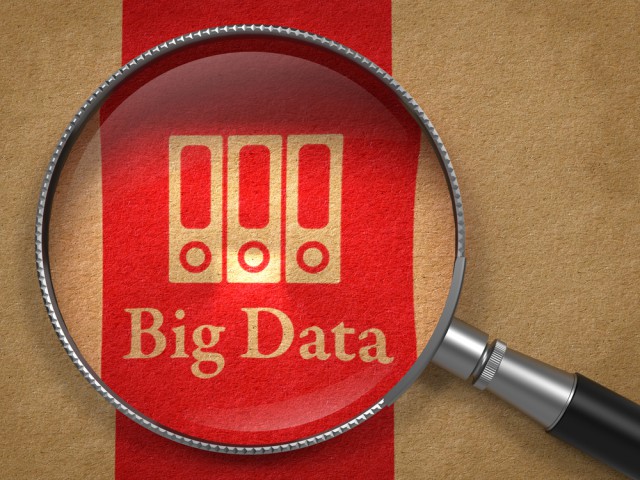
Big data has truly progressed from being just a buzzword to being an essential component of many companies' IT infrastructure and business plans. How we store, analyze, and process big data is changing the way we do business, and the industry is in the midst of the biggest transformation in enterprise computing in years.
Organizations can now look for patterns that are indicative of current or even future behavior. And the acceleration in big data deployments is helping to identify where we can expect the really big advances to be made in the near future.
But in a space which is constantly changing, with many new innovative technologies on the horizon, not to mention a particularly noisy marketplace, differentiating between what is hype and what is just around the corner can be challenging.
As such, I have outlined what I believe will be the five biggest trends in big data that will consistently permeate the news agenda this year.
A Converged Approach Enters the Mainstream
It has long been accepted that best practice is for operational and analytic systems to be kept separate in business applications, so as to prevent analytic workloads from disrupting operational processing. Hybrid Transaction/Analytical Processing (HTAP) is a term that was coined in 2014 by Gartner to describe an exciting new generation of in-memory data platforms that can now perform both online transaction processing (OLTP) and online analytical processing (OLAP), without the requirement for data duplication.
Gartner was giving a name to something that is already happening in the marketplace. In 2016, converged approaches will become more mainstream as leading organizations reap the benefits of combining production workloads with analytics in response to changing customer preferences, competitive pressures, and business conditions. This convergence speeds up the data-to-action cycle for organizations and removes much of the latency between analytical processes and tangible impact on the business.
Momentum Shifts From Centralized to Distributed Data
There has been plenty of back and forth between centralized and distributed workload models; like all things in tech, these things tend to go in cycles. For a long time, big data solutions have been built around centralized data lakes that reduced data duplication, simplified management, and supported a variety of applications including 360-degree customer analysis.
In 2016 though, large organizations will increasingly move to distributed processing for big data to address the challenges of managing multiple devices, data centers, and global use cases, in countless locations. That’s not to mention the potential changes to overseas data-security rules with Safe Harbor 2.0 on the horizon. The continued growth of Internet of Things connected devices, fast networks, and edge processing will further dictate the deployment of distributed processing frameworks. This will support an increasingly diverse number of data sources providing information to the network simultaneously.
Storage (Particularly Flash) Available in Abundance
Advances in Flash memory are driving new designs for storage products in the consumer, computer, and enterprise markets. As consumer demand for flash goes up, and costs inevitably go down, flash deployments in big data will increasingly occur. The optimal solutions though, will make use of flash and disk storage to support both fast and dense configurations. Ultimately, organizations no longer need to choose between one or the other because in 2016, this new generation of software-based storage that enables multi-temperature solutions will proliferate -- and they get access to both.
"Shiny Object Syndrome" Gives Way to Increased Focus on Value
In 2016, the market will focus considerably less on the bells and whistles provided by the latest software product, and more on established solutions that have proven a fundamental business value. New community-driven open source innovations will continue to turn heads, but this year, organizations will recognize the attraction of a product that results in a tangible business impact, rather than on raw big data technologies -- which, while promising an exciting new way of working, really just cloud the issues at hand.
Quality Wins
Investors and organizations will turn away from more volatile big data technology providers that regularly change their model, unable to find one that they can make into a viable business. Instead, they will focus on doing business with more secure options -- those companies that have both a proven business model and technological innovations that lead to improved operational efficiencies and business outcomes.
Now more than ever, an organization’s competitive stance relies on its ability to leverage data to drive business results. That’s easier said than done when it’s pouring in from every origin imaginable. Organizations with access to a converged data platform can take advantage of the widest variety of data services and processing tools on a single data platform and will be able to harness real-time insight from their streaming data. This translates into real-time views into their customers, products, and operations.
John Schroeder, CEO and Cofounder, MapR
Published under license from ITProPortal.com, a Net Communities Ltd Publication. All rights reserved.
Image Credit: Tashatuvango / Shutterstock
-

Error 404: Security insights found
Publié: janvier 15, 2016, 6:45pm CET par Johnnie Konstantas

This year has been another brutal one for breaches and data loss, with 400 new threats emerging every minute by some reports. Most security administrators and architects have been shoring up defenses inside networks in order to better detect places of compromise and attacker movement. Many organizations recognize that one of the fastest ways to beef up detection capabilities is to add context-based network analytics like those provided by Security Information and Event Management (SIEM) systems and NetFlow security analyzers.
Adoption has been brisk, the SIEM market is one of the strongest with a forecasted growth of 12 percent annually reaching $4.54 billion by 2019. And recently, Cisco further highlighted the importance of network telemetry to security with the acquisition of NetFlow analysis veteran Lancope for $453 million.
NetFlow and IPFIX have long been understood to offer critical insight to insider threat detection in that they provide contextual information about network traffic. In order to surface anomalous patterns on the network, NetFlow/IPFIX analyzers look at the packet metadata and group similar information into the bigger picture of attacker operations inside networks.
NetFlow/IPFIX records from some sources may contain additional metadata including URL, CDP and SIP user information. For instance, a DDoS attack that hits a web resource one too many times is sure to be flagged by analyzing the record for every packet hitting that resource.
Another rich source of security intelligence is contained in HTTP response codes. These may be appended to NetFlow records in order to centralize metadata intelligence. HTTP response codes are divided into five categories:
- 100 - 199 are informational
- 200 - 299 are success related
- 300 - 399 denote redirection
- 400 - 499 are generally associated with client requests
- 500 - 599 are generally server related
For the casual web user, an encounter with a 404 error code means trying a couple more times and then moving on after unsuccessfully accessing the page. But amass all of these codes over time, and through the power of analytics tools, a picture of suspicious and nefarious activity can come into view.
For instance an analysis of 2XX codes, which denote successful access to resources that require special authorization, might surface an atypical or unauthorized user getting through. A flurry of unusual HTTP 2XX codes from your servers that is well above what has been benchmarked as normal for the network could mean an attacker has found a way to send malicious requests successfully that are being answered by the target servers.
3XX codes can be analyzed for indication of redirections that are anomalous and may lead to security sensitive URIs inside target networks. Finally, too many 4XX codes in a short time span can signal that an infected machine is searching to make contact with a command and control server.
The bottom line is that these codes are a trove of network intelligence and the key to unlocking it is having access to this data and being able to analyze it. The value of NetFlow and network metadata to security analytics is undeniable. The challenge for security teams is to understand how NetFlow is being generated in their environment.
For instance, if teams are relying on routers to generate NetFlow, they may get sampled records which give an incomplete picture from a security perspective. The other item to consider is which tools and utilities the organization has for collecting and analyzing NetFlow, IPFIX and network metadata.
To have the most effective metadata analytics framework organizations should aim to centralize NetFlow generation to a security delivery platform that can offload routers and switches and provide full un-sampled NetFlow records. Security stakeholders should ensure that their NetFlow generation capabilities offer additional network information like URL/URI, CDP, SIP, as well as HTTP response codes.
Finally ensure that you have analytics tools that can consume unsampled NetFlow and metadata to provide security analytics at scale. This will give organizations the best chance of surfacing threats and malicious actors, even if they are operating "low and slow".
Johnnie Konstantas is a senior technology marketing executive at Gigamon.
Photo Credit: honglouwawa/Shutterstock
-

Is your data integrated across platforms?
Publié: décembre 31, 2015, 7:17pm CET par Pete Johnson

The lifeblood of any application is the data it uses to make decisions. It used to be that all data and applications resided within the confines of the corporate firewall, but public cloud platforms like Amazon Web Services, Google Cloud Platform and Microsoft Azure provide elasticity and cutting-edge features to today’s organizations. Because of that, more and more companies are challenging the conventional thinking that all corporate data should always be stored on premises.
But when is it appropriate to silo data, versus integrating it across different cloud platforms?
Low Hanging Fruit: Dev/Test
The easiest, most cost-effective step an organization can take to leverage the elasticity a public cloud provider offers is to run dev/test workloads on them with sanitized data. The sporadic nature of those dev/test workloads is a perfect match for the on-demand provisioning, pay-by-the-hour capacity that public clouds provide.
Even if your dev/test workloads run eight hours a day, five days a week, without public cloud providers an organization is still paying capital expense on internal hardware 24 hours a day, seven days a week. By creating a sanitized data set for dev/test workloads that mimics production but lowers risk (should that data be breached), companies can free up that 128-hour difference between 8-5 and 24/7 through hardware reduction cost savings.
Production Marketing Website: Data That’s Already Public
The second easiest place to look for data that can be moved to the public cloud without risk is a production marketing website. Data associated with these applications are already public, and their constantly changing demand, based on various marketing activities, makes them great candidates for taking advantage of cloud elasticity.
Harder Decisions: Sensitive Production Data
With the easy choices now made, some harder decisions need to be examined. Public cloud platforms can provide features instantly that would take much longer to build within your data center. For example, Internet of Things, Big Data, device farms and data streaming services are difficult to reproduce in-house at a reasonable cost, but companies typically don’t want to risk moving that data outside a corporate firewall.
One option is to set up Virtual Private Networks (VPN) with the public cloud providers, so that services running on them can have secured access to part of an internal network, and therefore the data on that network. Public cloud providers make setups like this easy to accomplish, but for data that is used by both internal and external applications, care must be taken with the network segmentation so that a breach to the external world on the VPN does not lead to the internal consumers of the data as well.
Another option is to create an Application Programming Interface (API) for the data source that uses HTTPS encryption and key authentication access. This is more costly than the VPN approach, but prevents raw access to the data and creates a cleaner entry point that does not carry nearly the same network segmentation risk.
Consider All Your Options
Any organization looking to augment on premises infrastructure with cloud platforms needs to take data access seriously. Some data is sensitive enough that it needs to remain inside internal silos, but there are plenty of opportunities for other data. Sanitizing dev/test workloads can reap huge benefits, enabling a company to offload internal hardware for public cloud elasticity. Marketing websites already have public data in them, and their wildly changing demand makes them a good fit for public cloud as well. Other pieces of data may be needed both places, and whether a VPN or API approach is used, both offer ways to integrate data across internal and public cloud infrastructures.
A 20+ year tech industry veteran, Pete Johnson is the VP of Product Evangelism and Enablement at CliQr Technologies. He can be found on Twitter at @nerdguru.
-

Myths and facts about backup, restore and disaster recovery
Publié: décembre 9, 2015, 11:04am CET par Mike Johnson

With the rise of digital data, changing technology, and common usage of personal devices, the IT world has become ever more complex with new challenges around every corner. In the wake of such quick changes and complexity, many individuals end up exaggerating the difficulties found within these new systems and thereby begin spreading some major falsehoods within this vast IT sphere.
Even though the influx of information and discovery has given way to the creation of several urban legends, below you will see what is true and what is not.
1. Tape Backups Failed for 77 percent of Businesses -- Myth!
This myth has been carried on and on and the truth is, it does not have a reference point, likely because it is old information or was misquoted. Remember the game of telephone you most likely played in school? Here is a classic example of that game played out in a real life conversation. So what is true?
Disaster recovery (otherwise known as DR) is a common structure for data centers, and the majority of companies have a plan regarding DR. Over half of these companies with a DR plan actually test it two times per year.
The alarming truth is that there is a notable percentage of companies that actually have no plan whatsoever, and even still, many do not test the plan that they DO have. Also unsettling is the fact that new threats are unveiled every month or so.
Another thing to consider is the fact that it usually takes around 24 hours for companies to recover from a disaster. This fact alone is reason enough for all businesses to have a comprehensive, not to mention, a well tested picture of the environment of their backup and recovery systems.
2. After a 10-day Recovery From a Disaster, 93 percent of Businesses Will File for Bankruptcy -- Myth!
This data was reportedly found on the National Archives and Records Administration website, but now cannot be found anywhere when people search for this particular piece of information. Once again, it is likely a result of outdated data or misunderstood information, and we again see a likely example of the game of telephone. So what is true?
Since 2007, IT practices of disaster recovery have been well studied. Most recently in 2013, it was discovered that within the last 5 years, 69 percent of companies have gone through a disaster of some kind, and that though the cost of lost data is significant, it is generally not enough to close a business down for good.
3. Disk Does Not Fail as Much as Tape Does -- Myth!
Many managers of IT and CIOS hold to this myth, and thus perpetuate it further and further. This is likely as a result from their past experiences with frequent restores and unstable servers and applications while working with tape-based systems. The disk versus tape debate is ultimately quite complex and the reliability of either depends on various factors. So what is true?
Both have been proven to be very dependable over time. According to a certain data study, it was shown that tape was more reliable since it only a bit was lost during failure, as opposed to a whole sector during a disk failure.
However, this is not necessarily the whole picture with respect to the reliability issue and must not be information that is used globally, lest another myth be created! The bottom line is this: both systems are better than ever in terms of their reliability, and both do fail.
4. Backups for Tape Are Not Tested by 34 percent of Companies -- Myth!
This myth is perpetuated often times in order to push business, and is usually paired with other myths regarding failure rates for tape restores. Here are some examples of claims that the above myth is generally paired with:
- Tape backups failed to restore at a rate of 77 percent.
- It has been stated that in last year, 42 percent of tape backup recoveries have failed.
- Tape is said to fail at a rate of 50 percent in companies that are medium-sized.
- Data from tape was unrecoverable by 40 percent of IT managers.
- Some researchers claim that there is a 54 percent failure rate for restores.
- It is claimed by others that 71 percent of restores end up failing.
So what is true?
As you may assume, it is impossible to find the original sources to the above claims, and yet they continue to be perpetuated in various circles. All CIOs and directors of IT departments are more than aware that failure regarding backups and restores do indeed happen.
Sadly, in a recent survey, many companies admitted to not being well prepared when it comes to disaster, even though they know that failure is possible, even more than likely. Even with a 98 percent rate of success with respect to backups, it doesn't necessarily mean that an administrator will have it easy in the event of a failure. In fact, this percentage can ultimately result in many backup failures depending on the size of your company.
The most important factors that need to be addressed during a failure are: where, which, and why? Tools that offer a comprehensive view of the of the entire backup system and locate problem areas are vital to incorporate and will help greatly in answering the above 3 questions.
The overarching theme regarding backups, recovery and DR is that it is becoming increasingly challenging to prepare appropriately for a disaster. There are multiple factors that could threaten the protection of your company’s data, and so the best defense in the end is being able to rest in the knowledge that there are many copies of your data backed-up.
It is also vital to ensure that the amount of time it will take to restore your data is appropriate and that data lost can be tracked during a reasonable timeframe within the window of recovery.
Photo Credit: docstockmedia/Shutterstock
 Mike Johnson is a Technical Writer for Rocket Software. He writes on topics like data protection, backup monitoring and reporting software. He holds a Bachelor of Science Management degree from DeVry University.
Mike Johnson is a Technical Writer for Rocket Software. He writes on topics like data protection, backup monitoring and reporting software. He holds a Bachelor of Science Management degree from DeVry University. -

Help me, help you: Time management strategies for small businesses
Publié: juillet 30, 2015, 5:17pm CEST par John Oechsle

As a small business owner, you have a lot on your plate. You’re managing your business’ value in the marketplace on a daily basis while at the same time striving to maintain superior customer service and employee satisfaction. There’s a lot on your mind and the minds of your employees, too. Some days, it feels like nine a.m. becomes five p.m. in a heartbeat. At times like this, you spend most of your time just trying to keep the ship afloat.
Of course, you also want your employees to feel accomplished and productive at the end of the day. Professional success is largely a mental game, after all. If you believe you are getting things done and doing good work -- then you will probably get things done and do good work! The following are steps you can take to ensure that your team is put in the best possible position to effectively manage their time.
Provide them with tools to manage their time
A great way to help your employees organize their time and increase efficiency is by providing them with a tool to do so. The digital age has created various software solutions capable of managing everything from employee calendars to contacts and customers. With the right system, employees can plug important data into their daily and monthly schedules -- like meetings and engagement reminders. Once an employee finishes a sale or solves an issue, they can record the data from the interaction so that it is easily accessible the next time they need it. Managing time with the right software solution can help your small business grow by allowing your employees more time to engage with new and existing customers.
Make sure there is clear communication
Effective communication plays a critical role in managing the time of employees at any small business. If employees are able to seamlessly share and communicate vital organizational and customer information, they will have a clearer understanding of the big picture in any given situation. Whether dealing with a customer complaint, a partnership agreement or an internal process issue, getting the right information into the right hands is essential to a timely resolution. A siloed approach doesn’t bode well for effective time management in a small business environment. There are too many moving pieces and it’s too easy for things to fall through the cracks. Maintain an updated database of shared customer information, hold weekly team meetings, and set the tone by communicating directly with each member of your team on a regular basis. Do whatever it takes to ensure there is an excellent stream of communication within your organization because a little extra effort now can save a lot of time in the long run.
Manage employee time with customers
Another way to help your employees manage their time is by keeping track of their customer service experiences. Your employees are the faces and voices of your business, and you work hard to provide a pleasant experience for your customers. You want each experience to be beneficial and productive for your team and your patrons. Have a process in place so that your staff knows how to route different problems in order to expedite service. The most efficient way to boost your customer experience is to decrease wait time. When one employee can’t solve an issue, they should have the necessary tools and information to transfer their client to the person most capable of meeting their needs promptly. One employee shouldn’t spend an hour troubleshooting a customer problem when another can handle the case in just a few minutes.
Cross-train and delegate responsibilities
Small businesses are better positioned to grow lean if they emphasize the importance of cross-training employees and delegating responsibilities effectively. Employees who are trained to serve multiple functions for the company can be moved around based on current needs as the business grows. If the popularity of your product is increasing quickly, you can reallocate cross-trained employees to help with sales or customer service. If you’ve just release a new product, you can put more people on customer service and training. Cross-training and properly delegating your workforce to help out where they are most needed is a great way to manage the time of the most important asset a small business has -- it’s employees.
Successfully managing your time and the time of your employees will boost efficiency and create new growth potential for your business. Your employees will be able to increase productivity and customer satisfaction by dealing with issues quickly. Be the leader that encourages your team’s success through effective time management solutions.
Photo credit: Filipe Frazao / Shutterstock
 John Oechsle joined Swiftpage in July 2012 and currently serves as president and chief executive officer. John came to Swiftpage with a 30 year track record of building highly profitable and sustainable revenue growth for emerging companies and established global leaders. John is an advocate for technology and education in Colorado and has been an active contributor to the Colorado Technology Association (CTA). He has been recognized several times for his involvement in the tech industry. In 2006 and in 2009, John was awarded the Technology Executive of the Year, and the Titan of Technology awards by the CTA. John was also awarded the Bob Newman Award for Outstanding Contribution to the Community by the CTA in 2011.
John Oechsle joined Swiftpage in July 2012 and currently serves as president and chief executive officer. John came to Swiftpage with a 30 year track record of building highly profitable and sustainable revenue growth for emerging companies and established global leaders. John is an advocate for technology and education in Colorado and has been an active contributor to the Colorado Technology Association (CTA). He has been recognized several times for his involvement in the tech industry. In 2006 and in 2009, John was awarded the Technology Executive of the Year, and the Titan of Technology awards by the CTA. John was also awarded the Bob Newman Award for Outstanding Contribution to the Community by the CTA in 2011. -

5 cyber security tips for travellers
Publié: juin 22, 2015, 2:51pm CEST par John Shaw

Out of the office on holiday this summer? Despite being encouraged to switch off, and enjoy a well-earned break, the reality is that many people find it difficult to "go dark" and so fall into the trap of checking emails by the pool.
So whether you’re travelling to a conference or a hitting the beach, you need to take appropriate steps to keep your data secure, particularly when browsing the internet or making online payments from your mobile device.
With Wi-Fi continuously available today in planes, trains, cars and hotels, the potential is there for us to remain constantly connected. However with that, comes the temptation to cut the usual corners where online security is concerned.
With that in mind, here are five simple cyber security tips:
1. Not Using Your Device? Lock It!
However careful you are, we’re all at risk of leaving a phone in a cab or perhaps dropping it in a bar, so you need to make sure no one can access important data, should it get into the wrong hands.
Set your devices to auto-lock after two minutes to ensure your content remains private.
Pick the longest and most complex password you can manage. Don’t use a four-digit pin on your phone because that seems to be the norm. Changing to eight digits means it takes a hacker 10,000 times longer to guess it.
Making the effort to encrypt your phone will render it useless to a criminal. This is automatic on iOS 8 devices.2. Public Wi-Fi Is... Public
If something seems too good to be true, chances are, it probably is. Security bugs are common in public Wi-Fi routers, even in the hospitality industry.
You can’t always be sure the hotspot is what it says it is. Hackers can set up seemingly kosher network names so they can snoop on your personal information. Consider using your mobile phone network, or buying a SIM when you arrive to use Pay As You Go data as you need it. Better still, use the company VPN if you can.
3. Turn Off Geo-Tagging and Geolocation Features
Before you post a picture of your ice cold beer by the pool to social media, consider this: Does every Tom, Dick and Harry need to know you’re away from home?
Go through your applications and make sure as much geo-tagging is turned off as possible.
For the "tinfoil hat" wearers, even if you have GPS turned off, your phone can still work out where you are by keeping track of all the Wi-Fi access points it can see around you. Airplane mode is the only way to guarantee you cannot be tracked.
4. Public Computers and ATMs: The Risks
Sometimes it pays to be more conservative than usual, especially when you’re traveling in unfamiliar territory. Public computers, like those at Internet cafes or business centers at hotels, could be infected with malware, which might spy on you when you go online. Crooks can also attach a card reader to an ATM or a sales register to skim the account numbers off your credit card.
If in doubt, travel with cash. For online payments, services such as PayPal allow you to make a transaction without typing in card details.
5. Add Layers of Protection to Your Mobile Devices
Fortify your accounts wherever possible. It’s always worth strengthening your cyber defences when in an unfamiliar environment.
For added protection, use an antivirus on your Android smartphones as well as your laptop (both Windows and Mac). This adds another layer to the login process.
As a general rule, you should also update your operating system when it prompts you, and keep an eye on apps permissions. For example, there is no need for an alarm clock to be able to read your list of contacts! This will all stand you in good stead for complete protection of your mobile devices.
John Shaw is VP of product Management at Sophos.
Published under license from ITProPortal.com, a Net Communities Ltd Publication. All rights reserved.
Image Credit: Rido / Shutterstock
-

5 things to consider before outsourcing
Publié: juin 2, 2015, 6:13pm CEST par John Cooke

In today’s fast-paced business world, driving efficiency is often at the heart of growth plans. When thoroughly planned, outsourcing plays a vital role in ensuring productivity is high, enabling managers to focus on business development and disruptive innovation.
However, some organizations cause irreparable damage to their business by outsourcing too early, while others risk falling behind to more innovative competitors by ignoring the opportunities available; and some companies outsource the wrong mix of activities. It’s unclear whether this balancing act is why the outsourcing market in the UK declined in Q1 compared to the same period last year, although it could also imply a wariness to trust third parties with internal business processes.
If this is the case, business leaders are setting themselves up for a fall. Failing to outsource effectively can cause irreparable damage to an organization. Put simply, business growth will be stunted.
To ensure SMEs are reaching their full potential, John Cooke, a founder and managing director at Black Pepper Software, investigates the top five considerations every business should make before outsourcing.
1. Cost-Efficiency
Put simply, the majority of outsourcing takes place to increase profit margins, lowering expenditure on labor and operational costs, while improving the bottom line. However, the cost-efficiency of taking this approach comes into question if the wrong processes are left in the hands of a third party.
Offshoring well-defined maintenance tasks, such as payroll management, removes the need for businesses to hire in-house experts to manage accounts, freeing up capital which can be invested elsewhere. Core activities shouldn’t be outsourced though, as the necessary knowledge levels will inevitably be found in-house and should remain at the heart of the company. Google wouldn’t outsource search engine algorithm innovation to a third party for example -- it would risk losing its competitive advantage. The same is true for all businesses, regardless of size.
2. Business Reputation
Businesses live and die by their reputation and in the social media age, each product and service they offer is scrutinized under the microscope. It’s therefore vital that the highest possible standards are maintained continuously, especially for external-facing processes. Failing to take your reputation into account before outsourcing may be the biggest mistake you ever make.
Take call centres for example. When outsourced efficiently consumers rarely realise they aren’t speaking to an in-house representative. However, if offshored poorly a disconnect between the business and its customer service becomes far too apparent, leading to a vocal and costly backlash. The same is true of all external processes. Offshoring may free capital, but if service levels drop the cost of rebuilding business reputation is much higher than any initial savings.
3. Innovation
Many businesses aim to transform their offerings and innovate like a start-up. However, internal constraints and practices can stifle this. Established businesses investing capital in disruptive innovation should be the cornerstone of their development plans. Outsourcing innovative processes such as software development often breeds the best results, as internal team members may be too close to the business’ existing processes to think outside the box.
When successful, such innovation is highly lucrative. By researching and identifying a new market the disruptive business will immediately become the industry leader, leaving competitors in its wake. If companies fail to do so their competitors will, so outsourcing wisely in areas such as innovation is critical.
Businesses need to be wary though: pick the wrong partner and it can set back innovation and growth, resulting in missed opportunities. A partner must be agile, able to rapidly adapt to ever-changing business needs, all while working very closely with the company.
4. Communication and Collaboration
Agile development has continued growing in popularity, with continuous communication and collaboration at the heart of innovative projects. It’s therefore vital to keep this in mind before outsourcing project work to a third-party, especially when considering offshoring. UK businesses which turn to Asian companies will likely find daily iterations are difficult to manage due to the vast time differences. In some circumstances, there may only be a few hours of overlap during the working day so time for communication is limited and can seem rushed. This will either impact product quality, or at least result in unnecessarily long lead times. Also cultural differences shouldn’t be underestimated, companies frequently need to work much harder to overcome these than is often considered up-front.
However, when outsourcing onshore, communication isn’t strained by time zone difficulties, cultural differences are minimized and daily iterations are also still possible to ensure projects remain on track. Large companies can benefit greatly from onshore outsourcing, taking advantage of rapid and low cost innovation using an external team without draining resource from their day-to-day operations.
5. Calculated Risk
Outsourcing is often unfairly viewed as a risky option, and although there is risk involved this depends on the type of processes outsourced. If core business practices are offshored the risk is huge, as you have little control over what is a central element of your organization, which can have disastrous results. On the other hand, outsourcing development projects should be viewed as well-calculated risk, offering businesses an opportunity to research their market and work closely with a third party to innovate and generate the highest quality results possible.
Our work with design specialist Black Country Atelier (BCA) highlights this, as the firm is aiming to offer technology which enables consumers to design their own loomband pendants on their mobile device before 3D printing it in-store. This was a movement into a completely new market for BCA yet they outsourced app development and the project was turned around within a week, rather than the usual months which traditional approaches offer.
Having such fast turn around and innovative input at a low cost enabled BCA to test the waters with a product that may now hit the high street before the end of the year.
Time to Reap the Rewards
Outsourcing is a key element of business today and to write it off as unnecessary risk is short-sighted and leaves organizations at risk of being left behind by their competitors. Companies simply can’t be as efficient if they handle all tasks internally, while failing to look further afield than the office floor for expert advice when aiming to disrupt the market can be a mistake which is impossible to bounce back from.
Published under license from ITProPortal.com, a Net Communities Ltd Publication. All rights reserved.
Image Credit: Syda Productions / Shutterstock
-

What every small business needs to consider when buying a PC
Publié: mai 20, 2015, 8:46am CEST par John Hampton

Today’s small business requires PCs that drive productivity and collaboration without the premium price tag. Whether it’s the clarity from visualizing data, the smoothness of streaming media or the responsiveness of modern apps, every detail matters to effectively run a small-to-medium-size organization.
When searching for a PC that best suits a small business, whether it’s a desktop or a laptop, be sure to consider the following features and capabilities.
Outstanding performance with turbo core technology
Online presentations, video conferencing and modern business apps require smooth, virtually uninterrupted visual and audio performance. Many small businesses need pro-level processing for seamless performance, online collaboration and productivity.
Companies can find this level of performance in systems that have turbo core technology which dynamically adjusts to give employees a performance boost just when the operating system requests the highest processor performance.
If a core is operating below maximum limits and your workload demands additional performance, the processor frequency will dynamically increase until the upper limit of frequency is reached. As your workload subsides, the core returns to normal frequency. Ultimately, this helps boost notebook and desktop PC performance when you need it, and helps save energy and battery life when you don’t.
Security, manageability and virtualization tools
Small business owners don’t need to purchase a high-priced processor for robust silicon-level security, integrated virtualization support and manageability features.
But they do need a PC built on industry-leading open standards so the business can choose what’s best for them, rather than being locked in by proprietary solutions or costs. When choosing a PC, it’s important to look for DASH functionality and secure virtualization:
DASH functionality
A system based on DASH (Desktop and Mobile Architecture for System Hardware) standards will enable your PC to be compatible with a broad range of software and technology on desktop and mobile systems.
DASH-based systems offer highly competitive out-of-band manageability feature sets, enabling greater management flexibility in a multivendor client environment, at a business-friendly price.
Secure virtualization
A system with secure, built-in processor virtualization will offer a small business peace of mind with firewall-like technology that helps protect physical storage from attack.
Memory will stay safe from peripheral-based threats with I/O virtualization, which allows guest virtual machines to directly and securely use peripheral devices such as Ethernet, accelerated graphics cards and hard drive controllers.
Professional user experiences
Small businesses need professional user experiences on their PC to enhance their productivity and simplify the way employees interact with their systems. A few of the most important professional experiences to have on your desktop or notebook are below:
Face login -- Instead of having to memorize lengthy usernames and passwords, you can simplify the way you log on to the most visited sites on your laptop with face login capabilities. You can set the accuracy level to “high” so that you have to blink to log in to add some additional security to this convenient feature. You can also use the face-out feature, which can either automatically put your PC to sleep or lock your PC screen when you leave your computer.
Gesture control -- Gesture control capabilities allow you to control your notebook virtually hands-free. It allows you to wave your hand in front of your laptop’s built in camera to advance to the next Microsoft PowerPoint slide or skip to the next video.
Multi-display technology -- Multi-display technology expands the traditional limits of desktop computing by multiplying your screen area. With multiple monitors, workstations become more useful and employees can become more productive. This technology enables viewing large scale models and multiple applications across several screens like they were a single display to prevent wasting time and potentially missing information by switching between applications.
Quality visual collaboration
Video conferencing holds many opportunities for small businesses today to fulfill the increased demand for wider-reaching communications and provide employees with the opportunity to work from home or while traveling.
The benefits go beyond saving time and expense of travel, increased speed of business, and improved human connection with real-time feedback. Small business owners should look for superior quality graphics and audio features in a laptop to ensure the best and most productive video conferencing experience
Superior quality graphics provide greater non-verbal cues that are integral to fostering conversation and understanding during a video conference. Image enhancement technologies and dedicated video encoding and decoding are built in to the latest accelerated processing units (APUs) to ensure messages do not get lost by laggy, low-quality conferencing.
Acoustic Echo Cancellation (AEC) is also a fundamental feature of quality video conferencing. Echo can be caused by many factors, such as a microphone picking up the audio from a speaker and allowing that audio into the transmitted signal with a slight delay.
If unchecked, this can lead to several problems including the remote party hearing their own voice, strong reverberation making the voice channel useless, and howling created by feedback. This can be addressed through potentially expensive microphones and audio equipment, or using a system with the ability to clean up the audio signal.
Ultimately, the less time and money spent maintaining PCs and managing technical issues, the more time can be spent on what really matters, growing the business.
John Hampton is Director of the Commercial Client Product Business Unit at AMD.
Published under license from ITProPortal.com, a Net Communities Ltd Publication. All rights reserved.
-

DevOps can help minimize downtime, fix problems sooner
Publié: avril 7, 2015, 3:38am CEST par John Rakowski

With businesses becoming increasingly reliant on applications to generate revenue, it’s essential that downtime and glitches are kept to a minimum.
Research from IDC and AppDynamics has shown that infrastructure failure costs $100,000 per hour on average in this 24 hour service environment. Although it’s practically impossible for businesses to prevent application failures completely, the time taken both to predict and fix them is one factor that can be improved.
Despite this, in the same report, 35 percent of businesses estimate that IT failures take up to 12 hours to fix, and 17 percent of respondents say that it can take a number of days to fix critical application failures.
As revenue losses mount up rapidly when applications fail, it is apparent that changes need to be made to improve mean time to resolution for a significant number of businesses. However, rather than sub-standard hardware and infrastructure, it is often the processes that businesses use to identify and fix faults which are the main cause of the problem.
Within legacy, enterprise organizations, where there is a clear distinction between the development and operations teams, the working relationship between these two departments leaves a lot be desired. When an application issue occurs, the responsibility of fixing it initially lies with the operations team who will usually use myriad of monitoring and management tools, searching specific and siloed infrastructure components such as CPU, memory and network, before often discovering that the development teams need to be engaged.
The development teams often use their own diagnostic tools, which lead to multiple sources of data, multiple sources of information and ultimately multiple sources of confusion. The end result is that the time taken to find the root cause of the problem is much longer than it should be and unfortunately the impact to the business is almost certainly a loss of customers and revenue. Moreover, as development teams often work different shift patterns and in different locations, even getting hold of the right person on the development team can prove challenging.
But it doesn’t have to be this way. The adoption of a DevOps culture, which aims to develop a collaborative relationship between the development and operations teams, has been shown to improve flexibility within the IT department, and also speed up the application fixes too.
With DevOps, the responsibility for application performance is shared between both departments, meaning that the development team is more involved from the start. Rather than simply developing code and passing this over to operations team to place into production, the whole process is shared more equally, with actions taken to make sure both teams have visibility of application performance.
By implementing application performance monitoring (APM) for example, and giving visibility of this to all stakeholders, IT departments can pinpoint problems much quicker. In addition, by using a source control system, which records and tracks any changes to code, this allows members of both teams to understand the other’s way of working and why certain changes have been made.
A DevOps approach also allows bug fixes to be found and added to the production environment far more easily and quickly. Within a traditional set-up, where the development environment is kept separate from the production environment, new features and bug fixes occasionally fail to work correctly when released into the real world due to differences between the two environments.
As a result this increases the likeliness of errors once the code is deployed and can increase the Mean Time To Resolve (MTTR) application errors. The differing environments also mean that configuration often needs to be altered by the operations teams before being placed into the production environment which again increases the time taken for it to be deployed. As a result, the inconsistent data between development and production environments slows down the process of deploying releases and changes, which invariably means increased cost to the business.
By introducing automation as part of DevOps adoption however, many of these problems can be overcome. By automating code testing and the provisioning of environments, this allows time spent on these two tasks to be reduced considerably and ensures the two environments are based on the same configurations.
This means developers can write code in smaller chunks and place these into the development environment much more rapidly, which dramatically decreases the time it takes to deploy new features, changes and fix any bugs in applications. In fact, the IDC and AppDynamics report has shown that businesses expect that DevOps will accelerate the delivery of capabilities to the customer by 15-20 per cent, indicating the improvements in speed that the set-up can bring.
However, as DevOps also enables the speeding up of new applications and features to optimize employee productivity and delight customers, it is important that businesses ensure that this increase in change does not mean more application downtime as a result.
Gartner for example has predicted that in 2015 80 per cent of outages will be caused by people and process issues, and more than 50 per cent of these will be caused by changes configuration and release integration.
By having end to end application visibility for both operations and development teams however, businesses can use APM as a way to feed back and feed forward pertinent information into the software development lifecycle (SDLC). This helps to ensure that new releases and changes don’t generate business-impacting problems in live or production environments.
In order to make DevOps work, CIOs will need to overcome a significant number of cultural challenges in both the working style of the business and in terms of acquiring the right IT talent to support DevOps adoption.
For instance, organizations will now need developers that understand or even have the ability to undertake complex infrastructure automation tasks and operations staff that have the required software engineering skills to know, at least the basics of application coding.
Having said that, the necessity of maintaining the smooth running of applications and the cost savings that can be achieved as a result, means these changes are essential for meeting customer needs and generating revenue.
John Rakowski is a solutions evangelist at AppDynamics.
Published under license from ITProPortal.com, a Net Communities Ltd Publication. All rights reserved.
Photo Credit: auremar/Shutterstock
-

How to choose an operating system for a virtual private server
Publié: février 23, 2015, 3:59pm CET par Paul Johnson
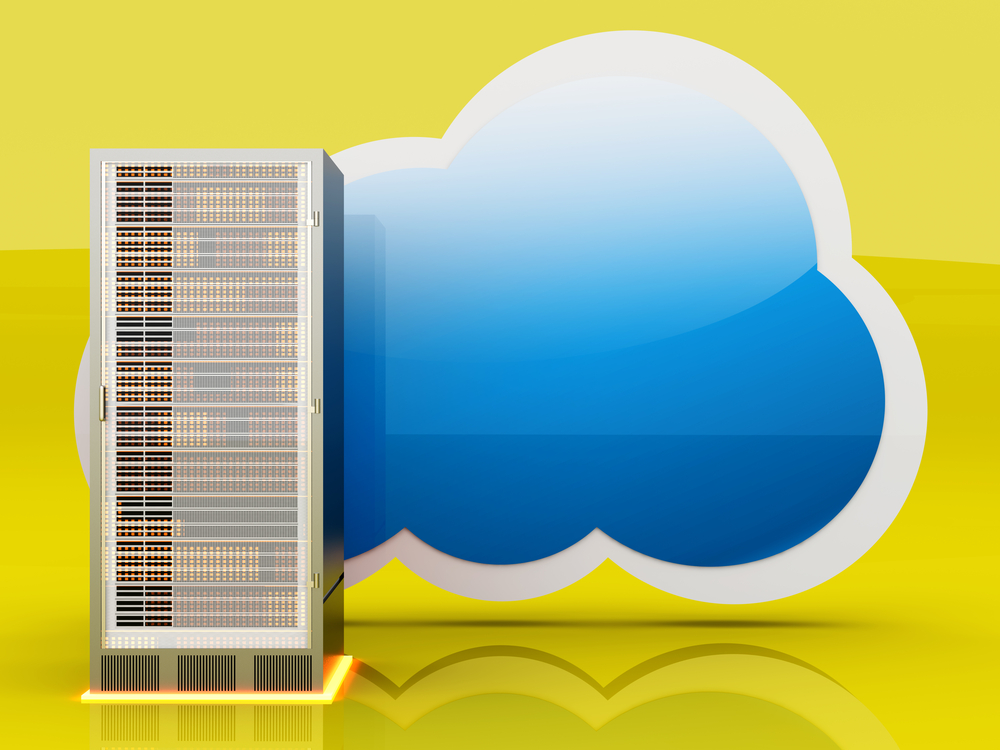
Internet technologies have penetrated into all areas of our life and changed it dramatically. With their help, people are able to implement most of their activities from reading favorite books and newspapers, communicating with each other, playing online games to booking tickets and buying particular products and services through their desktops, smart phones and tablets. As the number of online users has increased, plenty of different businessmen and even large companies and corporations have decided to move their ventures into Internet to get additional revenues. This technique appeared to be one of the most effective and lucrative, as it allows to find new customer segments and promote business projects in a short period of time.
Currently, the online business environment is full of various websites, which try to attract client's attention by a pleasant look, useful customer services and loyalty programs. However, website owners forget that a significant part of future success depends on a hosting plan they use for their online business activity. The more powerful your server is, the more high-speed and accessible your website will be, what will help you build strong relationships with your visitors for many years to come.
When you choose hosting services, you must be very attentive, as plenty of different hosting packages that are available in the hosting marketplace, can easily confuse even the most sophisticated website owners. Very often, buying hosting solutions, plenty of online businessmen don't have an idea what actually they need. As a result, thousands of websites can't handle with high loads and provide their visitors and owners with poor performance, low functionality and regular downtimes. To prevent this, I decided to outline some features of one of the major hosting solutions -- a VPS server.
VPS Hosting
A virtual private server (VPS) is a physical server, partitioned into several virtual ones between a particular numbers of users. Such a virtual copy is totally isolated from others and possesses its own operating system and dedicated resources. In this case, a user still shares CPU performance, RAM and bandwidth with other users, but he gets full control over his server options. In the other words, you will get a dedicated server on the shared hosting basis.
Nevertheless, before buying a VPS hosting plan, you should decide on which operating system your server will run. As a rule, all VPS servers work under two main platforms: Linux and Windows. Both of them possess their own specifics and are oriented on different website owner segments.
Linux VPS Hosting
Linux-based hosting solutions utilize the Linux open-source software. Thanks to this fact, website owners are able to avoid spending their funds on purchasing licenses for downloading and running particular Linux programs and add-ons. A Linux VPS server will be a true gem for companies, which would like to make a fast start, but still meet budget limitations.
Advantages of Linux VPS Servers
If you still have a strong intention to provide your website with Linux VPS hosting services, you should pay your attention to further points:
- Reliability and flexibility -- Linux VPS servers consume less resources, what increases website performance and excludes the appearance of possible downtimes. Furthermore, users will be able to allot resources between applications if required with the help of a control panel (cPanel);
- Compatibility -- if you want to make your website pages more user-friendly and improve your server reliability and uptimes, then the Linux platform will be the most deliberate choice, as it supports a wide range of coding languages, such as PHP, Python, Perl, MySQL and Ruby on Rails;
- Interaction -- all VPS servers are equipped with SSH text-based command systems, which allow users to increase functionality of their servers and reduce their overloading dramatically. However, a user must possess particular coding and programming knowledge to implement his operations via a SSH system;
- Development -- as the Linux platform has got an open-source code, a website owner is able to change his server configurations, perform updates and customizations, as well as install various add-ons and applications, basing only on his needs and preferences.
Windows VPS Hosting
Windows VPS servers work under the Windows operating system, which makes them rather popular among plenty of website owners. Nevertheless, I have to mention that these hosting solutions are more expensive, as the Windows platforms are commercial software, which requires fees for installing and using additional programs and applications.
Advantages of Windows VPS Servers
If you are a great follower of the Windows operating system and want to buy a Windows hosting plan, then you should know that your server will provide you with following features:
- User-friendly interface -- all Windows VPS servers possess a familiar and easy-to-use graphical user interface (GUI), which will be especially useful, if you are not sophisticated in server management and maintenance;
- Improved control -- every user is provided with an option called Remote Desktop access. With its help, a user will be able to control and manage his server at any time and from any place on his own;
- Website support -- Windows-based hosting solutions include such programs as ASP and ASP.NET, which will come in handy, if you want to create complex websites or customize your current website that runs on the Microsoft software;
- Strong security -- as a rule, Windows VPS servers are equipped with professional antivirus software and anti spy programs, as well as reliable firewalls, so you shouldn't be worry that somebody will hack your server and steal all valuable data.
Differences between these hosting solutions are obvious. In summary, I would like to mention that when you choose between Linux and Windows VPS servers, first of all, you must consider not only their features, but mostly your business goals and skills, as well as hosting company consultations. However, if you know some other advantages of VPS servers that work under the Linux and Windows operating systems, I appreciate your thoughts in comments below.
Photo Credit: Spectral-Design / Shutterstock
Paul Johnson is a marketing manager at KickAssVps, an established provider of VPS hosting services.
-

How Apple is winning in the enterprise
Publié: novembre 25, 2014, 5:59pm CET par Tad Johnson
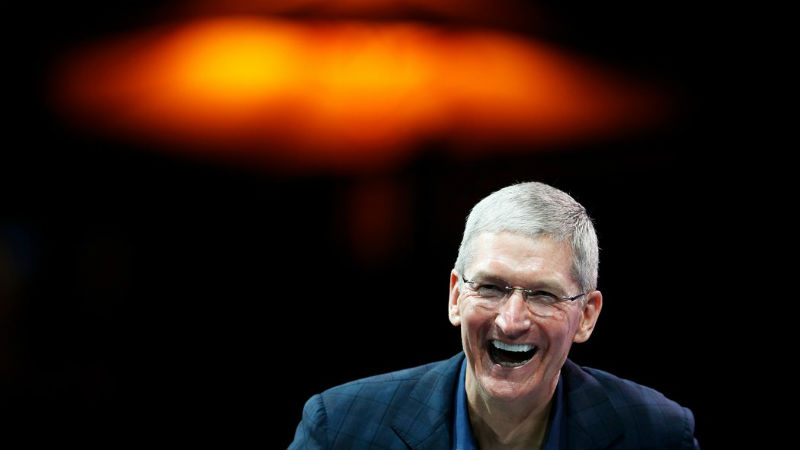
Whilst PCs continue to be used in the workplace, the Apple collection of Macs, iPads, and iPhones are dominating the desk-space and pockets of the workforce. A recent survey revealed that 60 percent of US businesses are supporting more than 100 Apple devices and the UK seems to be following suit with Apple continuing to introduce features for the UK enterprise market -- such as the news that it will be expanding its Device Enrolment Program (DEP) to 26 countries, including the UK, Netherlands, France and Germany, highlighting Apple’s commitment to the enterprise. In addition, the program has also been opened up to devices purchased through third party resellers. This highlights the growing importance and demand for enterprise friendly software. So what is driving all this enthusiasm in the enterprise?
The take-up of Apple in the enterprise has been created by a series of drivers all coming together -- from growing popularity within the C-suite who wished to connect to the network, to millennials choosing to only work with their favorite consumer device and quite simply Apple’s decision to remove the pain of device management and application roll outs through its Zero Touch configurations and Volume Purchase Programs.
The Apple generation
The popularity of Apple in the consumer market has slowly but surely created a generation who has spent a sizable portion of their life owning and relying on Apple devices. According to telecoms regulator Ofcom, 61 percent of UK adults now say they own a smartphone, while household take-up of tablet computers has almost doubled over the past year to 44 percent. Leading the siege of lifestyle upon the workplace are "Millennials" who not only want to use their devices, but often do not see why it should be a problem in the workplace in such a digitally advance age. Like enterprises, the education system is also calling for more IT in the classroom for better user engagement and to help create a digitally savvy workforce.
Whereas it is easy to focus on the insatiable, "digital natives" that make up Generation Y when looking to identify key influencers, the truth is that there is as much demand coming from higher up the chain. IT departments may be able to say "no" to the interns, but saying "no" to the boss is more difficult. Often, executives will bring their new devices into the workplace and, through facilitating their implementation, IT are able to expand this enablement to cover the whole organization. Between the bosses and the employees and teachers and students, the IT department are tasked with finding solutions that will work for both the enterprise and the educational institute but this has previously not been an easy task until now.
Apple means business
Apple has improved its enablement and device management strategies greatly over the past 12 months, and especially through the iOS 8 operating system. One of the areas in which it has been making large strides is through the facilitation of large scale deployment and purchase of apps throughout the enterprise. Both the enterprise and education programs now have support for a feature called The Volume Purchase Program (VPP).This program allows for IT to control and distribute apps across the breadth of the workplace, whilst retaining full ownership of the apps. Apple also surprised many onlookers by introducing the 'Zero-Touch' management across Europe.
Both the enterprise and education programs now have support for Mobile Device Management hands-free configuration. This 'zero touch' setup has been a long-requested feature for many pros, as it eliminates the need to cable up every deployed device and install a profile via Apple’s Configurator utility. Removing the hassle and workload from managing large numbers of devices, is the key way in which Apple is matching enthusiasm from the workforce with clear, effective and practical enablement programs in place. Third-party companies have arisen from the desperate need for both education and businesses to enjoy the benefits of Apple devices in a controlled and secured way -- helping technology staff to upload software, manage security apps and oversee productivity for thousands of phones, tablets and Macs within a click of a button.
The popularity of Apple, combined with the growing ease in which devices can be incorporated into the enterprise, is creating a working environment ripe with possibilities. Many people have chosen to focus on the issues of security, but what today’s statistics show is that Apple is becoming not only increasingly popular, but increasingly trusted in the workplace from the top to the bottom.
Tad Johnson is commercial marketing manager at JAMF Software
Published under license from ITProPortal.com, a Net Communities Ltd Publication. All rights reserved.
-

Choose a cloud vendor that meets your needs
Publié: octobre 31, 2014, 12:27am CET par Johnny Carpenter

There is little doubt that cloud will play an increasingly important role as more and more organizations adopt cloud based strategies to underpin their IT infrastructures. Indeed, cloud hosting offers a wide variety of advantages to companies with the expertise to take advantage of it. Applications can be rolled out faster, resources can be rented rather than purchased and infrastructure can be right-sized to support monthly and seasonal peaks.
However, a global survey commissioned by iland in April 2014 and undertaken by analyst firm Enterprise Management Associates (EMA), highlighted that there are also plenty of challenges when moving to a new cloud based infrastructure. In fact, 91 percent of those surveyed experienced at least one unexpected challenge when moving to the cloud with pricing, performance, scalability and location all topping the list of issues.
The EMA research revealed that most organizations won't adopt a single vendor for their cloud requirements but will work with multiple vendors to best meet their IT, security and compliance needs. One of the reasons behind this relates to data sovereignty, as most organizations consider the guaranteed location of their workloads of paramount importance, as this can impact the laws that govern the application, the data and ultimately the company. Most organizations going down the cloud route will therefore seek to control the movement of their IT footprint in accordance with conscious choices regarding data sovereignty.
Organizations should choose a vendor that can guarantee the location of its IT workload, with proximity being a key factor in this decision. However, the flip side is that this leaves little protection against local natural disasters or territory-related data breaches. If you have your data safely located elsewhere, for example your fail over data center is located far from home, this does provide an additional layer of security. Many organizations, however, won't consider this as a viable option due to data sovereignty and compliance to local regulation and laws.
This is particularly important for EMEA companies as the EU Data Protection Directive adopted in 1995 is set to be replaced with new legislation known as The EU General Data Protection Regulation. It is expected to be introduced some time in 2015. I question how much impact this new legislation will have and wonder how prepared many of the existing and up-and-coming cloud providers are for this new regulation.
In particular data collection, retention and breaches are areas that the EU plans to tighten up on with the new regulations. Here are a few aspects that we've gleaned of particular importance:
Data Collection
Two significant new rulings around the collection of data are:
- EU users must acknowledge that they are aware they are submitting personal data.
- Data portability is still to be worked out, but when it is, there will be massive fines for leaking data across countries. Fines for non-compliance are already in place and can be up to 2 percent of the annual global sales of the company.
Data Retention
Data retention is currently under review in the EU. In April 2014, the Court of Justice of the European Union declared the Data Retention Directive invalid. The Directive had ordered European states to pass laws that obliged certain Internet organizations to log records of their user's activity, keeping them up to two years and providing police and security services access to them. The court decided that the Directive was not proportionate and did not go far enough in protecting the fundamental rights to privacy and the protection of personal data.
However, the court did recognize that data protection under specific conditions does serve a legitimate interest to the general public, namely the fight against serious crime and the protection of public security. So although the Directive was declared invalid, rest assured companies will not have a free rein to do what they want.
Data Breaches
Data handling and protection is a major concern. Failure to meet regulations can mean expensive fines for cloud providers, wherever they are located. If a breach occurs the cloud provider is required to contact the EU regulatory body. Failure to do so means additional sanctions can be levied.
If the breach occurred because adherence to proper data protection was not performed the cloud provider can expect to pay a sanction which, again, could be up to 2 percent of the annual global sales of the company.
Johnny Carpenter is UK director of iland
Published under license from ITProPortal.com, a Net Communities Ltd Publication. All rights reserved.
-

Internet and inequality: The digital divide gets personal
Publié: octobre 8, 2014, 7:35pm CEST par John Dilley

Access to fast, reliable Internet empowers people to learn for themselves. It gives them the means to solve their own problems. It eliminates one of the obstacles that stands in the way of the oppressed knowing how others have freed themselves in the past. Unfortunately, we found that low-income areas with the most to gain from access to the world’s knowledge, continue to lag behind in Internet speeds.
On average, states whose populations are made up of people with lower incomes living in rural areas are likely to have the slowest Internet speeds. In order to gain a greater understanding of the role of wealth in regards to Internet speeds, we compared average Internet speeds for all 50 states with several financial factors.
The only economic factors we found that show any significant relationship with Internet speed were the ones that indicate wealth on a personal level. There was no significant relationship between Internet speed and a state’s Total GDP, its tax rates, or its unemployment rates.
The average Internet speed in a state is related to the average wealth of the people in that state, not to the wealth of the state itself (as shown in the chart below).
High Correlations with Population Distribution Found
One other place where we did see a significant correlation was the percentage of a state’s population living in a metropolitan area. We found that correlation to be 0.50. That relationship was also reflected in the 0.51 correlation we found between Internet speeds and population density.
This makes sense. It is more efficient to provide Internet to many people at once, than it is one at a time. It costs nearly the same total dollar amount to build the infrastructure of a broadband line whether it delivers Internet to one house or to a high-rise apartment building. But, with the apartment building, you get to charge everyone for the service. With the house you've only gained one customer. Under this paradigm, any savvy business owner would roll out their best services to metropolitan areas first.
The divide in economics and slow Internet access likely compounds problems that states like Wyoming and Montana have; 66 percent of the Montana population lives in rural areas, and they have the second slowest average Internet speeds. That combination is difficult to overcome.

Financial indicators correlated with average Internet speeds by state
Tough Questions Are Ahead for Rural and Low Income Communities
While seeing sub-par Internet speeds in places with poor and rural populations makes sense, it also raises questions about the future for such areas:
- If there is little business incentive for corporations to service these areas, then should the government provide the infrastructure?
- If so, then with which funds?
- If not, then are governments forsaking their people to involuntary ignorance?
These types of questions are already being debated in municipalities weighing the pros and cons of publicly-funded Internet. They will likely be answered differently depending on the values of each individual community.
Worldwide Correlations Are Stronger
The puzzle of high-speed Internet access and the role it plays in human advancement extends beyond the United States. In fact, the personal wealth correlation is even stronger on a global scale.
For the 125 countries on which we have data, we found a correlation of 0.79 between the percentage of the population with a broadband subscription and the GDP per capita. We also found a correlation of 0.78 between the percentage of the population using the Internet and GDP per capita. These finding coincide with the information we previously found about the digital divide and GDP.
The likely explanation for these huge correlations internationally as opposed to the smaller correlations from state to state is that there is such a huge variation in both categories from nation to nation. The variation of GDP per capita across the nations for which we have data was over $100,000, while the same variation across the states was just under $40,000. There was a similarly gargantuan gap in the variations in the percentages of populations using the Internet. That variation across our international data set was 94.91 percent, but it was only 24 percent across our state data.
Improving Internet Speed Is Important
It seems fitting that the population element plays a large role in the data. A population is made up of individual people. The importance of research like this lies in the effect it can have on individual people.
The Internet has the opportunity to be the great equalizer in our world. It creates a gateway to an enlightened global society and, as we've shown before, it relates to people's intelligence and happiness. Unfortunately, individual financial factors seem to limit Internet access and speed.
As communities across America decide whether they should publicly fund Internet infrastructure, they have the opportunity to make a statement about the importance of high-speed Internet. By understanding the cultural environment of the Internet, we can all work to remove the barriers that keep people from accessing the wealth of knowledge the Internet provides. Just as knowledge is power, enlightenment is empowerment.
This article first appeared at Internet and Inequality -- The Digital Divide Gets Personal
 John continually offers unique insights and a fresh point of view. Along with writing, John has a passion for music. He is the lead vocalist and secondary guitarist for The Family Gallows in Salt Lake City.
John continually offers unique insights and a fresh point of view. Along with writing, John has a passion for music. He is the lead vocalist and secondary guitarist for The Family Gallows in Salt Lake City.Photo Credit: kentoh/Shutterstock
-

Building your own financial services with 'Financial Lego' APIs
Publié: septembre 25, 2014, 5:45pm CEST par John Hammond

The success of the The Lego Movie released earlier this year is testament to the cross-generational appeal of Lego -- its popularity has remained steadfast over the last few generations -- and it will certainly remain relevant in the next generations to come. Without a doubt, Lego is one of the most popular toys of all time. Lego engages people of all ages because it offers unlimited building possibilities. As the Lego pieces interlock in infinite ways, you have the ability to create whatever you like.
So how does this relate to the world of enterprise? Over the last few years the financial world has witnessed the rise of "Financial Lego" API solutions for the enterprise, built by specialized FinTech firms. In other words, there are now many FinTech firms which focus on particular segments of the financial value chain such as international transfers or payroll processing. These technology firms optimize these processes so that they are more efficient, more convenient and less expensive than banks or other traditional institutions -- and are offered up as bespoke services to businesses through APIs.
With Financial Lego APIs, IT leaders within businesses can create their own financial IT solution or support other processes within their organization without having to build every piece of the technology from scratch. Instead, they can mix and match a portfolio of financial technology APIs to create a bespoke solution. Here the development team can integrate the functionality of the APIs as part of their technology. APIs also enables internal innovation -- by using an API, developers can build additional applications around its data.
Here are a few examples of Financial Lego APIs that are currently available:
For accepting online payments, there are the Stripe or Braintree Lego APIs
For taking mobile payments, there are the Zapp or MoPowered Lego APIs
For building a banking platform, there are the Open Bank Project, Standard Treasury or Bancbox APIs
For managing the world of virtual currencies, there is the Ripple Lego API
Businesses looking to expand internationally will benefit immensely from these solutions. Working across different regions means understanding the different regulations for compliance and developing new banking relationships. While this is critical for the success of these processes, it proves to be especially difficult for IT leaders who do not come from a strictly financial services background. And from a security standpoint, Financial Lego APIs have benefits in that area as well as the data will remain in corporate servers and won’t be copied to any device -- it’s provided to the app only as needed.
Developers within IT departments can simply join together the most relevant technologies to support their financial goals. Working like this means IT departments don’t have to worry about many of the complications associated with getting solutions up and running -- because someone’s already done the heavy lifting and can lend the missing pieces.
FinTech firms developing Financial Lego API solutions offer simplicity in terms of removing redundant processes in the value chain and by being easy to plug into. They offer speed both in transaction time and 'go live' time. They offer transparency in pricing and business models. Finally, trust is paramount to these firms. They all invest heavily in compliance and security so that businesses can ensure that their processes are reliable.
Ultimately, Financial LegoAPIscan offer significant benefits for enterprise users looking to expand or improve their financial processes. Firms can launch or manage their financial services in new markets, bring products to market faster and ensure internal innovation all with Financial Lego APIs.
Image Credit: Michel Rouleau designer/Shutterstock
 With a career in enterprise IT that is longer than he cares to admit, John Hammond has witnessed the shift from on premise solutions to virtualization, cloud and software-as-a-service. He believes that the rise of self-service, online, instantaneous IT is fundamentally changing how the world conducts business, and that this is the most exciting time in the IT industry so far. His reasons for working at Currency Cloud are both noble ("we’re helping to facilitate international trade!") and unashamedly commercial ("we’re capable not just of growth but hyper-growth!").
With a career in enterprise IT that is longer than he cares to admit, John Hammond has witnessed the shift from on premise solutions to virtualization, cloud and software-as-a-service. He believes that the rise of self-service, online, instantaneous IT is fundamentally changing how the world conducts business, and that this is the most exciting time in the IT industry so far. His reasons for working at Currency Cloud are both noble ("we’re helping to facilitate international trade!") and unashamedly commercial ("we’re capable not just of growth but hyper-growth!"). -

Political infighting may stifle your Internet speed
Publié: septembre 18, 2014, 6:46pm CEST par John Dilley

New analysis shows that the increase in the average Internet speed over the past five years is generally much smaller in politically divided states than in states controlled by a single party.
Democrats and Republicans both have stats to point to when touting their policies about high-speed Internet, but just because America’s two biggest political parties have had individual success with their high-speed Internet policies, doesn’t mean they’ve learned how to work together.
In HighSpeedInternet.com’s continuing effort to analyze the cultural landscape of Internet connectivity, we used numbers from Speedmatters.org and Akamai to find out how Internet speeds have changed over the last five years.
Then we determined which political party had majority control of each state over the same time period -- using information we found on NCSL.org.
Increase in Average Internet Speed since 2009 by State
Rank STATE Average Internet Speed in 2014 (Mbps) Speed Increase Since 2009 (Mbps) Average Increase per Year (Mbps) 1 Utah 12.1 10.78 2.16 2 Oregon 11.7 9.85 1.97 3 North Dakota 11.7 9.65 1.93 4 Virginia 13.7 9.45 1.89 5 Vermont 10.2 9.45 1.89 6 South Dakota 10.8 9.31 1.86 7 Michigan 11.8 9.02 1.80 8 Washington 12.5 8.91 1.78 9 Ohio 11.2 8.70 1.74 10 Minnesota 11.1 8.58 1.72 11 Wisconsin 11.5 8.55 1.71 12 Pennsylvania 11.3 8.42 1.68 13 New Hampshire 12.3 8.26 1.65 14 Massachusetts 13.1 8.00 1.60 15 California 10.9 7.94 1.59 16 Indiana 10.7 7.81 1.56 17 Georgia 10.7 7.72 1.54 18 South Carolina 9.7 7.69 1.54 19 Connecticut 11.7 7.19 1.44 20 Nebraska 9.5 7.16 1.43 21 Colorado 9.7 7.12 1.42 22 Nevada 10.1 7.11 1.42 23 Texas 9.4 6.83 1.37 24 Wyoming 8 6.70 1.34 25 Tennessee 9.9 6.54 1.31 26 Illinois 9.2 6.44 1.29 27 Maryland 11.3 6.39 1.28 28 North Carolina 9.7 6.36 1.27 29 Oklahoma 8.9 6.33 1.27 30 Iowa 8.8 6.28 1.26 31 Idaho 7.7 6.25 1.25 32 Hawaii 8.4 6.22 1.24 33 Maine 8.7 6.14 1.23 34 New York 11.5 6.09 1.22 35 Alaska 7 6.05 1.21 36 Alabama 8.9 6.03 1.21 37 Montana 7.3 6.01 1.20 38 Arkansas 7.3 6.00 1.20 39 Florida 10.1 5.98 1.20 40 New Mexico 7.6 5.62 1.12 41 Arizona 8.7 5.61 1.12 42 Kansas 8.6 5.59 1.12 43 Delaware 13.1 5.52 1.10 44 Missouri 7.7 5.48 1.10 45 New Jersey 11.2 5.30 1.06 46 Mississippi 7.6 5.17 1.03 47 Rhode Island 12.9 5.10 1.02 48 Kentucky 7.3 4.70 0.94 49 West Virginia 7.5 2.97 0.59 50 Louisiana 7.7 2.84 0.57 We found that the states with the fastest current speeds aren’t necessarily the states with the most growth over the past five years.
We also found it interesting that there was such a large variation in the speed increase rate. West Virginia and Louisiana didn’t even increase their speeds by three Mbps, but Utah increased its speed by more than 10 Mbps on average. With such a large variation, the overall increase can’t simply be explained by improved technology. The states with the fastest growth rates must be conducive to the proliferation of newer technology. We turned to our political data to help understand the variation.
Speed Increases and the Political Landscape
First, we looked at the current speed data and the current controlling parties for each state. Four of the five states with the fastest Internet are currently controlled by Democrats.
- Massachusetts
- Delaware
- Rhode Island
- Washington
With one party dominating the top of the spectrum you might think the other party would dominate the other end of the spectrum, but that is not what we found. Of the five state with the slowest Internet speeds, only one is controlled by Republicans. One was controlled by Democrats and three are politically divided and thus not controlled by either party.
While this is interesting, it is only a static picture. If a state’s political control is in any way related to its Internet speed, then it would be due to policies put in place by past legislation, not current legislation. So, we looked at each state’s increase in Internet speed over the past five years and its controlling party for the majority of that period.
Of the 25 states with the smallest increases in Internet speeds, 10 had divided control. Of the 25 states that showed the biggest increase in Internet speeds only five states had divided control.
While we don’t know if these political environments are causing the increase in Internet speeds without deeply examining the laws and regulations of every state, we can see that states with divided government control tended to see smaller increases in Internet speeds over the past five years than states controlled by one party.
Since most of the states with the fastest Internet are currently controlled by Democrats, and most of the states with the biggest increase in Internet speed in the past five years were controlled by Republicans, it doesn’t seem to matter which party has control as long as control isn’t divided.
This all makes sense. Political posturing and bipartisan gridlock seems to slow everything down. Why should your Internet service be any different?
Image Credit: LANTERIA / Shutterstock
-

How happiness is related to internet connectivity
Publié: août 14, 2014, 4:42pm CEST par John Dilley

Internet access doesn’t make people happy, but it is a sign of the probability of happiness.
A 2013 poll by the Gallup-Healthways Well-Being Index measured people’s happiness state by state across America. We cross-referenced the Happiness Index from the Gallup Poll with US census numbers on the percentage of a states’ residents who access the Internet from their homes and found an interesting correlation. Nearly 40 percent of the happiness index score for any given state can be estimated by knowing the Internet access percentage of that state.
Related: Average US internet speeds -- how does your state compare?
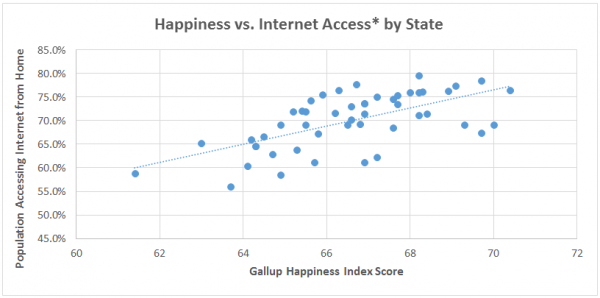
*Percentage of population accessing the Internet from their home
The R-square statistic for this linear regression is .38. This means, on average, 38 percent of the happiness score can be explained by the internet access percentage.
This is a correlation, not a causation. Of course there are other factors influencing this data. Many things effect a person’s happiness. Does this correlation occur because a high Internet access rate signifies a strong economic infrastructure, which could be conducive to happy people? Questions like that require more study and analysis. But, we can say that although Internet access doesn’t necessarily cause happiness, the two are related.
We explored the relationship further by using the Happiness Index Score and the Internet Access percentages to rank states from one to fifty, and then compared the two rankings. This helped us see the relationship more clearly on a state by state level.
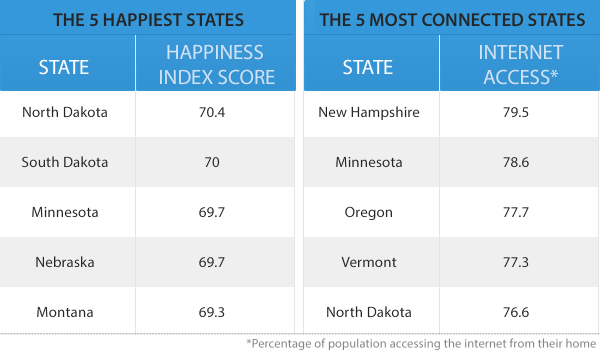
As you can see, North Dakota and Minnesota ranked highly on both lists. South Dakota, Minnesota, and Nebraska all ranked highly on the happiness list but not on the Internet access list, while Oregon did just the opposite. These four state were among only eight total states with a differential of 20 or more in their ranking between the two lists.
Having half of the observations that buck the trend show up in the top five suggests the correlation is weaker among states reporting the highest levels of happiness.
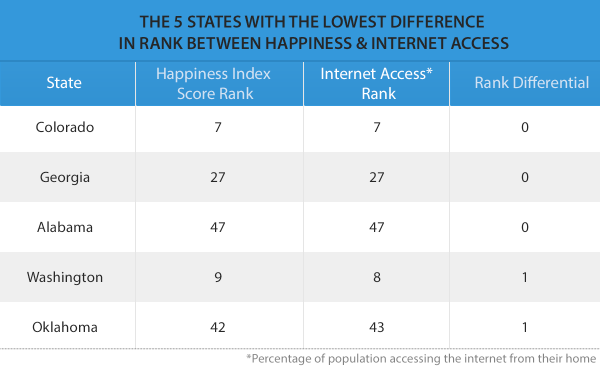
Despite the correlation weakening slightly at the top end, three states ranked exactly the same on both lists: Colorado (7), Georgia (27), and Alabama (47). Two more states were only one number off between the two rankings. Twenty-three states were within five spots on both lists and 33 states were within 10 spots. As mentioned earlier, only eight states were 20 or more positions away between the two lists.
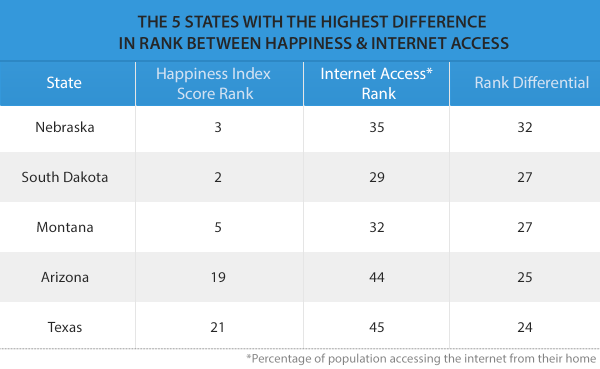
High levels of differentials suggest weaker correlation between happiness and Internet access among these states. This could be caused by any number of reasons. Perhaps people in these states define happiness differently than others, or they might access the Internet from places other than their homes.
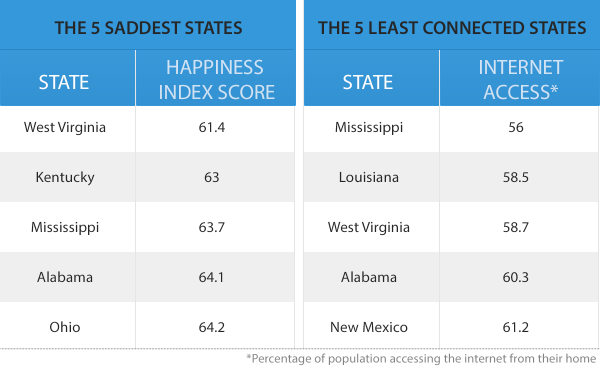
West Virginia, Mississippi, and Alabama all show up on the bottom of both lists. This shows a strong level of correlation in the lack of Internet access and the lack of happiness. Again, this is due to outside factors influencing both metrics.
What does it all mean?
This correlation is not one-to-one. Of the eight states that showed high (20 or more) differentials in their rankings comparison, five (South Dakota, Nebraska, Montana, Arizona, and Texas) showed a far greater degree of happiness than would be expected by their Internet Access Rank. With the other three states (Connecticut, Idaho, and Oregon) we would have expected to see a higher happiness ranking based on their Internet Access Rank.
Despite these outliers, statistically significant evidence exists to conclude, in general, people who live in a state with a higher percentage of its population accessing the Internet from home report being happier than those living in states with a lower percentage of the population accessing the Internet from home.
Does this mean that investing in Internet infrastructure can create happier people? Only time will tell.

Photo credit: kurhan/Shutterstock
This post original appeared at highspeedinternet.com
-

Closing the time to protection gap with threat forecasting
Publié: mars 10, 2014, 12:47pm CET par John Pirc

The dominant theme at this year’s RSA Conference in San Francisco was actionable security intelligence, a term which can mean different things to different people. For example, do bad IP addresses, DNS fast fluxing information, and geolocation constitute security intelligence? Additionally, do malware campaigns and adversary tracking count as security intelligence?
The answer is yes for both questions, but it is important to note that these are not the only high-level indicators that can be considered security intelligence. The key challenge is understanding how to "apply" security intelligence in such a way that it is actionable. The following may be considered provocative and even go against the grain of opinion in Silicon Valley: In most approaches to security, there is too much emphasis on the adversary and not enough on understanding the attack surface.

Pirc’s Law of Adversarial Disruption
The image above visually represents Pirc’s Law of Adversarial Disruption (is based on the Law of Disruption), which is my assertion that there is a rapidly expanding innovation gap between the adversary and traditional product-based security best practices. Further, this gap can only be disrupted by the application of new data-driven approaches that provide enterprises with actionable security intelligence and better visibility into their unique risk profiles. This is a key issue that security professionals face in our race to keep up with the adversary. Over time, cyber criminals have been able to re-invent themselves due to increased connectivity, social engineering, and the various applications that enable them to conduct campaigns and operations against a multitude of targets across every industry vertical. The security industry is preoccupied with the adversary and some believe that taking out a cyber criminal’s supply chain or trying to build a better version of "Anonymous" through white hat cyber vigilante groups will solve the problem. These tactics may help, but they won’t solve the problem. Attribution and traceability will eventually catch cyber criminals, but once their methods of attribution are uncovered, cyber criminals will move on to something more advanced. That amounts to a lot of work for little gain and also takes the focus off defending assets.
I’ve yet to attend a security conference where I haven’t heard the quote from Sun Tzu’s Art of War: "Know thy Enemy". After years of focusing on the threat landscape, there is still one thing we need to know better than the enemy… ourselves. You can’t properly defend your infrastructure if you are not intimately familiar with your attack surface, and few enterprises fully understand the full scope of the attack surfaces within their own organizations. Enterprises continue to buy and deploy tier 1 security products (antivirus, NGFW, IPS, SWG, SIEM, etc.) because these products are listed as security best practices. In order to defend against most of today’s threats, we first have to know what they are, and then we have to propagate that information across various security products. Some security vendors are quick to respond, while others are not so quick. This, however, is a shotgun approach to security that will likely solve only about 70 percent of an enterprise’s risk. Enterprises definitely need these technologies, but what about the other ~30 percent? This is where actionable intelligence can be used to offset the risk in the change window indicated in the image. We can never be 100 percent risk free, but by utilizing actionable security intelligence, we can begin to close the gap of time to protection and disrupt the adversary.
Threat Forecasting
We must take a sniper’s approach to identifying risk and closing the gaps. This requires a move from static risk analysis to variable risk analysis. How does variable risk analysis apply to threat forecasting? It removes the ambiguity and reduces the signal-to-noise ratio by tailoring security that is prescriptive to a specific environment. First, threat forecasting requires an in-depth understanding of your attack surface. The ability to clearly identify your attack surface is a fundamental of good security hygiene: again, how can you defend what you don’t know? Further, threat forecasting utilizes threat intelligence about known and unknown exploits and malware and maps it to your attack surface.
At this point, we have a lot of information, but it still only provides half the picture, and it’s difficult to discern what is actionable. To close the gap and understand which threats are a clear and present danger to your organization, you must be able to identify which of the possible threats targeting your attack surface are capable of bypassing the security products deployed in your network. Once you have this knowledge, you will have actionable and prescriptive intelligence that will not only reduce the time-to-protection gap, but will also greatly reduce risk.
This is a quick overview of the power of threat forecasting and the impact actionable security intelligence can have on your overall security efficacy.
Call to Action
As security professionals we need to challenge the status quo of security best practices. Additionally, we need to close the gap on time to protection by utilizing actionable security intelligence that matches our attack surface. Without any changes, we will continue to be like lemmings marching off a cliff.
Image Credit: watcharakun/Shutterstock
 NSS Labs' Chief Technology Officer, John Pirc is a noted security intelligence and cybercrime expert, an author and a renowned speaker, with more than 15 years of experience across all areas of security. The co-author of two books, "Blackhatonomics: An Inside Look at the Economics of Cybercrime" and "Cyber Crime and Espionage", Pirc has been named a security thought leader from the SANS Institute and speaks at top tier security conferences worldwide. Pirc’s extensive expertise in the security field includes roles in cybersecurity research and development for the Central Intelligence Agency, Chief Technology Officer at CSG LTD, Product Manager at Cisco, Product Line Executive for Security Products at IBM Internet Security Systems, Director of McAfee's Network Defense Business Unit and, most recently, Director of Security Intelligence at HP Enterprise Security Products, where he led the strategy for next generation security products.
NSS Labs' Chief Technology Officer, John Pirc is a noted security intelligence and cybercrime expert, an author and a renowned speaker, with more than 15 years of experience across all areas of security. The co-author of two books, "Blackhatonomics: An Inside Look at the Economics of Cybercrime" and "Cyber Crime and Espionage", Pirc has been named a security thought leader from the SANS Institute and speaks at top tier security conferences worldwide. Pirc’s extensive expertise in the security field includes roles in cybersecurity research and development for the Central Intelligence Agency, Chief Technology Officer at CSG LTD, Product Manager at Cisco, Product Line Executive for Security Products at IBM Internet Security Systems, Director of McAfee's Network Defense Business Unit and, most recently, Director of Security Intelligence at HP Enterprise Security Products, where he led the strategy for next generation security products. -

Xbox One suffering from a worrying controller disconnect issue
Publié: décembre 5, 2013, 8:20pm CET par Robert Johnson
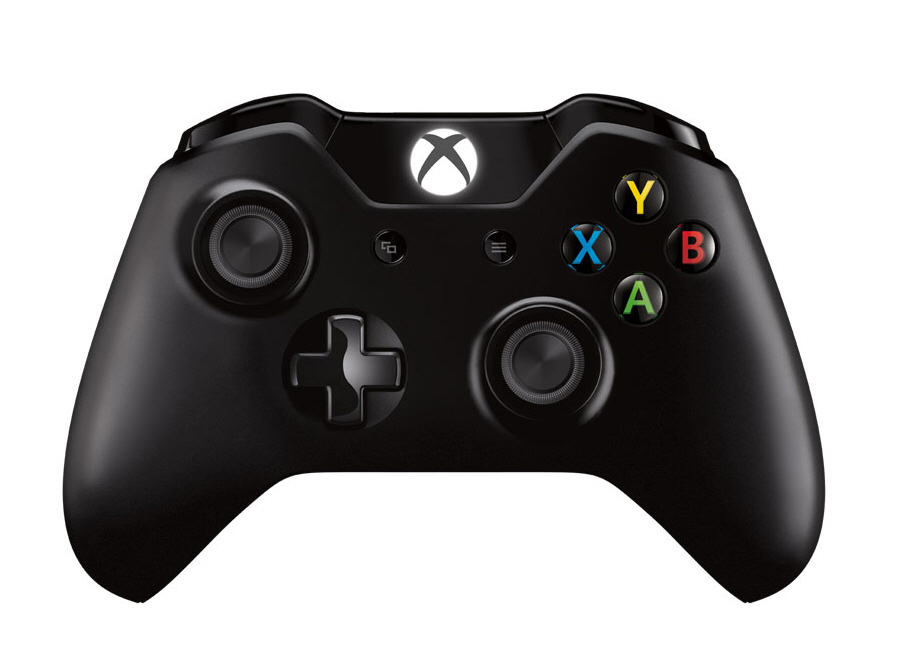
I like to consider myself to be pretty reasonable when it comes to my technology choices. Being an enthusiast, I choose my tech based on how much I think it can improve my way of living, not because I'm an Apple fanboy or inherently biased against Microsoft, or vice versa. But everything changes when it comes to the Xbox. I am a true fanboy and I'm not ashamed to admit it.
In case you've been living under a rock, Sony and Microsoft released the latest editions of their popular gaming consoles, the PlayStation 4 and the Xbox One. I purchased my day one edition of the Xbox One and was pretty excited to unpack it and get everything setup. Admittedly I was a little nervous after hearing about some of the show stopping issues Sony was having with consoles being dead on arrival and other massive issues plaguing the PlayStation Network. Particularly as the Xbox One hasn't escaped unscathed as users report numerous issues with their consoles, the biggest of which seems to be faulty disc drives. Microsoft has gone on record about this issue and has worked hard to quickly replace these devices. However, the tech giant hasn't said a single word about a host of other issues users are experiencing; one in particular that is gaining momentum on the official Xbox Forum concerns a controller disconnect problem. This is an issue I've personally experienced.
Thinking it was only a problem with the individual controller, I went to my local Gamestop and purchased two more only to find that they too had the exact same problem. The fact that the Xbox support site already had a couple of support pages about this matter (keep in mind, this is still day one, 11/22) made me a little nervous that this may be a bigger problem. The forums confirmed my suspicion. On day one there were two pages of users complaining about the problem and offering suggestions on how to fix it. At the time of this writing, there are 19 pages of complaints and attempted solutions.
Microsoft's suggested fixes include the typical restarting the console, syncing via USB cable, and removing objects that are between the wireless controller and the console, such as microwave ovens, shelving units, doors on an entertainment cabinet and wireless routers. Ultimately none of this appears to solve the problem for users like myself.
Microsoft to its credit is quickly replacing consoles (even faster if it places a $500 hold on your credit card). User HotTubMan writes:
"I've had the same problem. My day one controller disconnects almost constantly. I bought another controller and that disconnected too. It took five minutes for Microsoft to replace my Xbox. They took care of me, and they are sending my replacement and having me send the defected one back in the same box. I am very pleased with their support".
But does this ultimately fix the problem? Not for user hillhilly:
"I received my replacement console and at first I thought that the problem was gone but then the dropouts started again".
Same goes for user TheSTuFForD, except his got worse:
"…after being stoked about my replacement Xbox being here... The new console, does not have the wireless controller issue, but after spending a couple of hours installing games my drive stopped working".
There doesn't seem to be a solution to this issue other than getting the console replaced and crossing your fingers that the new console is not hosed in some way.
What Now?
I really have enjoyed using my Xbox One and I think it has tremendous potential as it has radically altered the way I watch casual TV programming and most importantly football. More on that in my full review coming soon. However, the controller disconnect issue has made it difficult to play the games I've been looking forward to playing for some time. My temporary solution is to connect the controller to the console through USB. But this is not ideal nor preferred.
The fact that Microsoft hasn't said whether or not it plans to issue an update to address this and other issues before Christmas has me wondering if I should recommend that friends and family hold off on getting a console or not. I realize (I hope) this issue only affects a small segment of the Xbox One user base. Until we know for sure whether or not Microsoft intends to address this before Christmas I have a couple of recommendations for potential buyers and those who have already purchased the console as a Christmas gift.
For Potential Buyers
If you're still in the market for a console and are definitely wanting to purchase a Xbox One please be aware of the issues users like myself are experiencing. Make sure you have a backup plan in the event that something is wrong with your console. You can get a pretty good idea of the issues on xboxfeedback.com. This site also includes some suggestions to Microsoft on ways it can improve the Xbox One experience.
Keep in mind, that many (if not most) users of the Xbox One haven't had a problem with their console or accessories. Things have worked quite flawlessly for them. I know people who haven't had a single issue.
What to Do If You've Purchased One for Christmas
If you've already purchased a Xbox One as a Christmas gift, here's my recommendation. Set it up, and make sure everything works. Make sure you also have a backup plan and know who to call quickly if something goes wrong. Be sure to register your console at myservice.xbox.com. This doesn't mean something won't go wrong eventually, but at least it offers a little peace of mind that Christmas day won't be a complete disaster.
A guy at my gym told me he stood outside a Best Buy in frigid cold weather on launch day to get a console for his kid for Christmas day. He told his son that all the consoles were sold out and that he would not have his Xbox One by Christmas. Can you imagine his son's surprise when he unwraps his gift and sees the Xbox One logo? Now, imagine his dad's surprise when he sets it up on Christmas day only to discover the disc drive is hosed or the controllers disconnect every six seconds. Hopefully that won't happen as I suggested he follow the same recommendation above.
Do you have a Xbox One? If so, how has your experience been?
-

Crossing the hacktivism line
Publié: octobre 18, 2013, 11:27am CEST par John Pirc

Recently, I was a guest on the CNBC program, Squawk on the Street. The discussion centered on the possible outcome of a limited strike by the US on Syria, and I had the opportunity to provide my opinion on the retaliatory cyber implications for US interests. During the program, I disagreed strongly with the position taken by McAfee Worldwide CTO, Mike Fey: that the Syrian Electronic Army is no more than a hacktivist group. In my opinion, this is a dangerous assertion based on industry group-think and marketing rhetoric.
Two books that I have co-authored have examined attack sophistication in terms of categorizing a threat actor. Ultimately, I am not concerned with which organization or entity carries out an attack. I am, however, concerned with identifying and stopping malicious activity. For example, were a nation-state to engage in industrial espionage against a defense industrial-based contracting firm or critical infrastructure, such as a power grid, this typically would be classified as advanced persistent threat (APT).
At NSS, we would more accurately describe it as a targeted persistent attack, since the APT refers to a specific nation-state. Any individual or group with the right connections and with sufficient funding (from, for example, a nation-state or a cyber crime organization) will have access to the same sophisticated, weaponized exploitation kits that are used by government organizations. This has made it much more difficult to accurately categorize threat actors.
With hacktivism, however, it is somewhat easier to classify the threat actor. A hacktivist message or a hacktivist’s defacement of a website will offer clues regarding attacker identity, and, since the purpose of activism is to draw attention to oneself and one’s cause, the attackers will discuss their operations on Twitter and other social media. Furthermore, a hacktivist group will also claim responsibility for an operation once it has been successfully executed. A hacktivist operation typically involves a distributed denial-of-service (DDoS) attack. Hacktivists will deface websites; hack into organizations, stealing information such as usernames and passwords, or emails, which they publish on public websites. Whatever the motivation behind such "operations," their activities are disruptive and embarrassing for the victims, and the resulting public fall-out financially impacts their brands.
In my opinion, the Syrian Electronic Army (SEA) poses a viable and significant threat against US interests. By incorrectly labeling the group as a "hacktivist" organization, the industry has marginalized this threat. A group that is capable of conducting successful operations against high-profile media sites is a group that is capable of sophisticated attacks against highly visible and presumably well-defended targets.
However, since the media did not consider this attack "disruptive," it was marginalized. Consider this: the SEA’s take-down of a high profile media site could just as easily have been a take-down of an online banking site or an online retail site. The ability to affect how a company conducts transactions and thus makes money is the ability to affect its bottom line. But no big deal, let’s just chalk this up to "hacktivism", right?
I think not. If a large retail organization were to be taken offline during the holiday shopping season, the repercussions would be far-reaching, and I am quite certain the organization would consider this a big deal.
When did the SEA graduate from hacktivism? I’d say right after they hacked the AP Twitter account and caused the stock market to fluctuate in less than 140 characters. Their fake news alert was an operation that did undermine the US economy.
Attempting to place threat actors in neatly defined categories is difficult and not altogether wise. That said, let’s examine a few definitions.
Hacktivism: "The practice of gaining unauthorized access to a computer system and carrying out various disruptive actions as a means of achieving political or social goals".
Terrorism: "The unlawful use or threatened use of force or violence by a person or an organized group against people or property with the intention of intimidating or coercing societies or governments, often for ideological or political reasons".
Cyber Warfare: "Cyber warfare involves the actions by a nation-state or international organization to attack and attempt to damage another nation's computers or information networks".
On the strength of these definitions, I would rule out the SEA as a hacktivist group. I would, however, propose that the SEA falls into both the "terrorism" and "cyber warfare" categories, or at least that it lies somewhere in between, perhaps a combination of the two -- a category we could refer to as "guerilla cyber warfare".
Classifications aside, what we should not do is marginalize a group’s capabilities. This will affect the way we protect critical systems against groups that "cross over" from hacktivism to operations that are well-defined. Terrorism and cyber warfare can have catastrophic consequences for the US and its interests, or for any other country. Would an infrastructure be defended differently if it was known to be the target of cyber warfare or terrorism? I would hope the answer is a resounding "yes".
As security experts, it’s our job to protect infrastructures against cyber threats, regardless of the identities of the threat actors -- they only need to get it right once, we have to get it right every time.
Image Credit: lolloj/Shutterstock
 NSS Labs Research Vice President John Pirc is a noted security intelligence and cybercrime expert, an author and a renowned speaker, with more than 15 years of experience across all areas of security. The co-author of two books, “Blackhatonomics: An Inside Look at the Economics of Cybercrime” and “Cyber Crime and Espionage”, Pirc has been named a security thought leader from the SANS Institute and speaks at top tier security conferences worldwide.
NSS Labs Research Vice President John Pirc is a noted security intelligence and cybercrime expert, an author and a renowned speaker, with more than 15 years of experience across all areas of security. The co-author of two books, “Blackhatonomics: An Inside Look at the Economics of Cybercrime” and “Cyber Crime and Espionage”, Pirc has been named a security thought leader from the SANS Institute and speaks at top tier security conferences worldwide.Pirc’s extensive expertise in the security field includes roles in cybersecurity research and development for the Central Intelligence Agency, Chief Technology Officer at CSG LTD, Product Manager at Cisco, Product Line Executive for Security Products at IBM Internet Security Systems, Director of McAfee's Network Defense Business Unit and, most recently, Director of Security Intelligence at HP Enterprise Security Products, where he led the strategy for next generation security products.
-

Microsoft needs someone from the outside
Publié: août 24, 2013, 1:02am CEST par Robert Johnson
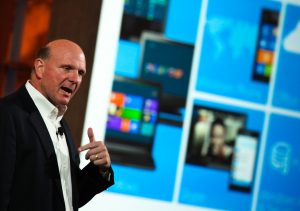 Like many, I was caught off guard by the news of Steve Ballmer's early retirement. Until the crash of Surface and Windows 8, I had assumed he would be there until at least 2017/18. But with Microsoft's recent stumbles in its transition to mobile devices I had a sneaky suspicion he might not make it to 2017.
Like many, I was caught off guard by the news of Steve Ballmer's early retirement. Until the crash of Surface and Windows 8, I had assumed he would be there until at least 2017/18. But with Microsoft's recent stumbles in its transition to mobile devices I had a sneaky suspicion he might not make it to 2017.Before Microsoft's unveiling of Windows 8 and the company's new consumer strategy I was not a big fan of Ballmer as CEO. I was among the many who felt Microsoft needed to make a change at the top. However, once I began to see the consumer strategy come together I started to have a change of heart about him, although I was never quite 100 percent in his camp because of the obvious missteps in recent months.
So what does the search committee have to do to find a replacement? As I look at the current leadership of the company, no immediate successor comes to mind. Personally, I believe that's a good thing. I typically prefer corporations to hire from within because there's so much value in the knowledge of a company gained by someone who has been there. This person understands the culture and the way the firm works. It is for this very reason, however, I believe Microsoft needs to hire someone from the outside; someone who is not a former Microsoftie.
The tech giant needs fresh eyes. It needs someone who can bring fresh thinking to the company, someone with a solid understanding of consumer culture in today's mobile computing milieu. Ballmer has made huge mistakes and has recovered from some of those mistakes quite well. His replacement should have a track record of the same. Microsoft needs someone with the guts to make bold decisions that will get the company on a faster track to revolutionizing the way consumers use computing devices.
My pick for Ballmer's replacement is probably not on anyone's short list (or long one) but something tells me this person would be a great fit to breathe fresh air into the company. While he doesn't appear to have much experience in the hardware arena, he does come with a solid track record in building a consumer company (failures and successes). He has an understanding of how Microsoft runs its business so he's somewhat of a safe bet. My pick is Reed Hastings of Netflix.
Am I crazy? Yes. And I'm perfectly okay with that. I also think Reed is crazy too but in a good way. Microsoft needs a certain kind of crazy to push the company into the future. Ballmer's version of crazy is what took it from a $22 billion dollar per year company to a $77 billion dollar per year company. And now a new kind of crazy is needed to push Microsoft even higher.
So what do you think about my pick? Who do you think is a possible successor?
-

Five things Microsoft is doing wrong
Publié: juillet 28, 2013, 8:36am CEST par Robert Johnson
 Microsoft is one of the largest tech companies on the planet. The multi-billion dollar devices and services company employs some of the most brightest scientists, software engineers and designers on the planet. It has demonstrated its ability to create some of the most compelling technologies in the market. Yesterday I discussed the five things I think the company is doing right.
Microsoft is one of the largest tech companies on the planet. The multi-billion dollar devices and services company employs some of the most brightest scientists, software engineers and designers on the planet. It has demonstrated its ability to create some of the most compelling technologies in the market. Yesterday I discussed the five things I think the company is doing right.But it's not all good for Microsoft, and there are plenty of questions need asking. Why, for example, is its mobile strategy sucking wind? Why is its web browser, one of the single most important pieces on a computing device these days, struggling to keep pace with other browsers in standards compliance and end user features? In this post I will focus on five areas where I think Microsoft is missing the boat.
Internet Explorer
I have a love/hate relationship with Internet Explorer. I love the fact that Microsoft is actively engaged with the development community to change the negative perception of this browser and I love the experience of using it in touch mode on a touch device. However, I pretty much hate everything else about it, especially its desktop counterpart. Tab syncing should have been in IE with version 10. And why can’t I at least send my browsing session from my PC to my phone (and vice versa) in the interim?
From a development perspective there is a lot of damage that has been done to the image of IE and Microsoft has no one to blame but itself: slow updates to standards compliance being chief among them. Even though Internet Explorer is being updated on a more rapid schedule (yearly it seems), standards are moving at such a blistering pace (although approval is slow) there needs to be more frequent updates so developers can test and push the envelope. From an end user perspective, IE is just now getting key features that have existed in other browsers for almost a year. There’s no real reason why we cannot see the same rendering engine across all Windows devices (including Windows Phone) and the Xbox 360/One before the end of 2013. IE has a ton of catching up left to do.
Natural User Interface Strategy (NUI)
I’m a firm believe that when entering a market that is already established, it’s a good idea to enter in such a way that you leap past the major players. When Microsoft entered today’s mobile market with Windows Phone back in October 2010, it needed a strong way to differentiate itself, get the attention of consumers and entice them to purchase Windows Phone.
For various reasons, this didn’t happen. Perhaps Microsoft relied on brand recognition and assumed that consumers would buy Windows Phone just because Microsoft created it. Unfortunately by that point, Microsoft had lost so much mobile mindshare to Apple and Google, there was no way that plan would work. How about that snazzy new UI as a differentiator? It’s certainly different, but proved that it was not enough to cause the masses to salivate over Windows Phone.
Something tells me the same mistake is being made with Windows 8. The new Windows UI is such a strong differentiator, perhaps consumers don’t know what to make of it and at first glance it probably feels so unfamiliar to them that the curb appeal is simply not enough to boost sales.
So how does Microsoft get the attention of consumers and boost sales of its devices? How can it overcome the little to no mindshare it has when it comes to mobile devices? I believe the tech giant needs a compelling feature that will differentiate its devices from the competition. Baking natural user interface technology into phones, tablets, laptops and monitors will leap Windows devices ahead of the competition and get the attention of the general public.
If you’ve been reading my stories long enough you'll know this is one area that I continually push for Microsoft to expand its efforts. I am convinced that one of the primary reasons (not the only reason) the Xbox 360 pushed ahead in sales numbers was because the introduction of Kinect changed the conversation in terms of how people interacted with video games and their television. Who cares if they mostly sit unused right now? The bottom line is that this technology got people’s attention and actually made their lives a little bit better although in small ways. With the Xbox One, Microsoft has taken this technology to new levels. All the data it has been collecting since November 2011 when Kinect first launched has helped to improve Kinect dramatically.
So why are we only seeing it in the Xbox One, and as a small feature of the cooking app in the Windows 8.1 preview? Microsoft can make fun of Siri all it wants in its iPad comparison commercials, but is has absolutely nothing to show for a feature that I am seeing more and more people use on their iPhones. Nothing.
Microsoft has the technology. It has the resources. It has the data. It has posted videos on YouTube demoing its Siri response, but it has produced no real answer. Apple and Google are not sitting on their laurels in this area. They are moving quickly to make interacting with their devices through talk better than ever.
Users can use speech to interact with Windows Phone and dictate text messages. There’s even the ability to do voice searches. But this functionality is nowhere near as good as Siri or Google Now. Microsoft needs to get its NUI act together and it needs to do it yesterday.
The Mobile Strategy
Apple had a pretty nice quarter with iPhone sales. And Samsung is looking like it will see an increase in phone sales as well. Microsoft? Well, that’s another story. Windows Phone is growing, but very slowly and not even near fast enough. Interest in tablets took a dive this past quarter. Put it all together and you have a very bleak situation for mobile devices from Microsoft. There’s not a lot to be excited about. No one seems to want these devices. As good as the Surface is the RT version is not selling very well and the $900 million inventory hit to Microsoft’s bottom line proves this point.
This will continue to be an area of pain for this company unless it figures out a way to get out ahead of the competition through device and UI innovation (NUI), and greatly improve how it communicates why consumers should purchase Windows devices instead of Apple or Android.
The Windows Phone update policy is pure madness. It’s not as bad as Android, but it’s not anywhere near as good as iPhone. It amazes me that this company cannot get updates out to all devices at the same time. I understand there are a myriad of Windows Phone device types among different carriers. But there’s no way to coordinate that any better than what we get now? Why is update 2 going out to only one type of device on one carrier?
Communication
When Microsoft launched Windows 8 it probably had the worst messaging a company could ever have when introducing new versions of a product with radical hardware and a completely overhauled UI. I didn’t mind the original Surface commercials with the dancing Surface users. I thought it was a great way to introduce us to a brand new product; but only for a few weeks. Why that campaign ran as long as it did is beyond me. I kept asking myself, why should people purchase the Surface? Is it only because it has a keyboard? Remember those Windows 8 commercials at launch? They were very similar. There was nothing that really explained why it was better than before and why consumers should go out and buy Windows machines. Although communication is getting better, there’s still more to do.
The problem with the original Surface and Windows advertising campaign is that they didn’t focus on features as well as they should. With an interface as radically different as Windows 8, there should have been a ton of messaging centered around how Windows 8 can actually improve our quality of life. Don’t just show kids pointing at touch screens or menus swiping from the side of the screen, show me how all my content goes with me everywhere. Show me how I can benefit from the built-in apps like the new cooking app. Show me how the new cooking app is really beneficial when I am baking a cake and I can’t touch my screen with my dirty hands but with something as simple as a swipe, I can navigate through the recipe. These are the things that can actually improve quality of life albeit in small ways. Tell me why my next purchase should be a Samsung ultrabook and not a Macbook Air.
Bing. I really like the Bing commercials, but perhaps it’s time to start keying in on the sidebar in some new advertising. There are times when I look for someone on Facebook and I cannot find them. So I type their name into Bing, and their Facebook profile shows up. I did this exact thing a week ago. Bing has the ability to mine lots of different sources for information which allows it to return data that Google can’t even come close to. Microsoft should be talking about that.
SkyDrive and Outlook commercials are cute. But people really don’t know that you can actually use Word, PowerPoint and Excel online for free. People don’t know that they can create documents in these programs right within SkyDrive, save them, and have them magically appear on phone, tablet, or PC. Tell me why I need to ditch Gmail and move everything solely to Outlook. Explain why SkyDrive is better for me than Dropbox.
The Xbox One fiasco was shocking. I’ll just leave it at that and say that I hope Microsoft learned its lesson.
As we transition into a new era of computing, it is absolutely essential that Microsoft’s messaging is flawless. There is no room for error when you are struggling to sell devices. No more cute commercials of dancing schoolgirls. Sell us on the features and pricing.
Windows/Surface RT
For well over a decade, Windows users were accustomed to clicking a small little start button at the bottom left of their screen to access all their applications and in some instances documents. Windows 8 changed all that. Many of you lost your cool and consumers the world over had problems with it too. But the start button wasn’t the only issue with Windows 8. The touch interface was better suited for touch devices, which almost all existing Windows users did not own.
So what happens when existing Windows users install Windows 8 on old hardware? Disaster. Of all the complaints I’ve had from Windows 8 users, they have all been because someone installed it on hardware not designed for it. Microsoft tried to make using the new OS mouse/keyboard friendly but users still complained. For those that had modern devices, they had a much better experience.
Switching between the new UI and the familiar desktop interface was another source of pain as many complained that the experience was too jarring. Microsoft is addressing this problem in 8.1 by allowing users to install the same background image for desktop and Start screen modes. I wish Microsoft would go much further and actually redesign the desktop to look much more similar to the new Windows UI design language. Perhaps this is in the works.
It’s good that Microsoft is finally addressing these issues but something tells me this may not be enough to get people’s attention. The perception of Windows 8 is not very good right now. Microsoft needs features and hardware that will get the attention of consumers and get them in the stores buying Windows devices.
One of the biggest "what the hell" situations right now exists with Windows RT and its desktop mode. Microsoft needs to do much more here. Why is it still there? If the goal is to eventually allow full blown desktop use, this needs to be communicated sooner rather than later. At this time we know nothing. All we can do is speculate that the reason for the desktop is because of Office. If indeed Windows RT is a glimpse into the future of Windows, the BUILD conference would have been a great time to communicate about the future of RT. Consider that boat missed.
Not only does Microsoft need to address the usability concerns, it needs to get Windows 8 onto better hardware and fast. The launch quality (and quantity) from Windows hardware partners was lackluster. The only option I could recommend to friends in the market for a new machine was the Surface and even then I had some reservations. I use Surface RT and I find it a very capable device for content creation and consumption. I plan on purchasing the next version of the Surface Pro if Microsoft can solve the battery life problem. OEMs need to get their act together. Microsoft needs to aggressively expand the Surface accessory line with a new docking solution.
A big problem with Windows devices right now is pricing. Hopefully with the launch of 8.1 we will begin to see small devices around 7-8 inch size that are competitively priced. The new Surface RT price is what I feel the device should have been introduced at. Microsoft would have lost a ton of money per device, but at least there could potentially be several million devices out there providing free advertising. Microsoft needs to get as many of these devices into the hands of as many people as possible. Techies can gripe and moan about performance and screen resolution all day long, what regular users care about is whether or not they can check Facebook and write a paper for class.
Slow sales of Windows 8 and Surface are a collection of poor device selection, poor messaging, usability problems, and pricing. Do slow Surface sales imply people don’t want tablets or that tablets are not PC’s? I don’t think so. Microsoft should not give up. It needs to stay the course because it has some really compelling experiences to offer consumers.
Conclusion
Microsoft gets a lot of undeserved negative criticism. But there are some areas where the negativity and angst towards the tech giant is very much warranted. I picked five areas: Internet Explorer, Natural User Interface (NUI), Mobile Strategy, Communications, Windows/Surface.
You may have additional areas where you think Microsoft is getting it wrong. I’d love to hear your thoughts.
Photo Credit: Arcady/Shutterstock
-

Five things Microsoft is doing right
Publié: juillet 27, 2013, 11:28am CEST par Robert Johnson
 It’s really easy to pick Microsoft apart and find reasons to hate the company. The software giant has spent years making decisions that gave the tech press and writers like myself reason to negatively criticize everything it does.
It’s really easy to pick Microsoft apart and find reasons to hate the company. The software giant has spent years making decisions that gave the tech press and writers like myself reason to negatively criticize everything it does.Microsoft has its problems, sure, but not everything suggests it's dead in the water. The firm has made some pretty bold bets recently; bets that I think are actually good and signal the arrival of a different Microsoft than the one we're all accustomed to kicking in the teeth. Here’s five things I think Microsoft is getting right.
Product Integration
One of the most exciting things about Windows 8/8.1 is the integration of so many different Microsoft services into one environment. Xbox Games/Music/Video, Bing, SkyDrive, and Skype are all nicely integrated. Even though I am a tech enthusiast, I tend to use and evaluate my gadgets more like a consumer. People who are more "techie" will evaluate things on a completely different level and most likely will form a different opinion than me.
I have been using Windows 8 since day one. While I have not really enjoyed the Xbox experience on my devices (the music service has improved but is still really bad), I love the fact that it’s easier for me to share videos/photos to my living room TV from the PC in my office or from my Surface. Having access to all my Office 365 related content and documents through SkyDrive makes my life much easier. The good news is that all of this is getting significantly better with 8.1.
I’ve had "techies" tell me how much they hate Windows 8 and they fire off a list of reasons that all have to do with the deep technical underpinning of the OS, in other words, lots of things I don’t use, care about or understand and most "consumers" don't either.
Overall, having access to all my music, photos, and documents across my devices meets a very big need for a guy like myself who is always on the go and constantly working.
Rapid Product Update Cycles
In case you haven’t noticed, Windows 8.1 is arriving less than a year after Windows 8 released. That’s quite fast for an operating system of that size. It’s not just Windows getting the rapid updates. Developer tools like Visual Studio and services like Azure are updated quarterly and even monthly in some instances. Bing and SkyDrive receive regular updates and the Xbox division is improving Xbox Music and Video through regular bug fixes and small feature updates.
These rapid updates will allow the company to respond faster to market changes as well as allow it to play catch up to competitors in key areas like web browser innovation and smartphones. Yes, I know we’re still early in the mobile wars, but Microsoft has to get Windows Phone up to par with competitors as soon as possible. Microsoft is betting the farm on its cloud efforts and the blazing speed at which Azure is adding new features and growing customers is nothing short of impressive. Azure could one day be the largest cloud on the planet if Microsoft plays its cards right. Key to that success is getting the attention of the anti-Microsoft Silicon Valley.
Reorganization
Steve Ballmer announced a sweeping reorganization of the company around its new devices and services strategy. In my personal opinion, it was a good call. The market seemed to agree as the stock price went up.
The company is consolidating around four main engineering areas, OS, Apps, Cloud and Devices. The mantra: One Strategy, One Microsoft. The most notable change, consolidating all major operating systems under one engineering head, seems to be the way the market is headed. Recall that Google and Apple have also done the same thing. Powerful devices that do more and can talk to each other allows for seamless and continuous computing experiences.
Will it work? Time will tell for sure, but for now anything that helps Microsoft quickly improve product integration is a major plus.
Marketing
For years Microsoft marketing efforts have been pretty blah. With the launch of Windows 8 things have changed dramatically. While I was not exactly a fan of the original launch campaign I understand the purpose: to introduce the platform to the masses in a lighthearted and fun way that connects emotionally with consumers. I’ll save details of why that may not have been the best decision for another article about things Microsoft has gotten wrong.
That being said, recent commercials promoting Windows devices are pretty much a slam dunk in my opinion. Why anyone would want to purchase an iPad while capable Windows devices like the Surface Pro exist is beyond me. Yes, I understand the Surface Pro has battery life issues, but the form factor and ability to run millions of Windows applications is a huge selling point over a similarly priced iPad. Hopefully we will see the Surface Pro go up against the iPad in the way the RT version has.
I said in a previous post that Microsoft needed to focus more attention on features of Windows devices in comparison to the iPad like Amazon has done. It has done exactly that in its latest commercials.
Microsoft’s marketing as of late has been pretty aggressive. The Bing advertisements go right for Google’s jugular, encouraging people to try the Bing it On challenge. Regardless of how you feel about Bing, this is the right call by Microsoft.
For years, the company has sat idly by while its biggest competitors have junk punched it. Now, Microsoft is fighting back. It’s about time.
Device Innovation
Windows 8 introduced modern hybrid devices that are both laptop and tablet. The most notable are the Surface devices. RT has its issues and one can argue that it should probably be discontinued. I disagree. It represents the future of an ecosystem that is in complete disarray because of the very thing that has made it the most popular OS on the planet: openness. I don’t know the plans Microsoft has for RT but you don’t have to use it for very long to see that it has a lot of maturing to do.
We are trending towards a future where people want fewer devices that do more. Hybrid devices may not be flying off the shelves right now, but they certainly represent what I have previously argued is the future of computing. Take the Surface Pro for example. I can install Adobe Creative Cloud, connect a mouse and get work done. Then when I’m ready to watch Game of Thrones, I can literally take the same device and sit on my couch and consume second screen content from the show. And if I need to pause the show and get some creative work done really quickly, I can do that. What’s not to love about that? It’s one device. I didn’t have to purchase two devices to get work done, a laptop/desktop computer and a tablet.
People want simpler technology. They want fewer devices. All you have to do is look at what Microsoft is building in the Xbox One to see that the trend is toward consolidation. You can call Windows 8 a jeckyl and hyde OS all you want, the bottom line is, one operating system that lets me consume and create is a really good idea. We can debate about the execution, but what I believe most need to keep in mind is, we’re still early in the world of mobile. Wearable computing will be quite huge and according to the 2013 Internet Trends Report, there is still tremendous growth potential in the mobile market for smartphones. There’s no clear winner yet folks.
Conclusion
It’s clear we are entering a third phase (the 2013 Internet Trends report calls it the Third Cycle) of computing as consumers have newer and better options for getting their computing tasks done. Apple iPad, iPod and Mac sales are down (iPhone is up), Google can’t seem to properly monetize Android and no one seems to want Windows devices. This is a turbulent environment that is going through a major transition. Microsoft has made some pretty risky bets with hybrid devices, the Surface, a new Windows UI, and a massive company reorg that some consider rearranging the deckchairs on a sinking ship.
However, I believe Microsoft is poised to take advantage of this new computing environment and has set itself up to be a dominant player in the new world of mobile.
Do you agree or disagree with my list so far? What would you add to this list?
Photo Credit: Arcady/Shutterstock
-

Surface RT takes on the iPad and wins!
Publié: juillet 19, 2013, 8:27pm CEST par Robert Johnson
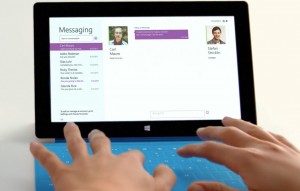 In the wake of the $900 million Surface RT inventory adjustment hit announced yesterday, Microsoft has released an updated ad comparing Surface RT to the Apple iPad. Microsoft warned that its marketing was going to get more aggressive and this ad is probably the strongest attack on the iPad we've seen to date.
In the wake of the $900 million Surface RT inventory adjustment hit announced yesterday, Microsoft has released an updated ad comparing Surface RT to the Apple iPad. Microsoft warned that its marketing was going to get more aggressive and this ad is probably the strongest attack on the iPad we've seen to date.I'm a big fan of ads that focus on features and I am a bigger fan of ads that focus on features against a competing product. This ad is particularly good, not just because of the feature comparison, but the price comparison. See for yourself.
I have long believed that this is the price point at which Microsoft should have released the Surface RT. Sure the company would have lost money, but it needed to get these devices into the hands of as many people as possible as early as possible. Furthermore, the commercials it is running now, are what it should have been running from the start. Surface RT, although it is not without its glaring weaknesses, has the beginnings of being a great product and I for one believe Microsoft should definitely stay the course.
I think this commercial is a slam dunk and I hope everything works out for Microsoft and it can start finally getting these devices into the hands of as many consumers as possible.
What do you think about this commercial? Is it a winner or should Microsoft give up on Surface RT?
-

This is why you dislike Bing
Publié: juillet 18, 2013, 12:32pm CEST par Robert Johnson
 I love Bing. There aren’t many products (Xbox) that I’ll admit to being a fanboy of but Bing is getting pretty close to that status for me. I’m an oddity because most people don’t use Bing at all; either because they’ve used it and didn’t get the results they wanted, or based on word of mouth about it being so terrible. I don’t know where you fall, but I would bet most of you reading this don’t use or even like Bing. That’s unfortunate because you’re missing out.
I love Bing. There aren’t many products (Xbox) that I’ll admit to being a fanboy of but Bing is getting pretty close to that status for me. I’m an oddity because most people don’t use Bing at all; either because they’ve used it and didn’t get the results they wanted, or based on word of mouth about it being so terrible. I don’t know where you fall, but I would bet most of you reading this don’t use or even like Bing. That’s unfortunate because you’re missing out.Yes, Bing is good. But why do so many people hate it? Why do so many googlers refuse to even give it a try? Why do those who actually do give it a try, enter one search query, fail to get the results they want, and go back to Google, never giving Bing a second chance?
In April, SurveyMonkey conducted a study comparing Bing and Google. 641 test participants were given two pages of search results, one with Bing branding and the other Google, and were asked which results they preferred. Participants preferred the Google results.
In another survey 262 participants were given the same results but this time the branding was swapped: Google results labeled Bing and Bing results labeled Google. More people preferred the Bing results labeled Google.
When you look at both studies an interesting thing appears: more people preferred the Bing results labeled Google than the Google results labeled as Google. According to Matt Wallaert of the Bing team:
Before explaining the psychological forces at work here, let me put to rest any concerns of corporate trickery. Bing wasn’t involved in this study in any way. We didn’t even know it was happening until after the results were released, and since Google recently became a prominent investor in SurveyMonkey, it would be hard to argue that SurveyMonkey had a pro-Bing bias. To the best of our understanding from the outside, this was impartial, data-driven research done by an internal team at SurveyMonkey.
He goes on to explain why people chose based on brand rather than quality. The explanation is found in a psychology concept known as confirmation bias. According to the most accurate encyclopedia on the planet (that was a joke), confirmation bias is a "tendency of people to favor information that confirms their hypotheses".
Confirmation bias has to do with how people process information, particularly any way in which people avoid rejecting their assumptions whether they are searching for evidence, interpreting it, or recalling it from memory.
The Search for Evidence
In this bias, people hold a hypothesis which they assume to be true. They test it in such a way that requires an affirmative answer that supports their hypothesis. In other words, they tend to look for the evidence they would expect if their hypothesis were true. For example, if I assume Bing returns bad results, then I would be intentionally looking for all the bad results instead of the good ones.
Interpreting Evidence
In this bias a person will make a judgment call on the evidence to support their original hypothesis. For instance, again, if a person with a "Bing sucks" attitude, arrives at Bing results, they will interpret those results as bad. But if shown the same results labeled as Google, they will interpret them as good.
Recalling Evidence
Information is remembered selectively. That means that when a person has a positive experience with a service they inherently have a negative assumption about (i.e. Bing) they will only remember the ways in which that service provided a negative experience.
So what?
The point I am trying to make is this, perhaps confirmation bias is the reason why Bing is hated by so many people. Regardless of the fact that in some cases Bing still lags behind Google, in pure search results, I can count on one hand in the past two years where Bing has failed me. From the Bing blog:
Think of it this way: have you ever tried using Bing, not found what you wanted, and then immediately went back to using Google because "Google is better at search"? But then when you use Google and it doesn’t give you the right results, you change your search and try again because you "searched wrong", rather than giving Bing a try? That’s the confirmation bias: if you were truly trying to find out which search engine was better, you’d give them an equal chance to give you right and wrong answers.
This happens a lot. I’ve had people tell me that they’ve tried Bing and did not find what they were looking for. But something tells me that they were not looking hard enough because they didn’t overcome their inherent bias against Bing. I understand that Bing is not perfect and still has some growing to do. Remember, Google wasn’t perfect either and it took time for it to grow into what it is today. Bing is innovating at a rapid pace and although I would love to see it add features a little bit quicker, I’m a happy Bing user.
The Solution
My solution to this problem is this. Try Bing for 30 days. In other words, use Bing and nothing else for 30 days; use the maps, local search, general search, images and travel for 30 solid days and let me know how it goes. This is what I did back in 2010, about one year after Bing launched. I decided to give it an honest try. And I haven’t been back to Google since. Yes, I occasionally use Google when I don’t find what I need on Bing, but eventually I will stop using Google altogether because this behavior has not yielded any positive results for me: if I don’t find it on Bing, I typically don’t find it on Google either. Bing is just that good.
Photo Credit: Gajus/Shutterstock
-

Will the Xbox 180 ensure continuing high game prices?
Publié: juin 21, 2013, 9:18am CEST par Robert Johnson
 I’ve been watching Microsoft's handling of the whole DRM, region lock, and used game PR fiasco with interest over the past two weeks, and while I personally did not have any problem with any of those restrictions, many of you did. On June 19, Microsoft did something that seems to have shocked the world: it listened to customer feedback. Despite reportedly strong preorder sales, Microsoft decided to reverse its decision on the always-on internet connection as well as the game rental, resale, and gifting restrictions.
I’ve been watching Microsoft's handling of the whole DRM, region lock, and used game PR fiasco with interest over the past two weeks, and while I personally did not have any problem with any of those restrictions, many of you did. On June 19, Microsoft did something that seems to have shocked the world: it listened to customer feedback. Despite reportedly strong preorder sales, Microsoft decided to reverse its decision on the always-on internet connection as well as the game rental, resale, and gifting restrictions.I personally have mixed feelings about it all. While I applaud Microsoft for listening to its customers, something tells me that in the long run easing up on the game resale industry may not be the best thing for consumers. I’ll explain.
Game prices are way too high. Paying $60 for a game is a bit on the ridiculous side in my opinion. Pushing the industry towards a digital distribution model where resales are non-existent is a great way to drive down the selling price of games. I realize that there are no guarantees that will happen, but it’s certainly a great start until a better strategy comes along.
Microsoft is a smart company, and is definitely firing on all cylinders give or take a few dead spots. I think it is a good thing for it to listen to its customers, but sometimes what consumers want is not always what’s best for them. At any rate, I’m okay with the decision and hope it results in more sales of the new console.
It’s no secret I’m a huge Xbox fan, and I am aware that my fanboyism can get in the way of logic. Do you think this decision keeps game prices at an all-time high?
-

By taking on Apple, Microsoft marketing finally nails it
Publié: mai 24, 2013, 9:08am CEST par Robert Johnson
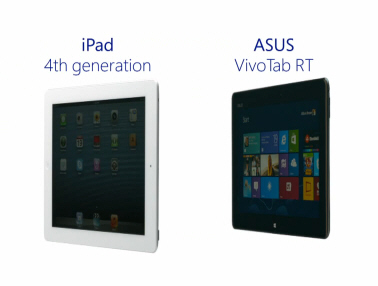 I recently wrote about some strange but awesome Windows 8 ads geared towards the Japanese market. It appeared that people across the internet were pretty down on them as the ads didn’t say anything about the OS. My point in the article was to show that there are different types of advertising and sometimes companies need to get our attention in some pretty unusual ways.
I recently wrote about some strange but awesome Windows 8 ads geared towards the Japanese market. It appeared that people across the internet were pretty down on them as the ads didn’t say anything about the OS. My point in the article was to show that there are different types of advertising and sometimes companies need to get our attention in some pretty unusual ways.I’ve been very critical of Microsoft’s advertising approach with Windows 8 and especially Surface. Although the company has increased the frequency of its advertising and is advertising more of its products, there was one area in particular where it was lacking: a strong focus on features against competitor products. None of this was more apparent than its approach with Windows 8 and Windows tablets. I previously wrote,
I’d still like to see Microsoft focus more specifically on features of these products that make them better than the competition. Take the Surface commercials for example. I absolutely loved the way Microsoft first introduced us to the product: remember the commercial with the dancing school girls? Loved it. And now the company is running a slightly different twist on that with dancing business users to introduce the Surface Pro. Almost six months on the market and all we know about the Surface is that it clicks…and you can dance with it.
Microsoft wasn’t saying much about why the typical consumer should choose the Surface or any Windows 8 mobile device above the iPad. Until now. This week two commercials were uploaded to YouTube. Both completely focus on features and clearly explain why consumers should choose Windows devices over an iPad. One of the ads, which my colleague Wayne Williams looked at yesterday, is quite funny as it uses Siri to take shots at iPad weaknesses, and the other, embedded below, simply pits the iPad against the ASUS VivoTab RT and compares thickness, weight, suitability for work use, multi-tasking, external connections, and the ability to print. Naturally the VivoTab wins hands down.
For those of you who don’t like the fact that Microsoft is taking a dig at Apple, I remind you that this is precisely the approach that Apple took to get attention for Mac OS. Remember the "I’m a Mac" switcher campaign? I thought so.
So what do you think? Is Microsoft on track with these? Will these convince consumers to go out and buy Windows devices?
-

Microsoft's new commercial finally sells the benefits of Surface RT
Publié: mai 17, 2013, 3:21pm CEST par Robert Johnson
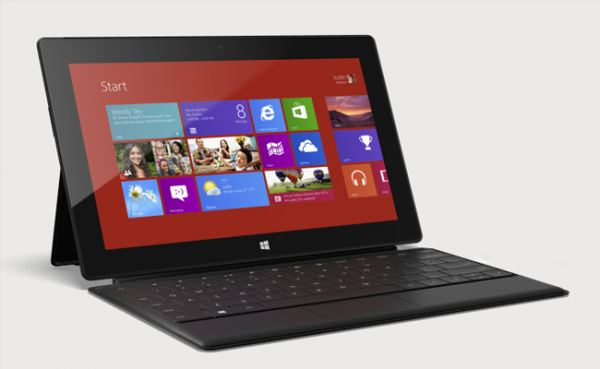
This is how you sell a tablet. Tuesday evening of May 14, Microsoft debuted a new commercial for the Surface RT that finally explained the benefits of the tablet. No dancers. No super cool music. Just Microsoft talking about why the Surface RT is the next device you should own. The company emphasized the included USB port, kickstand, keyboard, and the single biggest sell of Surface RT, the included Office 2013 install. It sold the Surface as the power of a computer in the package of a tablet.
Is this not precisely what I called on Microsoft to do in my previous article about those odd (but awesome) Windows 8 ads? In that article I told the story about a guy who was working in a coffee shop on his Surface when someone walked up to him and said, “Is that the tablet that clicks?” He recognized the product from the commercials, but seemed to be unaware of anything other than its clicking. I wrote,
This situation underscores the reality that people just aren’t aware of what the Surface actually is and how much more it is than just a tablet. If Microsoft can get this message out by focusing on features against competitor devices like the iPad, people will continue to be confused.
This commercial will easily solve the problem that consumers have of trying to understand the value of the Surface. I have not seen the commercial since, so it was probably just a trial run by Microsoft just to test the waters. I for one am impressed and Microsoft definitely needs to create more of these commercials for the Surface Pro as well as Windows 8 in general.
I tried finding this commercial on YouTube but was not successful. If you find it, let me know and I can update this post.
Have you seen this commercial? Do you think it properly sells the advantages of the Surface RT?
Update: And here it is.
-

Microsoft needs a Happy Ending
Publié: mai 16, 2013, 9:32am CEST par Robert Johnson

Creating original content is the big trend with major tech companies like Netflix and Hulu. But recently, others such as Amazon and Microsoft have thrown their hats into the original content creation ring. Nancy Tellem, a former CBS executive, will oversee the creation of original entertainment content for Xbox Live. Tellem will be in charge of a new studio in Los Angeles. Microsoft is already rumored to be reviving the canceled Heroes series. This is not a bad idea as we already know that Netflix has revived the popular Arrested Development TV show that was canceled by Fox.
This week a few shows that were popular in the LGBT community were canceled: Smash (NBC), New Normal (NBC) and Happy Endings (ABC). The last one, Happy Endings, is rumored to be picked up by the USA network. This would be a perfect show for Microsoft because while Heroes is one of those shows that certainly fits the traditional Xbox demographic, Happy Endings is one of those shows that can appeal to the existing demographic as well as a new one.
The show has been described by some as a modern take on the popular program Friends. The show is about the daily antics of a diverse group of friends. While not exclusively about gays, it does include a gay character that plays one of the main roles.
Happy Endings will allow Microsoft to appeal to a more diverse demographic, something they need as the Xbox enters a new era of competition among TV connected devices and services. Xbox will face some serious competition in the living room this year, and Microsoft should be as aggressive as possible in creating original content. Picking up canceled TV shows that had a popular cult following (as Happy Endings) is a great start.
-

About those Windows 8 ads...
Publié: mai 10, 2013, 6:57am CEST par Robert Johnson
There’s more than one way to advertise a product and while I am a big fan of the approach that specifically focuses on features, I understand there is a need for other approaches. Sometimes you just need to go for the pure emotional response. In the case of the ads released by Microsoft today which focus on the Asian market that seems to be what they were going for. Take a look.
I’ve been a critic in the past of Microsoft’s approach to advertising its various products. I’ve always felt they never did enough advertising and didn’t advertise at the right time (popular prime-time TV shows or big sports events) but that has changed. I’ve seen Surface, Bing, Windows Phone, Windows 8 and Outlook.com commercials during primetime, during the NBA playoffs, and even at random times on random networks on cable TV. Microsoft has definitely increased the frequency of its advertising.
However, I still have one problem. I’d still like to see more focus specifically on features of these products that make them better than the competition. Take the Surface commercials, for example. I absolutely love the way they first introduced us to the product: remember the commercial with the dancing school girls? Loved it. And now they are running a slightly different twist on that with dancing business users to introduce the Surface Pro. Almost six months on the market and all we know about the Surface is that it clicks -- and you can dance with it.
I think the general public is well aware that the Surface exists and if these commercials are primarily aimed to introduce us to it, then I believe they have so far succeeded. What we need now is not more dancers. What we need is to know why we should buy the Surface instead of an iPad. Tell us specifically in words why Surface is better.
The Amazon Example
This Amazon commercial may be one of my favorite iPad competitor commercials. In it, they focus on the displays between the two devices. They don’t say their display is better (because it isn’t from a technical perspective). Instead, they focus on the fact that the average person can’t tell the difference between retina and non-retina displays. Just as you’re about to say, “why would I buy a Kindle Fire?” they hit you with this:
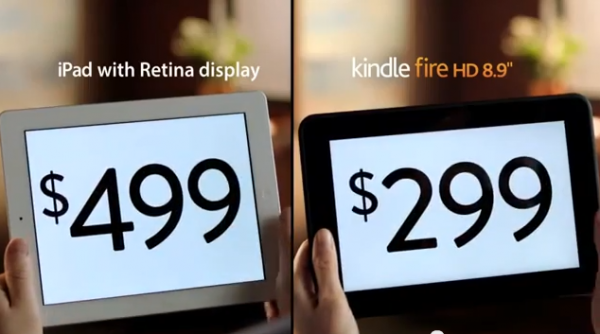
See for yourself:
Why is the Fire better? Price alone is a major reason at $200 cheaper than an equivalent iPad. Amazon emphasizes the features that the general public can understand, screen and price.
Microsoft, It’s Time
Microsoft should step up and start advertising on features more. Windows Phone is doing this with the Smoked By commercials. They really should be running those around the clock in tandem with the new switcher ads. As Microsoft continues the transition into this new era of mobile, this becomes all the more important.
I heard a guy telling a story at work one day about how he used his Surface at a coffee shop and someone walked up to him and said, “Is that the tablet that clicks?” Incidents like this show that Microsoft is getting the word out. But people don’t quite know why the Surface is better. I had a conversation with a friend about Surface and why he should consider buying one, and his response was, “I already own a tablet to surf the Internet with”. When I told him why the Surface is not just a tablet, his perception completely changed.
This situation underscores the reality that people just aren’t aware what Surface actually is and how much more it is than just a tablet. If Microsoft can get this message out by focusing on features against competing devices like the iPad, people will continue to be confused. Even though Surface Pro is not even in the same computing category of an iPad, to the general user, it is.
Microsoft’s marketing is pretty good these days, but a slight change could result in a lot more sales of its mobile devices and really put it on the road towards dominating the next phase of mobile computing.
-

Microsoft CAN win the hearts of consumers
Publié: mai 1, 2013, 8:20pm CEST par Robert Johnson
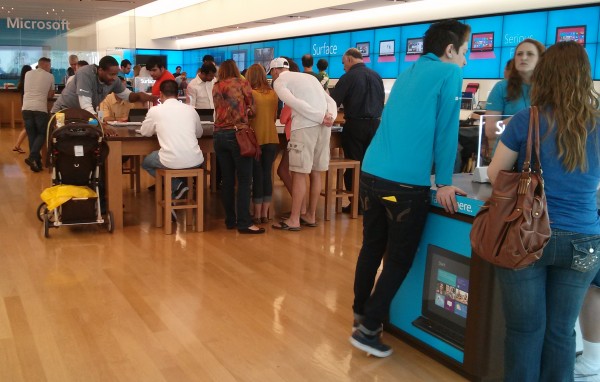
Many people want Microsoft to die, and the sooner the better. I’m not in that group, although I understand that years upon years of letdowns through viruses, DLL hell, BSODs (Blue Screens of Death) and a myriad of other problems lead many in the tech world (and consumer world, too) to walk away from everything Microsoft. Add to that the growth of the Internet and mobile devices as well as slumping PC sales, and you can see why so many wait with baited breath to see the company go away for good.
Nevertheless, quarter after quarter Microsoft continues to prove that it still has life and isn't going anywhere anytime soon. In fact, in 2011, CEO Steve Ballmer explained how the company intends to reinvent around devices and services. Seeing that the growth of mobile devices and the services that support them represent the future of computing, Microsoft responds yet again to the changing world of computing.
I say, “yet again” because this is not unusual behavior for Microsoft. The company often is chided for being slow and out of touch with current technology trends but I’m not convinced that’s always the case. Microsoft was there when the personal computer took off. The company was there when it became clear that television would be a major growth area. And Microsoft was there when mobile devices first became a big deal.
Personal digital assistants (PDAs) were introduced in the mid 1980s by Psion. These devices paved the way for the pocket PC where Microsoft was able to gain significant market share with Windows Mobile. Also popular during this time was the Palm Pilot and devices from other manufacturers like Blackberry, HP, Dell and Compaq.
While Palm was very effective at making inroads into the consumer world, it wasn’t until 2007 that things really took a turn. Apple introduced the iPhone. This wasn’t Apple’s first foray into the world of mobile computing. The Newton was a PDA device that was introduced to the world back in 1992 but wasn’t a blockbuster hit.
The iPhone quickly became a smash hit (once the price lowered). It was so successful I sometimes get the impression people believe Apple created a new market, which isn't true. The transition of mobile devices to the consumer arena was well underway when the first iPhone was introduced. What Apple did do was take an idea that already existed and make it a million times better. Microsoft did this in gaming with the Xbox.
Apple was able to get a huge lead against its competitors in the consumer space. How was this possible? I believe competitors saw the iPhone as just another “me-too” mobile device. However, Apple understood something that either its competitors didn’t or they simply were too slow to act on it and that is, the world was shifting to simple software backed by compelling user experiences. If consumers weren’t looking for it in 2007, the time would come where they definitely would. It just so turns out that consumers (young people) were actually ready for the shift.
The Computing Shift
I previously wrote about how I believe Windows 8 represents an understanding by Microsoft that there is a cultural shift happening that was affecting the way people use computing devices: a shift to a simplified experiences economy and this is the basis for why people are a bit confused and vexed by its Jekyll and Hyde interface.
A similar thing happened in 2007 with the iPhone. The economy of computing was in process of shifting from being services (not to be confused with software services as commonly used today) based to experiences based. In that article I explain what this means:
In a services economy an individual cares about goods but more importantly about the services surrounding those goods.
In an experience economy, services become the stage and goods are the props used to engage the individual in a conversation and immerse them in a story. Services are not enough because they are not as memorable as experiences. Goods and services all remain outside the buyer while for the first-time experiences allow companies to get inside buyers and manipulate them emotionally to purchase their products. Experiences are inherently personal. Through an experience an individual can be engaged not just on an emotional level, but on a physical, intellectual or maybe even a spiritual level. Experiences remain with the individual for some time to come.
Apple saw it coming and made the right moves. Its competitors didn’t.
Another Shift
I believe there is another shift on the horizon. In this shift experiences are still important but they are simpler. I previously wrote:
Windows 8 tells a story that is more representative of a new way of thinking about computing habits and behavior. It is representative of a shift towards an experience economy but more specifically it represents a shift to a new kind of experience economy: a simplified experience economy.
This simplified experience economy would be characterized by (1) a reduction in the number of devices consumers need to carry with them, (2) powerful (think processors) mobile computing, and (3) will be deeply personal.
Simplified Experience Economy
I believe we’re moving towards a computing culture where users will do most of their work on one device. Let me explain.
The current mobile world is dominated by devices that are extremely limited in terms of computing capacity and processing power. These devices are mainly used for consuming content. To create content, users need more powerful devices like a laptop/desktop. Currently users have to carry around a phone/tablet device and a laptop or sit at a desktop to get all their computing tasks (consuming/creating) done. I’ve said before that the zenith of computing nirvana is to be able to not only consume content on today’s super thin mobile devices but create content on them as well, with no compromises. The result is that we carry fewer devices, which greatly simplifies our computing experiences. We’re not there yet, but Microsoft with Surface Pro has gotten us closer than anyone else in the market.
What makes this new computing economy deeply personal? The pervasiveness of more natural ways of interacting with these devices. If you’ve been reading my articles long enough you know I am a huge fan of natural user interface (NUI) technology. The more naturally we can interact with our devices the more personal they become. The ability to switch between input methods based on the real life situation or interface on the screen makes using devices so much easier. I often use the example of my Xbox 360. My couches love to eat my remote controls. So having the ability to use my voice to navigate the interface has been a big plus. A device that once had limited input is made easier to use by expanded input capabilities.
The simplified experience economy will be one where we can consumer and create on devices that can be interacted with in more natural ways. All of this will be made possible by extremely power processors.
Mobile Phase 3?
I am convinced that we are entering a new phase in mobile computing. The first phase saw the introduction of the phone and PDAs. The second phase is characterized by the introduction of the iPhone. The third phase will usher in mobile devices with powerful processors capable of creating and consuming content and multiple input methods (mouse/keyboard, speech, touch, touchless gestures). All is made possible by a cultural shift to a simplified experience economy.
It appears that we are on the precipice of phase 3. With Windows 8 we are now starting to see the appearance of hybrid devices that operate as both a tablet and a full PC. These devices look like a laptop but the screens are detachable. Windows is the perfect operating system to run on these devices. It’s Jekyll-and-Hyde nature, while ridiculed by many, may be its greatest strength. What other OS on the market is capable of allowing users to consume content and create it all within the same device using powerful applications like Photoshop? None.
Surface Pro, while not particularly a hybrid device, is definitely a different take on the tablet. It by far is the best stage for Windows 8 and this new shift in computing. All of these devices allow users to work when they want, for as long as they want, wherever they want and however they want. Perhaps this is what Microsoft means when they call Windows 8 a system with no compromises.
Microsoft on Mobile
Microsoft was a key player in phase 1, wasted away phase 2 and is well positioned for phase 3. I’m not at all declaring a winner especially since there is a lot to be said about the dominant position of both Android and iOS these days. But unless Google and Apple position themselves for phase 3, it’s not a far-gone conclusion that they could be playing catch up to Microsoft.
As we survey the current landscape of mobile computing it’s clear the market for computing devices is in transition from traditional computing devices like laptops and desktops to mobile devices like smartphones and tablets. It is in this current market that Microsoft is struggling to make sales. I often have been critical of the company and its apparent slowness to respond to the competition. However, I now consider the possibility that perhaps Microsoft sees something that most of us does not.
Microsoft officials have said that they see mobile as a long-term play, something more akin to a long journey. That doesn’t sound like the kind of language that should come from a company that believes the clock is ticking on a death watch. It’s quite possible that Microsoft sees the next phase of mobile and wants to get out ahead by giving time to develop and connect newly-built platforms. I don’t have a problem with this at all and in fact I think it’s a great strategy if in fact that really is the case.
There’s no way Microsoft can take down iOS and Android by creating devices and services that merely match parity with today’s market. Some may be more optimistic about Microsoft’s chances in today’s market, but I’m not. As I’ve argued before, the company needs to go beyond today’s offerings in order to really grab the attention of consumers with highly differentiated devices. Microsoft can win round 3 by improving the developer platform by getting as close as possible to write-one-run-anywhere, which should lead to better and more high profile apps, and finally through improving Windows Phone marketing. The new campaign, “Don’t Fight. Switch” is a great start!
Microsoft can win the hearts of consumers. It hasn't yet but I am pretty optimistic that if the company stays the current course, it will. It just won’t happen overnight. Today if you give people a choice, they most likely will not choose Microsoft. The next phase of computing is coming and for a company that traditionally does some its best work during a crisis, I’m not ready to say it doesn't have a chance.
Photo Credit: Joe Wilcox
-

Does Microsoft have a developer crisis?
Publié: avril 25, 2013, 7:41am CEST par Robert Johnson

The web is now the next great application development platform. Webkit is by far the most popular development “platform” among the web development community. Many are calling for Microsoft to ditch Trident (the rendering engine in Internet Explorer) and replace it with Webkit. I personally think that would be a huge mistake and apparently Google feels the same way or it wouldn’t be forking Webkit as the basis of its own rendering engine.
Nevertheless, the web development community is uber focused on non-Microsoft technologies for development. This presents a big problem for Microsoft and ability to hold on to its development community. I believe Microsoft can overcome this threat if by making a few key moves.
1. Increase involvement in the open-source web development community. Microsoft is already doing a lot of work in this area. But the company can really begin to change negative impressions by contributing tools to make development easier on projects like SASS and Compass, for example. There are many projects Microsoft contributes to. I merely suggest the company thinks about specific tools to make development faster.
2. Be more aggressive at getting Internet Explorer ahead of the competition in standards compliancy. It’s pretty amazing how at version 10 Internet Explorer still lags the competition. Microsoft needs to move a lot quicker to get the browser to at least match the competition. But matching the competition is not enough. I believe the company needs to move ahead of the competition in supporting key features of HTML5/CSS3. Internet Explorer should become the model of standards-compliant browsers.
3. Make HTML5/JS a first-class programming citizen. I think one of the best moves Microsoft made last year is to allow apps on Windows 8 to be developed using HTML/JS. This is a big deal because Microsoft needs to hold on to as many developers as possible and make it very easy for new developers to transition to its platforms. The ability to use languages that are in widespread use today is a major plus for Microsoft.
4. Write once, deploy everywhere. The ability to write an app one time and deploy it across any platform is the nirvana of app development. We seem to be a long ways off from this. I’d love the ability to write an application in HTML/JS one time and have it automatically adjust itself for the desktop, laptop, tablet, phone and TV screen. Some believe this to be a pipe dream. Perhaps so. However, the closer we can get to it, the better.
Those are my top-four picks for what I think Microsoft can do to hold on its developers. What do you think? Is Microsoft in a crisis with developers or is everything easy peasy and the company has nothing to worry about?
Photo Credit: Piotr Marcinski/Shutterstock
-

My next-gen Xbox wishlist
Publié: avril 18, 2013, 7:12pm CEST par Robert Johnson

Xbox is due for a refresh this year and it's a good time to write my wishlist. I’ve been accused of being a Windows fanboy, which I’m not. I’ve also been accused of being a Windows Phone fanboy. No again. But I’ve never been accused of being an Xbox fanboy, which I absolutely am.
With the Xbox, Microsoft has a stellar platform on its hands. The console has gone from a third place alsoran to a major player in the console wars: a strategy Microsoft desperately needs to adapt to Windows Phone, but that’s a different article. As the world of computing shifts to mobile, so is gaming, allowing companies like Apple to get into the business. What do vendors that build consoles need to do to adjust their strategy? I can’t say much for Sony or Nintendo because I don’t use those platforms anymore. For Microsoft, here’s my wish list for the next Xbox platform update that I think will allow it to remain a major gaming industry player despite the shift to mobile computing.
Fix Xbox Music/Video
This has to be my single biggest disappointment from the Xbox team. As a fan, I have never felt more let down then when this turd released. Zune worked very well, despite some key features like cloud music, or playlist syncing between devices. Xbox Music as it stands right now is almost useless and for those of whom were former Zune users, Microsoft owes an apology. Music match barely works. Playlist syncing issues/complaints/support requests go unanswered by Microsoft.
Xbox Music should be the service that takes down all the other players in this space. My wish is for a social component that lets me see what my friends are listening to and be able to share playlists with them. But here’s the problem with that. There aren’t that many people out there who actually use Xbox for music. None of my friends do. Almost all of them are on Spotify. So how do they get around this? Perhaps, hook into the Spotify service (assuming the API is open and will allow this) and expose what my friends are listening to or perhaps do it through Facebook for those friends who publicize their listening habits through that service.
Also, I wish for Microsoft to release a cloud music locker that allows me to stream my music to whatever device I am using. Fix playlist syncing because right now it doesn’t work. If I create a playlist on my PC it should automatically sync to my phone, Xbox or tablet.
For Xbox video, please release a service that allows videos I purchase on one device to be playable on others. Enable more SmartGlass capable content and make them easily discoverable, and if you need to charge a dollar more for it, that’s fine, but please add more content.
Can we get a subscription service for video? I realize Hollywood content producers are the major barrier here so I understand if this is a pipe dream that will never happen. But something has to be done to differentiate Xbox Video from all the other services out there.
Microsoft has officially announced that it is moving into producing their own content for Xbox. Hopefully this means the console will gain more TV-like services such as the ability to record live TV like a DVR. I would wholeheartedly welcome this. Netflix nailed it with House of Cards and producing content is the future for platforms that want to be taken seriously in the video space.
Make Skype Available
I don’t understand why there is no Skype app on the current console. Hopefully this is coming in 2013. But I don’t just want to be able to call my friends on their consoles, phones and other devices. I want you to take it up a notch and call another Xbox/PC/tablet in my own home. This would be awesome for a parent who needs to get in touch with a kid in another room to come eat dinner.
Let Xbox "See" More
Here’s what I mean. The console currently works very nicely as a PlayTo and SmartGlass enabled device. But for the content that I don’t necessarily have uploaded to SkyDrive, Xbox should be able to see and play all my content in the My Music and My Videos and My Pictures folders on all my PCs/Devices. I know I can currently on Windows 8 use PlayTo and shoot this content to my Xbox. But I don’t think the PlayTo interface in the desktop is the easiest interface to use.
Release a Smarter Xbox
The natural user interface in the current Xbox platform enabled by Kinect is a great feature that I actually use on a regular basis. Do I use it every day? No. There’s no way I would sit in front of my TV gesturing to it. As much as I use my Xbox, this would get really tiring. However, when I need it, the feature is there and ready to work. And it works quite well for me. This is what makes technologies like Kinect so "natural". When I lose my remote, as I often do, I usually just end up talking to the console.
However, I understand this is not exactly ideal when you find yourself in a situation where you can’t find your remote but your room is so loud, there’s no way Xbox will accurately hear you. While gesturing is available, if you need to get to an app or a TV, the arms can tire quickly. A smarter Xbox will allow me to use my phone or other mobile device as a microphone to talk to my Xbox. This would reduce interference from other sources and allow the Xbox to clearly understand my commands.
A smarter Xbox will also allow me to control other wifi enabled devices in my home. Perhaps devs can write apps that hook into such devices.
Wouldn’t it be great if the console understood my usage behavior and adjusted the interface accordingly? Let me explain. Let’s say every day after I get home around 4:30pm the first thing I do is turn on my Xbox and open the HBO GO app, because I’m watching Game of Thrones Season 2. A smarter Xbox would observe this pattern and ask if I wanted this automatically done for me, so that when I get home it’s already cued up to the next episode or the spot where I left off. But what if for some reason, I’m working late one day. I wouldn’t want the console turned on and sucking up unnecessary electricity. To get around this, the console could enable the ability to log into my Xbox account online and turn off or reprogram it for another time.
Expand Kinect
Kinect should pushed to other platforms like Windows (Bill Gates has said this is coming) but my point in this article is about the console. If the Xbox team decides to release other devices (more on that next) these devices should include Kinect capabilities whether they be in gaming related scenarios or navigating the interface or both.
Not only should Kinect expand to other platforms, it should be improved for natural language scenarios. It’s time for Microsoft to put all that speech data it’s been collecting since the release of Kinect to work. It’s 2013 and computing devices like Xbox (or any other Xbox-enabled device) should be able to understand natural language. This capability should be made available to app developers as well.
Bring out More Devices
A 7-inch gaming/media consumption device should come from the Xbox team. It should be the ultimate smart device and should allow me to control my console and vice versa. This device should permit me to play games with others who are on the console (more on this later). It should have access to all the Xbox media apps, including apps from the Windows Phone and Windows stores. This device should cost no more than $200 and could potentially be sold in a bundle with the new Xbox.
Besides a 7-inch tablet device, the console needs a small TV streaming media only device with integrated Kinect. I love my console, and I have one in every room, but $300 is a lot to spend for a media device. Release a $99 (or less) media device that has access to all the media apps available on the console and also includes Skype and the ability to push/pull content from all Windows devices (phones, pc’s, tablets).
Open the App Platform
Apple is a serious threat. I know many people don’t think so but here’s why guys like Gabe Newell are correct about Apple in the living room. Apple already has a massive platform in iOS and the app catalog as far as gaming goes is tremendous. If all the company did in 2013 was open up Apple TV to developers and their app gaming catalog, that’s enough to do some serious damage to Microsoft’s living room strategy.
Xbox should get out ahead of this and open the app platform up to all developers for a nominal registration fee. This should not just be for gaming but for media apps as well. Xbox should be able to run on a new apps platform that gets as close to write-once-run-anywhere as humanly possible. A company like HBO should be able to write one app and have it be able to run on any sized screen from a phone all the way up to a TV screen.
This would require the Xbox having the same core as other Windows devices (phones/PC/tablet) but the rumor is that this is most likely going to happen (or why else would you move the NT guy to the Xbox team?) and I cannot help but think that one of the benefits of this is a more unified app development platform.
Create a Real-time Multi-player Multi-device Gaming Platform
I saved this for last because even if Microsoft does not come through on any of my other wishes, this is the one that I think will set the Xbox platform apart from any platform available today. Microsoft has already demoed the ability of a Windows Phone to interact with the console. Remember the YouTube video of the person sitting on the couch with a Windows Phone interacting with the Kinect dodge ball game while a guy in the same room played the game from the console?
What we have so far is pause/resume across devices. Skull of the Shogun is the best example of this. This game can be purchased on Windows Phone, Windows 8 (PC/tablet) and the XBOX. Users can play on one device, pause and continue play on another. While this is great, what is really needed is a way for users in games like Halo or Call of Duty can play multiplayer in real-time regardless of device. There are definitely challenges to this when you are on a screen the size of a phone, but that doesn’t mean those players have to be left out of the game. Perhaps players on the phone can operate in support roles.
There are other games that are great for this scenario: racing games. We already play them on phones and they would be perfect for a new platform like this. Can you imagine Forza on Windows Phone? Microsoft already is seriously lacking in its attempts to push the Xbox platform to Windows Phone. I think it’s absolutely embarrassing that they have not successfully turned Windows Phone into a stellar gaming platform. You have the most successful game platform in the United States and you cannot leverage that onto your struggling mobile platform? Unacceptable.
Conclusion
So there you have it. My Xbox wish list for this year. I intentionally left off this list is specific games and media apps (like Spotify and Amazon Music) as I am sure Microsoft will come up with some pretty amazing solutions in this area. I’m sure there’s something you can add to this to make it even better. What do you think should be added to this list?
Update: As I was writing this article, GameLoft released a racing game for Windows Phone 8 called Asphalt 7. This game includes real-time multiplayer with other phone devices. This is a great start! Hopefully Microsoft plans more releases like this that are expanded to other devices as well.
Photo Credit: Joe Wilcox
-

NUI can save Microsoft
Publié: février 22, 2013, 7:39pm CET par Robert Johnson

I don’t know about you but as a lover of technology and the world around it, I find these times to be quite compelling. Apple, Google, Amazon and Microsoft (the big four) are setting the stage for an epic battle for tech dominance. The many articles and blog posts calling Microsoft dead in the water are way too premature. We are way too early in this new world of mobile computing to call Microsoft out of this game.
However, I will say this: If any of the four previously mentioned companies are in the most danger of failing at the consumer market, it’s Microsoft. The company better figure out how to get things together and quickly as time is not on the leadership's side and their competition is hitting on all cylinders.
A Good Foundation?
Whatever you think about the Windows 8 devices (including phones and Surface RT/Pro), the bottom line is that they represent a transition to the future Microsoft. They offer a peek into what will become the New Microsoft. Are there remnants of the “old way” still around? Of course. There are myriads of examples but let’s look at two:
1. The slow pace at which Windows 8 apps like Mail, Calendar, and the Xbox Music service are fixed is mind boggling. It’s unacceptable. These apps are barely usable, and the fact that they are apps implies they can be updated on a much quicker pace. I’m not talking about performance and bug fixes. I’m talking about features.
Xbox Music is probably the biggest failure of them all. Microsoft deserves a class action suit for how it bungled this mess. The company advertises features that barely work. Customers are left hanging on support sites with no answer to legitimate issues they are experiencing with this pooch screw of a music service. Spotify has its issues, but at least the service does what it is advertised to do.
2. Windows Phone early adopters are treated worse than slaves on a plantation. So Microsoft announces an upgrade for early adopters called Windows Phone 7.8 and then proceeds not to say anything else about it for months. They also announced a special program where fans of the phone can get early access to updates. Nothing else has been said about this either. Way to treat your fans/early adopters Microsoft!
Despite these issues, Windows 8 and its supporting services (SkyDrive, Bing, Skype etc.) all represent the solid foundation that Microsoft needs to leverage in order to get the attention of consumers, because let’s face it, right now, Microsoft is not really at the forefront of the consumer mindset.
To compete as a complete ecosystem and player, the company needs to have a way for customers to work/play wherever and whenever across all device types. SkyDrive, Office, and Skype allow us to work whenever and wherever on PC, tablet, phone and TV. SkyDrive, Xbox Music/Video and Xbox Live allows us to play whenever and wherever. Admittedly the “play” aspect of Microsoft's current ecosystem needs work but at least the foundation is in place.
Microsoft really is the underdog of the big four, and I love rooting for the underdog. So how can this underdog claim its rightful place among the big four and secure its position for the future of mobile computing? I have a few ideas.
NUI
Natural user interfaces is an area that Microsoft has invested heavily over the past several years. The company has teased us with all sorts of amazing videos from its research division. However, what have we seen so far? Kinect. Great start, but not enough to increase consumer adoption across its consumer product portfolio. So what can they do beyond Kinect?
1. Expand Kinect to other platforms. I use Kinect on Xbox regularly. I mostly use the voice controls, because I am always losing my piece-of-crap Xbox media remote, and it’s just a lot faster to navigate the interface this way rather than click on a remote. Providing the ability to use the proper or more natural input device based on the moment is what makes regular consumers like myself feel at ease; instead of having to adjust to the device, it adjusts to me.
Kinect is a powerful technology, and when Microsoft released it on the Xbox -- I believe strongly (and I could be wrong here) -- the controller is the one thing that catapulted the consold to the #1 spot here in the United Stated. If Microsoft can leverage this technology across other devices/platforms like Windows, Windows Phone and Surface, it will differentiate its products from others in the mobile space and get consumer attention as well.
Bill Gates has already said that Microsoft platforms will support multiple input types (read keyboard, mouse, touch, voice and camera-based gestures) but we don’t know when. Perhaps this is the killer feature of the “Blue” wave of updates.
2. Get TellMe to the masses. We’ve seen the videos of the TellMe service using natural language, a la Siri and Google Now. So we know that whenever Microsoft finally gets off its rear-end and releases something similar we can’t say it's just copying competitors. But then again, in this Apple-obsessed tech culture, we all know what will definitely happen. Releasing an upgraded TellMe service that simply returns movies, weather and traffic info is not enough.
This is no different than what’s currently on the market today. Microsoft needs to go much further and release a product that allows a user to navigate an entire computing interface. For example, a user should be able to control an entire phone by voice by saying, “Show me my text messages from Brian Rains” or “Take me to Williams Sonoma dot com and show me their latest cookware”.
Perhaps I could even tell my Windows Phone to cue up Hulu Plus at 4:15 p.m. so that when I get home, it’s already up and running on my Xbox. Maybe I’m living in a pipe dream, but this would certainly differentiate an upgraded TellMe service.
3. Bring NUI to the web. I don’t see why not. Microsoft is already heavily committed to advancing web technologies like CSS and HTML5. Microsoft has a major in by recommending new HTML specs that leverage voice and camera-based gestures. Web development in large part is not taking place on Microsoft platforms, and one way the company can win over web developers is by creating new technology that’s easy to integrate into our existing solutions and is open source. As someone who works on web-based business applications, the ability to create interfaces that allow users to use whatever input method they want would be a huge win.
In the same way that this technology reinvigorated the Xbox, I believe NUI can reinvigorate Microsoft’s other platforms as well. It seems to be the one technology that the others in the big four are working on but don’t appear to be all that serious about right now.
Google’s approach seems to be about besting Apple. While Siri is an interesting product, it’s hard to tell where Apple wants to take it. It seems way too gimmicky right now while Google Now actually feels useful. But none of these approaches are as pervasive as what is needed to really take computing to the next level.
How important is NUI to Microsoft’s future? I think it is one of the most important technologies the company could ever invest in. But what do you think? Is NUI Microsoft’s Trojan Horse or is it something else?
Photo Credit: Slavoljub Pantelic/Shutterstock
-

Touchscreens on laptops make complete sense
Publié: décembre 3, 2012, 5:35am CET par Robert Johnson

With the advent of advances in technology and the increasing power of process, we are witnessing a tremendous transition in the design of user experiences and interface design in software development. Of particular interest in this article is the culmination of natural user interface design as it relates to the current crop of touchscreen laptops made possible by Windows 8.
One of the things I have noticed as more and more tech sites review touchscreen laptops is the increasing amount of comments such as, "I would never touch a screen on a laptop" or "why would anyone ever need to touch a screen on a laptop?" The problem with the comments, the thinking is limited by mouse and keyboard. Windows 8 is the first operating system to force us to move beyond this thinking when it comes to using traditional computing devices like desktops and laptops.
If you don’t think touch screens on laptops are useful, just watch someone use a keyboard with an iPad. Sometimes, it just feels more natural to touch the screen in certain instances rather than use the keyboard. For instance, I have Surface RT and use it on a regular basis for simple computing task ranging from consuming content to creating content. Using Windows RT, I find myself moving between mouse/keyboard input to touch. Why? Because there are times where it feels more natural to me to touch the screen rather than fiddling with a mouse/keyboard input.
I find this freedom to be quite pleasing and necessary for the future of computing going forward and is why I believe that Joe Wilcox’s article about context in computing is an important aspect of the future of computing going forward. Further, I believe that Microsoft (along with Windows 8) recognized this long ago and we are finally realizing the benefits of contextual computing in Windows 8 (more on this in a future article).
That said, this is why touchscreens on laptops are finally making an appearance. Finally computing devices are not forcing us to use the traditional keyboard/mouse combo regardless of our computing situation. For instance, the ability to touch a screen makes way more sense when demoing a mobile app being developed rather than using the keyboard/mouse combo.
Further, sometimes it just feels more natural to touch the screen. The beauty of this for a user experience developer like myself is that, the use cases will not be the same for everyone. For example, when I fill out a form in Internet Explorer 10 on my Surface, I find it more natural to select my field by touch rather than mouse/keyboard or tabbing. The greatness of this is that I can keep my hands on the keyboard if that is more natural for me, or use the touchscreen.
My point in all of this is that what may not be natural for the negative critic of touchscreens on traditional computing devices like laptops (or even desktops) may not necessarily be non-natural for the next person. Just because Apple has not added touchscreens to traditional computing devices does not mean people will not use them or even more, don’t need them.
We have entered the age of natural user interfaces. Right now we see an explosion of touch and mouse/keyboard usage on traditional computing devices. Soon, hopefully in 2013, we will see the addition of voice and camera input on these devices (Microsoft Chairman Bill Gates is on record as saying these are coming to Windows in the future). Something tells me that with all the data Microsoft collects on the Xbox through Kinect, and the bit of data collected on Windows Phone devices, the company is in the best position to take advantage of this prime opportunity to advance devices for the natural user interface age. While right now we have the benefits of mouse/keyboard/touch input, soon, we will see the addition of voice and camera inputs as well that will absolutely simplify our computing experiences like never before.
If you don’t think touchscreens on laptops or desktops make sense, think again. It’s the future. Get ready for it as you may be surprised to see your index finger gently making its way toward your monitor to make a selection you typically would make with your mouse.
Photo Credit: bloomua/Shutterstock
-

Microsoft, ditch OEM knuckleheads and make more hardware like Surface
Publié: novembre 19, 2012, 11:30pm CET par Robert Johnson
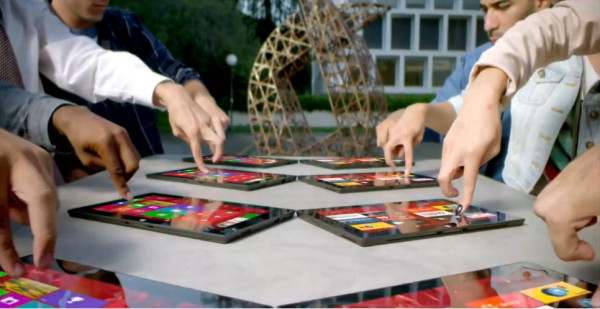
Dell earnings announcement set off some concerns that the PC industry may not recover and as a result some are predicting Windows 8 sales may not be quite satisfying to Microsoft. Could the software giant have seen this coming a mile away?
A mobile future means that traditional PC hardware like laptops and ultrabooks will yield sales to a new generation of PC form factors like hybrids and tablets that are highly mobile, yet just as capable as laptops and ultrabooks, tablets like the Surface. Microsoft knew mobile was the future and prepped for it, here’s why.
Hybrid PC designs. Hybrid PC’s are devices that are both laptop and tablet. In some cases like the Samsung ATIV Smart PC, the screen detaches from the keyboard to become a tablet. Similar designs from other OEMs is a clear indication that Microsoft and the PC industry was well aware that there needed to be a smooth transition to the new world of mobile/contextual computing that is accelerated by the transition from an experience economy to a simplified experience economy. I wrote about this concept previously.
Touch-first Windows 8. Windows 8 is a polarizing release that some journalists and bloggers claim is massively confusing to end users. I’m not so convinced. I think some users will definitely be confused but not most. I really like Windows 8 and I believe its design from a conceptual standpoint was the right thing to do (see second and third parts of my earlier series).
However, I believe some of the finer details in execution are definitely quite troubling. For instance, I recently argued that the desktop in Windows RT makes complete sense. That is, Microsoft made a concerted effort to port x86 apps over to ARM for installation on Windows RT products. I was hoping Microsoft would explain this at BUILD 2012 but it seems that since they haven’t, I have no other option but to agree with others that the desktop in Windows RT is presently an odd addition even though in my Surface review I do state that I find it pretty useful. My gut feeling tells me that Microsoft will mature RT over time to a full PC experience, but I’m not holding my breath. Unfortunately, this is one of the major areas that will throw consumers for a loop.
My point is that Microsoft saw the transition to mobile computing as the future and pivoted its popular OS to adapt to this new world. Windows 8/RT is simply the most advanced mobile operating system on the planet regardless of how oddly cobbled together it may appear to some. The more they transition the desktop to a touch-first experience, resulting in a seamless transition between it and the new start environment, the better it will get.
Surface. This is a big one. Microsoft stunned the tech industry with the announcement of the Surface tablet. Since then CEO Steve Ballmer is on record stating that there will be more devices coming. Ballmer’s letter explaining the transition of the company to a more devices and services company is telling.
Microsoft sees that its hardware partners completely suck. They’ve had ample opportunity to get their acts together and create compelling hardware and software experiences that wow customers. Yet, they continue to adopt old practices like bundling crapware with uninteresting hardware, selling them in big box retailers who care nothing about how these products are displayed -- they just want to make a buck.
Surface is the right move. Microsoft needs to cut ties with whinning OEMs (Acer? HP?) which while bashing the spectacularly designed hardware that is Surface continue to churn out underwhelming products. What’s next for Surface hardware? A phone? Laptops? Who knows? One thing’s for sure, it’s time to go full steam ahead and whichever OEMs tag along, good for them; those who don’t? Good riddance.
So What’s the Problem?
It seems to me that Microsoft prepped for the mobile future but Surface is the one problem with the strategy. Surface should have launched in every retail store on the planet with strict guidelines for how the product would be presented to potential consumers. And Microsoft should have launched both the RT and Pro versions at the same time.
The company's actions appear to reveal that executives didn’t want to entirely damage their relationships with OEMs, But I think it’s time to put OEM feelings aside: these guys simply don’t care anymore. This is evident by the lackluster number and quality of devices on store shelves to this day, weeks after the Windows 8 launch. I’m not suggesting that Microsoft stop licensing Windows to OEMs, but that Microsoft ramp up its hardware efforts.
If the PC industry does not recover, who’s to blame? Better yet, who’s to blame if Windows 8 never takes off with consumers (who Microsoft was clearly targeting this time around)? I don’t put the blame on PC OEMs very much, if at all. I blame Microsoft. I blame Microsoft for trusting these knuckleheads to do the right thing. OEMs are way too focused on selling traditional laptops/ultrabooks. But consumers are not too interested, as disastrous third-quarter PC shipments reveal.
Microsoft seems to understand that the bigger innovation opportunities are in tablets right now. I suspect traditional PC sales will continue to decline and at some point will fall off a cliff, but those sales will be replaced by devices that are more mobile, yet offer the same capabilities as traditional laptops/ultrabooks. Since devices like Surface have redefined what is meant by PC, the PC industry as a whole has a chance to actually grow in the future.
Perhaps a slumping PC industry (resulting in slow Windows 8 sales) is not so bad after all. We long knew that consumers are more interested in mobile devices and perhaps it will take them more time to warm up to these new hybrid devices that PC OEMs push. Tablets are easier to sell to consumers, thanks in part to Apple's success marketing iPad. I suspect Surface sales will be a bit encouraging to Microsoft. I don’t expect those numbers to blow us away, but solid sales will at least indicate that the company is right to move into hardware and could be further evidence that new form factors like the Surface will grow the industry.
Windows 8, the PC Industry Savior?
I’ve heard bloggers and journalists say that Microsoft expects Windows 8 to be the savior of the PC industry. Perhaps so, but I don’t get that impression. I believe Ballmer and his top brass see Surface as the one thing to establish Windows 8 as a viable alternative to the Apple/Google mobile device juggernaut. Microsoft is practically betting the farm on Surface devices and when you think about it, it’s the only way they can get into the rapidly exploding mobile market and steal some serious mindshare.
I’m curious to know what you think. Do you think Microsoft foresaw the mobile future? If so, are they prepared to firmly establish themselves as a viable alternative? Who do you blame for a slumping PC industry?
-

Xbox Music is an epic failure
Publié: novembre 16, 2012, 11:36pm CET par Robert Johnson
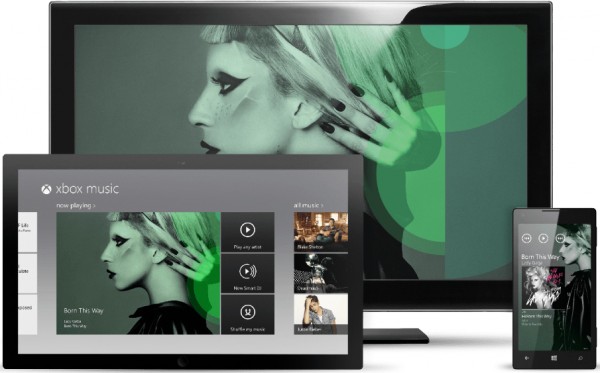
I had great hopes for Xbox Music when announced in October. It’s essentially the best of Spotify, iTunes, Amazon, and Google music services all wrapped up into one. But the sheer number of problems with this initial offering leaves myself and others in complete disappointment.
Xbox Music replaces Zune on Windows 8, Windows Phone 8, and the Xbox 360. The service includes the ability to purchase music a la carte, stream or download songs (via Xbox Music Pass subscription for $9.99 per month), sync playlists across devices, access a music locker, and more. Any tunes you purchase from the Xbox Music store, or playlists you create, sync across devices. Well, that's the idea, except, it’s not working for some people.
I hoped to finally cancel my Spotify subscription but it looks more and more like that’s a long way off. Here’s my biggest struggle with this new service: playlists I create on other devices are not syncing. Additionally, music stored on one device is not picked up by Xbox Music and synced to other PC’s. I created several playlists on my Xbox, but those do not show up on my Surface or Windows 8 Pro machine.
Some of you reading this may not have these problems and things may be going well for you, but there are other people for whom this service is simply not working at all. I opened a post on Microsoft’s Answers Community and within a few days time, others had piggy backed onto my post with similar issues. A recent browse through the Xbox Music forums on Xbox.com reveals even more people similarly afflicted. So obviously these are not a few isolated incidents.
Here’s a screenshot of the sync error. Since I have started getting this error, Microsoft has released an update to the Xbox Music app but nothing appears to have fixed this. If you are getting this error or have other issues with Xbox Music, I encourage you to jump on the Xbox forums or answers community to let Microsoft know.
Personally, I find the company's silence about this issue to be ridiculously sad. While I’m not suggesting Microsoft needs to issue a public apology (as this may only be a problem limited to a few thousand users), someone needs to be more active on these issues and at least let users know that someone is aware of the problem and is actively trying to find a resolution.
Playlist and music sync is not the only problem. Users also report problems with the Xbox Music app not properly scanning and identifying music already existing in their music library. The scan-and-match service apparently is laughably bad at identifying music on the local PC and matching to the equivalents in the cloud.
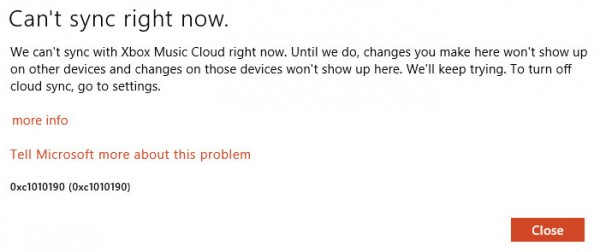
Hopefully Microsoft addresses these issues as soon as possible. Xbox Music has great potential, but right now this service is not at the level it needs to be for me to adopt it as my main music service. Are you using this service? What devices are you using it on? What kind of problems (if any) are you experiencing?
-

Microsoft Surface review for real people
Publié: novembre 15, 2012, 12:25am CET par Robert Johnson
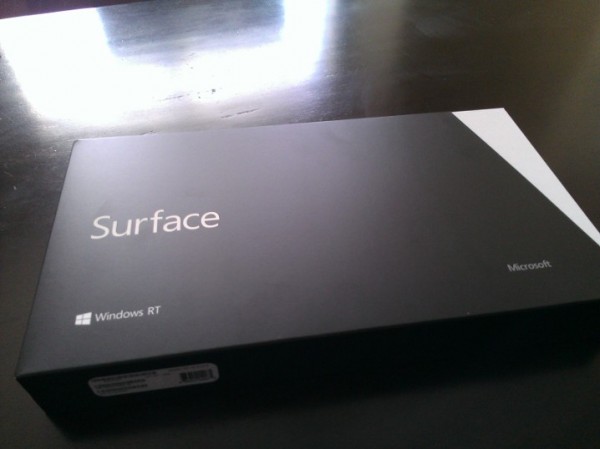
I’ve spent the past couple of weeks reading review after review of Microsoft Surface. I feel like 90-percent of them were not written for me. You see, I’m your average user. I’m the average Joe user with a strong interest in the field of technology. I don’t care about pixel densities, or all the other niggles on performance tech geeks fight about all the time.
What matters to me: Does a particular device allow me to not only consume content but create it as well. And Surface accomplishes those two goals tremendously well. I write this review on a Surface RT using Microsoft Word in Office 2013.
While other reviews read like they are written for tech geeks, knocking the Surface for things the rest of us don’t even care about or even understand, I write this review for the rest of us: people who want to know how well this device allows them to consume and create. Hopefully this is something you can send to the non-techie users in your life.
There will eventually be two Surface tablets available, one running Windows RT and the other Windows 8 Pro. Surface RT is exclusively available from Microsoft, and comes in three configurations: 32GB ($499), 32GB with keyboard cover ($599), or 64GB with keyboard cover ($699).
Hardware
I own an iPad and Nexus 7. I recently sold my HP Touchpad, which I purchased from the massive firesale that happened last year.
As much as I wouldn't want to admit it, anytime someone asked me, “What is the best tablet I could buy?” I hands down told them, “The iPad.”
Not anymore. Based on hardware alone Surface is elegant to behold and feels incredibly solid in the hands. The VaporMg casing makes the Surface feel like a quality slab of computing magic. The device excels with three very important ports: HD video out; USB 2.0, and microSD. Here’s what that means.
The HD video-out port allows you to connect the device to a secondary monitor enhancing your ability to get things done on this device. Sometimes you will need more screen real estate while using Office, and Surface allows you to do just that. You can purchase a dongle from Microsoft for about $40 but you can save some money by getting a Micro-HDMI adapter from Amazon for a few bucks.
The USB 2.0 port allows you to plug in a USB device like an external hard drive or flash drive to store extra content. Similarly the microSD port allows you to expand the hard drive space as well. I think this will be of tremendous value to users. At this time you cannot expand the iPad with USB or even a microSD port.
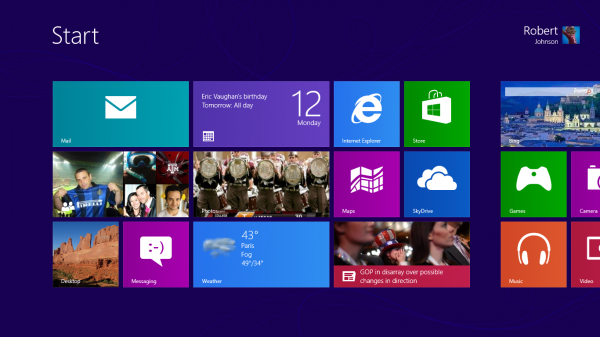
Keyboard Input
Probably Surface's single most innovative feature is the keyboard input. Microsoft offers two options, Touch Cover and Type Cover. The Type Cover is much closer to traditional keyboard input, and I was able to test one while waiting in line at the Microsoft store in my area. But the Touch Cover is what I purchased and is what I am using to write this review.
Microsoft Store reps made a point to say that it takes a few days to get used to the Touch Cover. But as soon as I unboxed my Surface and attached the cover (which is a cinch) I was able to knock out a solid paragraph with ease.
There are a few things here and there I need to get used to like shifting to all the ancillary keys like backspace and punctuation; but so far it has not been a huge deal at all. I love the Touch Cover and the sound Surface makes as I type.
Your mileage may vary. But the bottom line is that some people may prefer the Type Cover over the Touch Cover. Regardless both are a win for Microsoft and most importantly the consumer.
Surface has a magnetic connector similar to MacBooks for charging the device. Once connected a small light at the end of the connector illuminates. A few other reviews mentioned difficulty establishing the connection but I have no problems. One reviewer complained about trouble attaching in the dark. That's exactly the first environment I needed to charge my Surface. After a long day of using the device, I was exhausted and took Surface into my bedroom (which was dark). I had no problem establishing a connection in a dark room.
Battery Life
In the first three days of using Surface, I charged it twice: once for an initial charge and a second time because I actually used it from full power until the battery drained. The tablet arrives with at least 50 percent power. Once that died down on Sunday morning (I purchased on a Friday), Surface powered back up to full in just a few hours. One can easily get more than a full day of use out of this thing. This is after setup, installation of multiple apps, and Windows Update. I also downloaded Angry Birds Space and played it throughout the day as well as other games. Battery life was more than sufficient. You will be well pleased with the performance of Surface as it relates to battery life.
My general day-to-day use consists of web browsing, email, Facebook, Twitter, Xbox SmartGlass and content creation using Word.
Display
Surface has a 10.6-inch display at 1366 x 768 resolution. What that means is, you can view apps side-by-side. The display is very bright and crisp. Colors pop. Text looks gorgeous and is readable from just about any angle. As a test, I held the device flat at eye level and was able to read text on the screen. One major benefit of the Surface display: Microsoft includes anti-glare technology that significantly reduces glare on the screen. This is a major win for me.
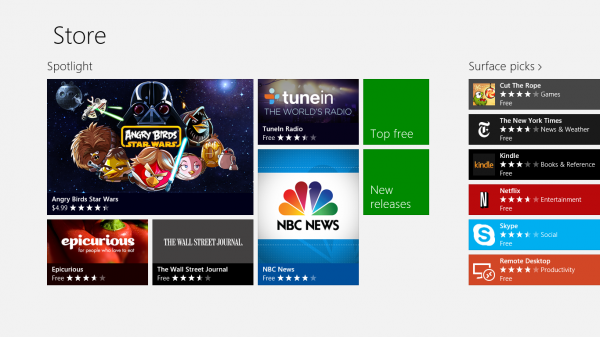
Performance
While writing this review Word crashed on me. That was because I was using the preview version. Since updating to the final version I haven’t had any problems. Surface is a very responsive device that really shines when beaming photos or video to the Xbox.
The Software
Surface runs Windows RT. This is important to note because it means that you cannot install any desktop software on it (forthcoming Surface Pro supports older software). All applications must come from the built-in Windows Store. For instance, you cannot install Photoshop Express or PaintShop Pro, or any other desktop-based software. But this doesn’t mean that you cannot use the tablet to create content, quite the contrary. Surface is one of the best mobile devices on the market today for creating content, particularly because it comes with Office apps installed.
Independent studies of the mobile marketplace show that the most requested app for tablets is Microsoft Office. Four Office 2013 applications -- Word, PowerPoint, Excel and OneNote -- come preinstalled on Surface RT. These are complete, fully functioning versions of these popular productivity applications. Outlook is not included. Office 2013 integrates with SkyDrive for saving and storing documents. There’s no setup involved. It simply just works right out of the box.
Why is this important? You may hear at some point that the 32GB Surface comes with only about 14GB of free space because the preinstalled software and operating system takes up the rest. That’s really not as bad as some make it out to be since most of your content is stored on SkyDrive. I have a second PC that is a desktop. It has all my photos, music and other important files. Xbox Music scans my music folder, storing the equivalent of those tracks in the cloud so that I benefit from not having to download them to my Surface. My photos are stored on SkyDrive. And any additional files or media content are accessible by logging into my SkyDrive account, selecting my desktop computer from a list of device names and choosing the drive where my files are stored. The cool thing about this feature is that SkyDrive exposes the full contents of your computer, including all external drives plugged into the USB port. Let that sink in.
It gets even better. SkyDrive is not the only way for me to access the contents of my desktop. Windows RT allows the Surface to join a HomeGroup. This is a much faster and recommended method of accessing files on another Windows 8 (or Windows 7) PC since the content is being pulled over the home network and not the Internet.
This is quite handy for someone like myself who has a ton of movies on an external drive connected to my desktop. I can access that machine using Explorer on the desktop and use the play to feature to stream the movies to my Xbox, all without leaving the couch.
Ecosystem Integration
This leads me to talk about one of the biggest advantages of owning a device like the Surface, the Windows Ecosystem.
An ecosystem is much greater than the number of apps in an application store. The Windows Store has a little over 10,000 apps at the time of this writing, which pales in comparison to Apple and Google stores. When purchasing a tablet, laptop, phone or any other computing device it is important to consider the overall ecosystem around those devices. You are getting the device itself but buying into an entire ecosystem.
I will be the first to say that the Windows ecosystem is the most compelling on the market. Let me explain. The single weakest part of this ecosystem is the low number of mobile applications. I suspect that will change quickly over time. The Windows Store is surging and quality applications are being added every day.
Device integration is a critical part of an ecosystem. Windows 8 takes device integration to an entire new level. While Apple has done well with iPhones, iPads and Macs to communicate with their Apple TV device, iCloud is woefully incomplete, which makes getting content from the cloud to your TV a challenge. We won’t even talk about Google, which can't compete with the breadth of device types that Microsoft and Apple platforms enjoy.
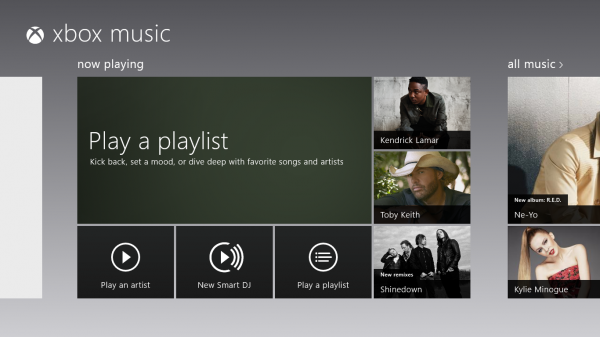
With Windows things are much more complete and robust. Xbox Music allows you to sync playlists and music files between the Xbox, PC, tablet and phone. When you think of Xbox Music, don’t just think iTunes, Amazon Music, Google Music or Spotify. Xbox Music is the equivalent of all those services combined. That’s not a small thing because for a small monthly fee you can subscribe to get access to the entire music library (including music videos) like Spotify; scan and match tracks on your computer like iTunes; and store your music files in the cloud like Amazon’s music locker. This is a monster music service and should not be taken lightly.
SkyDrive is the equivalent of what Apple calls iCloud. But it also works like Dropbox. Files stored in the SkyDrive folder on your PC are automatically synced to your other devices where SkyDrive is stored. In Windows RT, SkyDrive is available from the Windows Store and content can be uploaded from Surface into your SkyDrive from within the app. SkyDrive sits at the heart of the Windows ecosystem. Files from Windows devices are immediately available through SkyDrive including files on external hard drives connected to a Windows 8 PC. SkyDrive also has apps for Android and iOS devices. Windows Phone also automatically uploads photos to SkyDrive. So no matter the device you own, SkyDrive keeps all your content in sync and immediately accessible.
Keeping documents and media files in sync is one thing, but what if you want to view that content on a larger screen? Let’s say you have some friends over and you want to show them photos from the recent family trip. Your photos from the trip are stored on SkyDrive and it’s not very convenient for everyone to crowd around your Surface to look at photos. So what do you do?
It’s simple. Open the photos app which will automatically pull in photos from your SkyDrive account. Open up the devices Charm (swipe from the right of the screen) and select your Xbox from the list and you’re done. It’s that easy. Integration with the Xbox is even more compelling with the new Xbox SmartGlass app that turns any Windows 8/RT/Phone device into a second screen allowing you to control media playback such as movies, photos, and games from the device itself.
For instance, if you are a fan of the popular HBO show Game of Thrones, you will be happy to know that a second screen experience is being developed for the next season that will allow you to see bios of characters currently on the screen as well as a map of the current location. I find Game of Thrones a challenge to follow so I welcome this technology heartily. SmartGlass will also work with certain Xbox games allowing you to draw up plays in Madden for example.
The more Windows devices you own (laptop, desktop, tablet, phone, XBOX), the ecosystem is structured such that these devices are significantly better together.
Your Next Purchase
After two weeks of use, Surface just keeps getting better and better. I rarely use the iPad except for a banking app. Surface is the perfect device for consumption and creation. That is, until the Surface Pro releases. A buddy texted me the other day asking me how my experience with Surface has been. I told him, "Once the honeymoon phase is over, you realize that you really do have a tablet that is more powerful and capable than anything on the market".
Simply put, Surface RT is better than the iPad and here’s why:
Allows for a connection to a second screen. I mentioned this earlier but you can connect an external display to Surface using the micro-HDMI port. This allows you to put the Start screen on one display (Surface), while you work in the desktop on the other screen.
Includes a full version of Microsoft Office. I could never write a review of this magnitude on the iPad. Think about that for a moment. Even though Surface is not fully a PC, since installation of desktop apps is prohibited, it is much more capable at creating content, if for no other reason than full version of Office 2013.
Adobe Flash support. Internet Explorer on Surface supports Adobe Flash for approved websites. There’s no need to install an extension (which is prohibited anyway). Flash comes preinstalled and is automatically updated by Microsoft.
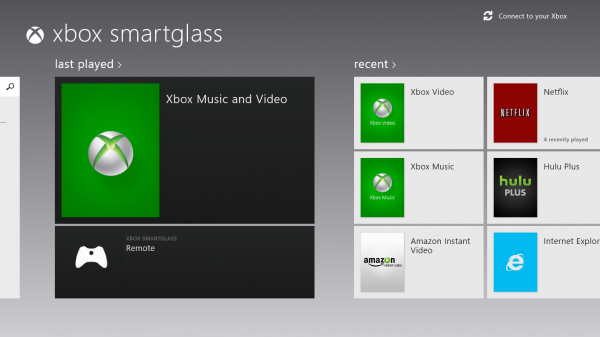
Connect to 400 million external devices. I have a wireless printer that I did not have to install drivers for. Surface simply found the peripheral and allowed me to print to it out of the box. Microsoft created a website that allows you to check if your device will work with Surface.
Integrated Keyboard. Although there are myriads of external keyboards you can connect to the Surface, two models come with a detachable keyboard cover.
Multiple User Accounts. These are not profiles that work under the same user account. These are completely separate user accounts that allow each user to customize the environment to his or her own liking. Additionally, this allows each user to sync settings, calendars, email, bookmarks and other preferences. By contrast, iPad is limited to one account only.
Fully Functioning Windows Explorer. The desktop contains the full Windows Explorer experience that allows you to connect to HomeGroups, as well as any other devices on your network for moving or viewing files on your Surface, or for pushing to your Xbox 360.
The Verdict
Surface is fantastic. There’s no tablet like it on the market. If you’re looking for a mobile device that allows you to play casual games like Angry Birds and write a book report in Word, Surface is your choice. Concerned about apps? Don't be. The Windows Store is new and surges with quality apps at an alarming rate. Some are even exclusive to the Windows platform. Concerned about viruses and malware? Don’t be. Windows RT comes with built-in security protection. You don’t have to worry about viruses at all.
Surface RT is not a full laptop replacement, but it’s definitely more capable than iPad or Android tablets.
If I were giving the Surface a numerical rating (out of 10) it would look something like this:
Hardware: 9.8
Software: 9.5
Workability (ability to get real work done): 9
Ecosystem: 9
Overall Rating: 9.3
-

Desktop on Windows RT makes sense
Publié: octobre 28, 2012, 8:25pm CET par Robert Johnson
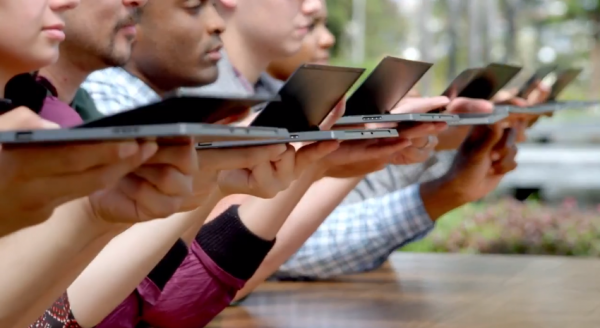
Friday, October 26, Microsoft released its highly anticipated Surface RT tablets to the masses. I was able to snag one of these devices and spent most of my weekend in the web browser reading reviews that questioned Microsoft’s so-called "curious inclusion" of the desktop. Perhaps I’m missing something but I don’t understand why there is so much angst about the desktop in RT. Some people don’t understand why the desktop is there but I think it makes complete sense.
To be fair, I really do understand that to other reviewers of RT the desktop is only limited to MS Office applications and few other MS included apps like Notepad. Additionally, RT does not allow x86 apps to run or even be installed. That being said, I get the feeling this limitation due to the platform running on the ARM architecture is temporary.
I find the inclusion of the desktop to be a sign that Microsoft is looking to a future where the following characteristics will become a reality:
1. A curated distribution of all desktop apps that will severely limit issues with malware but won’t completely eradicate it. A curated distribution center also makes life simpler for average users when finding and installing the best apps: they don’t have to go through the guessing game of "can I trust this app?"
2. This leads to a new breed of touch, keyboard/mouse and camera input-friendly desktop apps. Microsoft will finally be able to standardize the user interface of what is currently a software ecosystem of disparate applications with no seeming consistency whatsoever.
How does Microsoft get here if it doesn't allow desktop applications to be installed? It’s called Click-to-Run and if you installed Office 2013 from the web you have experienced this. Click-to-Run allows for amazingly fast and simple installs. Could Microsoft expand this technology to other applications like Adobe Photoshop and allow these applications to be recompiled to run on ARM? Perhaps so. This is one of the reasons I anxiously await to see what happens at BUILD 2012, where Microsoft has announced that it will have more to say about Windows/RT, Xbox, Windows Phone, Internet Explorer, Visual Studio and a host of other products.
-

Home Shopping Network previews new Windows 8 apps
Publié: octobre 9, 2012, 4:30pm CEST par Robert Johnson
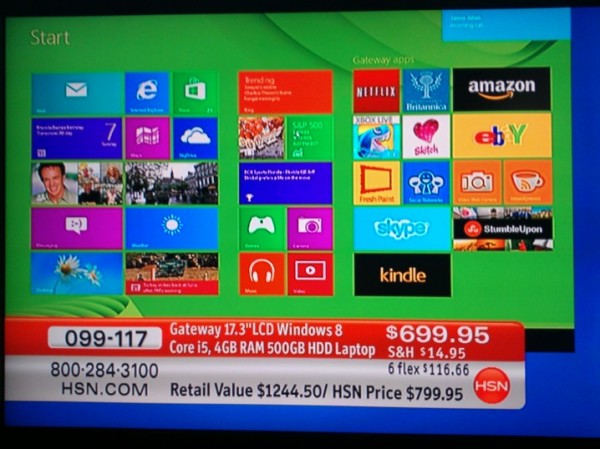
This weekend I got a curious text message from my mother: "I’m watching a presentation of Windows 8 on HSN".
I quickly tuned into the Home Shopping Network channel and to my surprise they were actually doing a pretty decent job of explaining Windows 8 (and offering PCs for preorder). They demoed various benefits of the new OS from the apps to the fact that if users are confused by the new interface, the old legacy desktop is a button press away (the windows key).
What shocked me the most was the demo of the Skype app. We knew it was coming but it raises questions: This app is not yet available in the Windows Store so how were they able to access it? Do OEMs have early access to release-day apps? Also, notice the presence of the Netflix app. We also knew this was coming, I just think it’s interesting to see these apps running on devices weeks before general availability.
I’m excited to see a working version of the app, and I think it is solid execution on the part of Microsoft to get this app ready for the launch of Windows 8. Giving consumers the ability to communicate across devices is an essential element of a consumer strategy.
Photo Credit: Robert Johnson
-

Why would Microsoft limit the Windows Phone 8 Preview Program SDK?
Publié: octobre 1, 2012, 5:29pm CEST par Robert Johnson

Microsoft's plan to only let a few key developers into the Windows Phone 8 Preview Program SDK, understandably upsets many developers. For a plaform with only about 3 percent market share, Microsoft needs all the supporters it can get, or so the presumption goes.
Why lock out most of the people needed to develop apps that take advantage of your new platform? I think there could be two possible answers: (1) a new marketplace strategy based on the quality of apps, and (2) major unannounced features.
Marketplace Strategy
So what if (that's a big if) Microsoft is trying to go for quality by opening it up to a few key developers who will build some well-designed apps. I don't think that's a bad strategy especially since Windows Phone Marketplace, App Store and Google Play are filled with some horribly designed apps. Plus, this gives Microsoft a way to change the conversation from "number of apps" to "quality of apps".
Unannounced Features
Ultimately I think this boils down to some unannounced features and here's why:
1. Related to the marketplace strategy, perhaps these new features will be included in those apps so that they stand out from the same apps on other platforms.
2. WPCentral wrote a post a couple of weeks ago about how the Windows Phone team is intricately involved in the release of the new and updated Kinect SDK. No other site I can think of commented on this, and I thought it was hugely significant.
3. Adding on to #2, if the Windows Phone team is deeply involved in the Kinect SDK, perhaps the big unannounced feature is Kinect/NUI integration. Microsoft has already demoed Xbox to Phone Kinect gaming capabilities. See this video it's not vaporware, Microsoft could be really close to finalizing it's real-time multi-player gaming platform between Windows 8 devices (PC/Phone) and Xbox. I've already seen some of this in Windows 8 with certain games announcing upcoming updates that include pause/resume across devices.
4. It was suspected from leaked early builds of Windows 8 that there would be some sort of Kinect/NUI integration as someone found DLLs in the build indicating such. Also a document leaked years ago outlining some NUI features Microsoft was planning for Windows 8. NUI is one of the most curiously missing features of Windows 8.
5. Microsoft also has a video floating around that demos TellMe doing some pretty amazing things.
6. BUILD. Microsoft implied that BUILD will have some surprises. It makes a lot of sense if NUI is an upcoming add-on (project Blue perhaps?).
7. The Surface factor. No one can get close to this thing let alone touch it. Ballmer was recently at a developer event where he showed his Surface (!!) and from the looks of it, people were not allowed to play with it. Limited use of upcoming Windows Phone 8 devices and a locked down SDK lead to more evidence that something is being intentionally hidden.
NUI You
This is not the first time I've brought up the whole NUI idea. Remember my bad guess about the secret event from this past summer? I predicted that Microsoft would unveil Kinect integration into Windows and that perhaps this would be demoed on some upcoming Windows 8 device. Obviously I was wrong, but I still think Microsoft is working on this. I've long been a fan of Microsoft's approach to Natural User Interfaces.
So far, they are way ahead of the competition. Don't forget, they've been collecting tons of data from millions of Xbox machines attached to Kinect devices. I think NUI is a major way Microsoft can set their devices apart from the rest of the crowd. Many have said that Microsoft needs to follow their Xbox strategy going forward. When Kinect was released, Xbox was not the No. 1 game console here in the United States. Now it is, and Kinect may be the reason.
Regardless of how useful you may or may not think waving a hand or talking to a device actually is, the reality is that it looks cool and gets people's attention. And this is exactly what Microsoft needs in the Windows 8 era. They need to communicate that they as a company can actually do some innovative stuff that is meaningful and useful in a way that enhance people's lives.
What do you think? Is it a marketplace strategy, unannounced features or both?
Photo Credit: AlexandreNunes/Shutterstock
-

Windows 8 is a graphic shift in computing habits
Publié: septembre 14, 2012, 9:36pm CEST par Robert Johnson

Last in a series. If you read tech blogs as much as I do I am sure you have seen a number of articles criticizing Windows 8. Among these are articles that focus on the overall design of the Modern UI and its numerous inconsistencies. I saw a forum post on one website claiming that visual designers hate Windows 8?
The reason, hold on to your seat because this one is a doozy: the Modern UI design language has done away with drop shadows and realistic looking icons; in other words, the interface looks nothing like the skeuomorphic interfaces of Apple and to some degree, Google.
There’s more than One Way to Skin a Cat
As it relates to interface design, skeuomorphism is a way of emulating real world objects in digital form. The major benefit of this design is familiarity. Using a notepad on a computer that actually looks like a notepad helps the unfamiliar application feel familiar.
However, skeuomorphism is not the only design style out there. Believe it or not, there is a growing trend away from skeuomorphic designs towards more simplistic and minimal type interfaces. For instance, see "Where Microsot Has ‘More Taste’ Than Apple". Google has found a great middle ground between the skeuomorphism of Apple interface design and the purely digital of Microsoft’s new Modern UI design language.
Where Google appears to be slowly making the transition from skeuomorphism, Microsoft is going "all in" with their new Modern UI design language. Formerly known as Metro, the design ideas behind the new Modern UI are not new. Modern UI takes advantage of design principles rooted in European design. Minimal, textual, and iconic are a few words that describe the new design language.
As with any design language, skueomorphic (Apple) or hybrid (Google), execution is essential. Apple benefits greatly because it is the platform of choice for interface designers. Google and Microsoft have to work a bit harder to get developers creating well-designed software experiences on their platforms. In fact, I would venture to say that Microsoft will have the biggest challenge because designs based on principles of minimalism, text and glyphish-looking icons are extremely difficult to pull off well. This can be good and bad for Microsoft. Personally, I think it’s a good thing. To work on Microsoft’s new Modern UI platform, developers will need to execute good design in their software applications.
While some people may hate the Modern UI, it is actually very forward thinking of Microsoft, for a change. For the first time in a long time, the software giant is actually ahead of the curve when it comes to design. For a company that is often accused of being "late to the party" isn’t this a good thing? Instead of chiding their efforts in this area, we should rally around them. Is Modern UI perfect? Absolutely not, but it’s a pretty darn good start.
It’s Way Too Early
I remember when Apple first launched OS X. Things just weren’t perfect. But over time, they have finally matured their design language into something that is quite pleasing. We need to understand Modern UI in this same light. It’s early. It’s not perfect, and it will take time to mature into a design language that is essentially pleasing.
I love the new Modern UI, not because of what it is today, but because of the potential for what it can become. Even Microsoft is struggling with how their new language works across mediums such as desktop, print and web. I love the way Modern UI is presented in Windows 8 but I find many executions of it across some of Microsoft’s web properties as well as Office applications to be appalling! But I understand if the company is still working out the kinks in how to properly execute in this area.
My point: we probably shouldn’t judge Modern UI as a finished language. It’s way too early and I think this should be taken into consideration.
The Influence of Consumers
Windows 8 is a consumer OS. There was a time in a previous era (see part 1 in this series) where the design of an operating system was influenced by developer and tech enthusiasts. We are no longer in those times. We now exist in a time where the consumer is the target audience. If you feel that Windows 8 is geared towards them, you are correct. It should be. But it’s important to understand that the design of Windows 8 does not ignore the tech enthusiast because the desktop is still there.
Design is in. Microsoft is right to reflect this in its new modern operating system. Windows 8 is representative of a massive shift in computing habits and their designers are off to a fantastic start in implementing new interface design ideas around mobility.
Large tiles and text blocks are the cornerstone of today’s new interfaces based on distinctly digital designs. Like it or hate it, it’s the new black. You will see many variations on this new minimal approach to design in the future whether it be from Microsoft or some other company. The web is ushering in this new design trend at amazing speed as new and current websites are being designed with new immersive (remember that word???) experiences in mind.
Conclusion
You may not like the new Modern UI design language. And that’s perfectly okay, but realize that it represents a shift towards a new way of designing interface that is currently being adopted by some of the top designers in the world. Please do not take away from this article that sheuomorphism, hybrid is wrong and Modern UI is right. If anything, take away from this article that:
- Modern UI is one of many legitimate design trends.
- Microsoft is ahead of the curve.
- Modern UI has not quite matured and Microsoft is still trying to figure out how to execute it across different mediums from software to web to print.
Let me be clear: There are many design languages, styles and trends out there and designers the world over debate about the benefits and merits of each.
Also in this series: "Windows 8 is a compelling story"; "Windows 8 simplifies computing".
-

Windows 8 simplifies computing
Publié: septembre 11, 2012, 5:00pm CEST par Robert Johnson
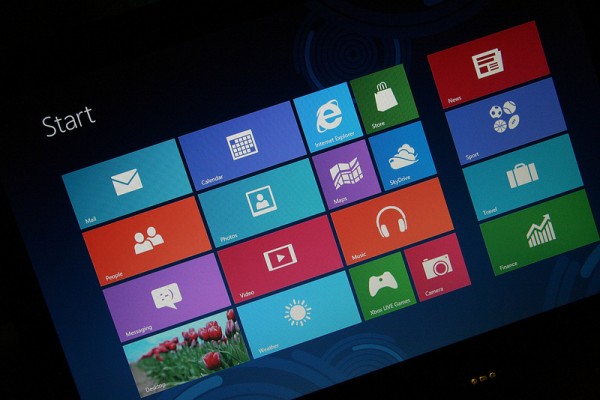
Second in a series. Most, if not all, the reviews of Windows 8 focus on the intuitiveness of the user interface. As a designer/developer I think lots about creating good UI and user experience (UX). What's seems important to product reviewers or techies is meaningless to Microsoft's target audience of Windows 8 users.
I’m here to tell you that there’s more to the analysis than intuitiveness. UI designers who are really serious about designing compelling user interfaces know that intuitiveness is not the only aspect to consider, there’s also learnability and discoverability that are essential to UI design and development.
Learnability and Discoverability
Learnability has to do with how easy or difficult it is for a user to learn an interface. Discoverability has to do with how easy or difficult it is for a user to discover certain features of a UI. Both are essential aspects of user interface design and development, and user experience professionals who have the responsibility to be involved in testing UIs understand the need to consider learnability and discoverability in conjunction with intuitiveness when it comes to designing usable interfaces.
Intuitiveness can actually be an enemy for UX professionals tasked with designing and testing complex interfaces. To design an intuitive interface, a UI designer needs to lead the user towards completing certain tasks using visual cues. This involves adding more UI elements to an interface that while on the surface may appear to be easier to use, may actually prove to be unusable in user testing. So while intuitiveness is a critical aspect of designing interfaces, discoverability and learnability are just as important.
The Problem with Windows 8 Reviews
Many reviews I’ve seen on tech sites and forum postings that deal with Windows 8 usability, only focus on the intuitiveness of the interface. This is a mistake in my opinion. For instance, one review I read called out the “so many bizarre UI decisions…that it’s hard to know where to start, but having to swipe up to simply reveal basic controls…doesn’t feel quick or intuitive as it should be”. This review assumes intuitive is the only goal of software design. That’s simply not true.
When you install Windows 8 you get a simple one-screen tutorial that explains to you that to get to critical commands you swipe from the sides of your screen. The tutorial demonstrates the swipe from the right side that reveals the charms menu. This happens while you’re waiting for the installation to complete. Users will know that if they get stuck somewhere they can always swipe from the right edge of the screen to get where they need to go. Is this intuitive? Absolutely not, but because of the tutorial, it’s easily learnable. So instead of criticizing this as a “bizarre UI decision” this should be cast in a more positive light.
Applications that perform one function like Notepad can be built such that the only design goal is intuitiveness. But as applications get increasingly complex, such as Microsoft Word, this becomes impossible and UX professionals have to hide various aspects of the interface behind popups and other menus that appear from other parts of the UI. The challenge for these professionals is not so much whether or not these features are intuitive (even though they can be); the challenge is whether or not these features are discoverable and once the user discovers them are they easily learned.
Windows 8 is not going to be intuitive in every aspect of the interface. That’s impossible for such complex software. But Windows 8 is definitely learnable and its features are discoverable. Let’s say, for example, a user does something that takes them from the Modern UI into the desktop and for whatever reason they are stuck and want to get back to the start screen. They remember they can swipe from the right or move their mouse cursor to the top right of the screen to get the charms menu and go back to the Start screen.
Is this a success or a failure? It’s a success and here’s why. The user remembers a learned behavior: swiping from the right to see the charms menu. The point I am trying to make is that for previous versions of Windows, the Start button was a safety net for the average user. With Windows 8 it’s the same thing, just moved to a different side of the screen.
I recently read a review that surfaced a number of Windows 8 annoyances. All of them had to do with the lack of ability to customize various aspects of the interface. For instance, the review mentioned how easy it is in desktop mode to hit the Internet Explorer icon when you want to click to go back to the start screen. How is this a problem? Users only need to make the mistake one time before they realize they need to move their cursor a little bit further to the left. The entire review read like a series of straw men built to rip apart features of an OS that likely will not be a concern for non-techie users.
About those Non-techie Users
Why mention the non-techie user? Because they matter big time. The reason goes back to what I said in part one of this series. Windows 8 is representative of a massive shift in our culture from an experience economy to a simplified experience economy. When Microsoft designed Windows 8, I am pretty certain they did not have techies as their main target audience. Windows 8 is designed for consumers as it should be. In the experience economy, consumers rule the roost, not businesses, and certainly not techies like us. So if the Modern UI does not allow you to multitask like you are used to doing in the desktop, that’s not a bad thing at all. As times change, so do our computing habits. It’s time for us to learn new ways of using our machines.
We no longer live in a world where businesses and techies drive the design of complex systems like today’s modern OSes. Software is becoming more and more simplified. This means that customizations will be simplified, and experiences will become more immersive (full screen apps). Users are getting less choice because too many choices in the previous era was too overwhelming. Users want everything in a nice neat package that is easily accessible. Despite the fact that developers piss and moan about Apple’s walled garden, the average user doesn’t care at all. They know that the apps they download are safe and they do not have to worry about viruses or malware.
Choice adds too much complexity to today’s software experiences. But let me be clear. I am not suggesting that today’s users do not want choice at all. I’m merely suggesting they do not want too much choice. There’s a big difference between having to choose among a dozen different laptop configurations versus three configurations.
This Is a Completely New Ballgame
Reviewers should take into consideration that we now live in a new era where choice is limited, software is complex yet simple and interfaces are not designed based on intuitiveness alone. Windows 8 represents a simplification of computing that will resonate with the general consumer in ways that piss off many techies. We can either get with the ballgame or die on the vine.
Tech sites will do us all a favor by posting reviews that are geared toward the general consumer because that is where a lot of the advances of Windows 8 exist. Will businesses benefit from Windows 8? Sure. Techies? Of course. But most of what is Windows 8 is geared towards the consumer. We simply cannot assume general consumers think the same way we do.
The Failure of Intuition Alone
I have a second-generation iPad. When I first got it, I had no idea that I could do global search. This was a feature that was not immediately intuitive for me. However, I eventually discovered it. So here’s my question. If I’m writing a review of the iPad, do I cite this as a negative simply because it was not immediately intuitive? Or do I cite it as a positive that even though it was not intuitive, Apple UX engineers took advantage of a learned behavior (swiping) to make it discoverable as opposed to intuitive?
It’s not just about whether or not it’s intuitive. Consider other factors. You may not have immediately known how to use a feature but did you eventually discover it? Was it easy to learn how to use it? Windows 8 does an excellent job at this and the Microsoft user experience team for Windows should be commended instead of chided for making an OS where content creators like myself can easily create in the desktop and consume in the modern UI.
In my next article I will explain why the design of the Modern UI is right and how Microsoft foresaw a design trend that even the most popular designers are adopting.
Photo Credit: Pete
-

Windows 8 is a compelling story
Publié: septembre 10, 2012, 4:38pm CEST par Robert Johnson
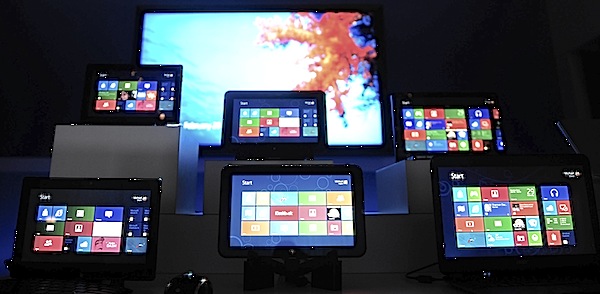
First in a series. Over the past few months I’ve seen several articles and forum postings negatively criticizing the design of Windows 8; from the flatness of the UI to design inconsistencies on the desktop. I’ve also seen articles asserting how difficult the operating system is to use because it’s not instantly intuitive.
While I think there are some valid concerns in these articles about Windows 8, I personally believe that most of what has been written is shortsighted. I hope to prove this over three articles.
My Mini Review
I really like Windows 8. In fact, it is now my ultimate favorite operating system. As a designer/developer I spend a lot of time in the desktop. Over the past several weeks I’ve seen many photos of the new flattened desktop from leaked builds. I’ll be honest: it did not look very good. I was concerned that the design team had gotten it wrong. Having installed the OS recently, I find the new flattened look to be very pleasing on the eye. Instead, the design team did a great job on the new desktop UI. While not perfect (more on this later), it’s a pretty darn great start.
Windows 8 is a complete rethinking of what a traditional desktop operating system can be. What we are used to having in mobile devices (social connections, cloud connected, and access to media content) are now baked right into the OS.
The People app is an aggregation of all the important folks and other contacts in my life across Facebook, Twitter and Google. SkyDrive syncs my important content across devices and allows me to log into my drive online and access the full hard drive (internal and external) of every device on which I have installed SkyDrive. This is a very convenient feature that has already saved me from tight situations.
Not only does Windows 8 bring my life together, it also brings my devices together. I’m sorry but, I do not buy into the post-PC bull crap trumpeted in the Apple-loving tech press. PC-plus makes way more sense to me and is especially evident with how Windows 8 blurs the boundaries between devices in my home by making media and other content accessible virtually anywhere.
Homegroup is one example. It’s been vastly improved and simplified. Joining a homegroup from two devices is as simple as clicking a button, “Join”. Immediately I go to my desktop PC and tablet and am able to see content from both devices. I have a lot of stuff on my desktop and obviously my tablet has limited capacity. So what makes homegroup even more beneficial is that I can use my tablet while sitting on the couch in my living room to access content from the desktop in my office. And if this content is music or photos, I can immediately shoot them over to display on my TV screen through the Xbox.
There’s a ton to like about Windows 8, and I think a lot of consumers are going to resonate with it. Those of us who are techies will always find something about the OS that appeals. But the truth is, the typical consumer just doesn’t care about a lot of the stuff we care about. They want access to their contacts, content and services no matter where they are. That’s what my mom cares about and that’s what my non-techie friends care about.
A Fundamental Cultural Shift That Affects the way we Compute
Windows 8 is not anything like Windows 7 from a big picture. Windows 7 represents the traditional OS: (1) mouse and keyboard centric; (2) siloed applications; (3) non-cloud connected; and (4) non mobile. You can probably add to that list. Windows 8 is representative of a fundamental shift that is happening at a much higher level, a cultural level: the transition from a services-based economy to an experience-based economy.
In a services economy people care about goods but more importantly they care about the services surrounding those goods. For example, company A sells a computer and company B sells a computer. But what really differentiates the two? In a service economy, a potential buyer may certainly see that company A sells a much faster and powerful computer than company B but the consumer purchases from company B. Why? Because company B offers additional services for free on top of purchasing the computer.
In an experience economy services become the stage and goods are the props used to engage the individual in a conversation and immerse them in a story. Services are not enough because they are not as memorable as experiences. In an experience economy, people spend money on services that offer them the best overall experience. Let’s return to our previous example.
In an experience economy, the user chooses to purchase from Company A (where as in a services economy they purchased from Company B) because this Company A, (1) not only provides them with a powerful computing device; (2) offers them amazing services; but (3) stages these services and goods in a fashion that the user is drawn to. Goods and services all remain outside the buyer while for the first-time experiences allow companies to get inside buyers and manipulate them emotionally to purchase their products.
Experiences are inherently personal. Through an experience an individual can be engaged not just on an emotional level, but on a physical, intellectual or maybe even a spiritual level. Experiences remain with the individual for some time to come.
Windows 7 is representative of services economy thinking. OS X is representative of experiences economy thinking. Apple saw the transition to an experience economy back in the late 90s while Microsoft probably did not. When Windows 7 released it appeared Microsoft was finally getting the transition but couldn't execute on it properly. Apple, executed beautifully across their product portfolio and resulting marketing.
With Windows 7, Microsoft offered all kinds of services along with the purchase of Windows 7 such as, free Windows Live Essentials applications like SkyDrive, Movie Maker, Messenger, Live Mesh, etc. So did Apple offer services. But why was Apple’s offerings much more desirable for consumers? Because of the way they were staged. Apple staged the same service offerings as something that improved the livelihood of users. Even more so they staged them as experiences that were extensions of the main computing experience.
In techie terminology Apple advertised these extra products as if they were a significant part of OS X. They were bundled with the OS. For Microsoft, this was not so. Maybe this was a consequence of anti-trust issues but Windows Live Essentials was an extra download and install. Not only that, it was difficult for users to even know they existed!
Windows 8 tells a story that is more representative of a new way of thinking about computing habits and behavior. It is representative of a shift towards an experience economy but more specifically it represents a shift to a new kind of experience economy: a simplified experience economy.
Web developers are responding to this trend in computing by implementing what is referred to as responsive designs. Responsive websites adjust based on the device that accesses the website. Developers create one web design that automatically adjusts the user interface elements for a mobile device or a desktop device. The result for the end user is that no matter what device the user uses to access the website, the resulting experience is appropriate for that device.
Enter Windows 8. The first “responsive” operating system that is flexible enough for users who want to use it on a tablet in a mobile (no keyboard or mouse) scenario and is also flexible enough for users who want to use it in a truly desktop (mouse-and-keyboard) scenario. But what is most amazing is that it is so flexible that if I am on a desktop I can use the mobile interface. Is it perfect? Absolutely not! But it is usable!!
The problem with many Windows 8 reviews: they focus primarily on usage scenarios that are not quite ideal. Using a mouse and keyboard on an interface designed for mobile is not going to be perfect. It’s not always intuitive, but it is discoverable and learnable (more on that in a future article).
The primary usage of the Modern UI is touch. The primary usage of the desktop is mouse and keyboard. Neither scenario is going to be perfect for the experiences they were not designed for (mouse in Modern UI and touch in desktop UI). So let’s stop reviewing the desktop interface as if it needs to be perfect for touch because it’s impossible. And let’s stop reviewing the Modern UI as if it needs to be perfect for mouse and keyboard, because it’s also impossible. Both interfaces are usable regardless. And there is absolutely nothing wrong about that.
What Microsoft has done is meld touch and mouse into two interfaces that require the user to transition between the two at times. This transition may not always be ideal. I get that. Windows 8 is a massive undertaking and even for a company as big as Microsoft, there are not enough designer resources to transition every aspect of the desktop into a touchable interface. That’s why I’m willing to cut Microsoft some slack Windows 8 is 1.0 in this new transition, and it will not be perfect for any of us.
It’s not as easy as You Think
As someone who designs interfaces for business applications, I understand all too well how difficult it is to transition interfaces to a more modern design. Sometimes you are limited by the sheer amount of resources you have at your disposal to handle design and user testing of those designs. The desktop interface is so pervasive and expansive that it will take years before Microsoft can fully transition to touch. The same is true for the company I work for as well.
But what if transitioning those interfaces (interfaces designed for desktop) to touch is not the best idea? What if it’s acceptable for some interfaces to remain primarily mouse and keyboard focused? Content developers like myself and many of you will continue to use the mouse and keyboard.
Content creators will need interfaces that adhere to our needs into the foreseeable future. Windows 8 presents what I believe to be the best opportunity for content creators: an interface that allows us to use content creation apps like Adobe Photoshop, and at the same time allows us to consume content when we’re mobile such as when visiting clients.
This is where the potential of the Surface tablet exceeds anything on the market today. Having a device like the Surface pro where I can slide it into a docking station, connect it to an external monitor and create engaging user experiences in Photoshop or any other number of content creation software, then take the same device into a meeting is a compelling user story. If I can display those ideas in a touch interface when meeting with a potential client, that’s an even bigger win.
Photoshop does not exist on a single tablet today (yes, I know about Adobe’s mobile applications but those are not the full Photoshop versions). But it will when Microsoft ships the Surface Pro.
My point is this: Windows 8 is a compelling story. It represents a change in computing behavior augmented by an even bigger change in our culture: from an experience economy to a simplified experience economy. If reviewers can look at the OS in this light, I think they can present reviews that may actually help be people understand why Windows 8 is architected like it is.
Microsoft’s user experience team nailed it. Although the interface has its issue, they aren't as drastically detrimental as many articles on BetaNews and other sites seem to imply. The UX team of Windows 8 lead by Julie Larson Green has done a fantastic job of user testing. They have vetted out the critical issues that impact the adoption of Windows 8, issues that may cause techies to grumble but will engage the typical consumer intellectually, emotionally physically and possibly spiritually, in ways that are memorable and engaging, but most importantly in ways that no other tablet on the planet can accomplish.
Conclusion
Windows 8 simplifies computing in such a way that Apple CEO Tim Cook’s comments reveals Apple could possibly miss the transition to a simplified experience economy in the same way that Microsoft missed the transition to the experience economy back in the early 90’s. The unification of the desktop and Modern UI is a good thing. Microsoft getting into hardware is a good thing regardless of OEM concerns (I’m looking at you Acer).
In my next article I explain why reviews solely claiming the Windows 8 UI is not intuitive are inherently shortsighted.
-

Why isn't Windows Phone more successful?
Publié: juillet 19, 2012, 8:58pm CEST par Robert Johnson
 As Nokia reports its earnings, I can’t help but feel bad for the company's efforts here in the United States. To me, 600,000 units in North America (and supposedly that includes other devices besides Lumia 900) is not exactly what I would call a win.
As Nokia reports its earnings, I can’t help but feel bad for the company's efforts here in the United States. To me, 600,000 units in North America (and supposedly that includes other devices besides Lumia 900) is not exactly what I would call a win.But that’s just me. I’m a Windows Phone user. It’s a fantastic platform. The interface is gorgeous, and the OS is fast. I haven’t had issues with Windows Phone that I have had with Android. So in my opinion, the platform deserves a spot at the table with Android and iOS. So why hasn’t it been very successful?
The Problem
I think it partly boils down to one thing: no one knows about Lumia Windows Phones. That’s a massive marketing problem. Some will say it's apps but I'm not so convinced that's still as big a deal as some make it out to be. Remember Rolling Thunder, Nokia's big marketing campaign for Windows Phone? So far it’s been a rolling dud! Maybe I don't get marketing but it seems to me that in order for them to recover and get the sales they need, there should have been a more consistent television marketing campaign in the United States. There is no reason our TVs should not have been bombarded with Nokia and Windows Phone advertising during major television events like the MTV Awards or other popular shows during season finales.
Nokia CEO Stephen Elop promises a ton of marketing from Microsoft for Windows Phone 8. If I simply look at Windows Phone, I have no confidence in Microsoft marketing. Maybe that will change. They've said these things before and have not delivered. Microsoft, AT&T, and Nokia should be ashamed of themselves. It boggles my mind that for a platform that so desperately needs marketshare/mindshare, how incredibly silent they were during critical television programming. Unbelievable.
On the flipside, I will say that shipping 4 million Lumias is good for Nokia’s pocketbook, but selling possibly only 300,000 Lumia 900s in North America is dreadful for Windows Phone's ability to get into the minds of smartphone shoppers and produce activations. In other words, for Nokia, 4 million shipping devices is good because of the high profit potential, but if only 600,000 of those are activated in North America, that’s really not a good thing for Microsoft.
Ray of Hope?
As much as I hate to admit it, Windows Phone in the United States is a disaster right now. Again, that’s coming from a very satisfied user. I really think Microsoft screwed this one up big time. But it looks like they are learning their lesson with Windows 8.
I really think Windows Phone can make a strong comeback in version 8, especially with how strong the Microsoft ecosystem is looking: Xbox, SmartGlass and Music, SkyDrive, and overall integration of their services into all their products. However, I will be surprised if Windows Phone succeeds on its own merits. It will have to be on the backs of Xbox and Windows 8.
I predict that even if Windows 8 sells half as many licenses as Windows 7 (and it will, write it down!), it’s a smashing success because Microsoft will have migrated hundreds of millions of customers to a modern OS which will get them accustomed to Metro. This will encourage more users to make the transition to Windows Phone 8. But Microsoft cannot afford to depend on the interface (UI design) and hardware (Lumia) as the only differentiators from iOS and Android.
What’s the Differentiator?
Windows Phone needs a "cool" feature that grabs attention. I really believe that's natural user interface integration (e.g., Kinect) into mobile devices. NUI is the next big thing in tech and Microsoft needs to be there first. They have the technology and platforms to make it work. Three years of usage data with Xbox Kinect is a major advantage.
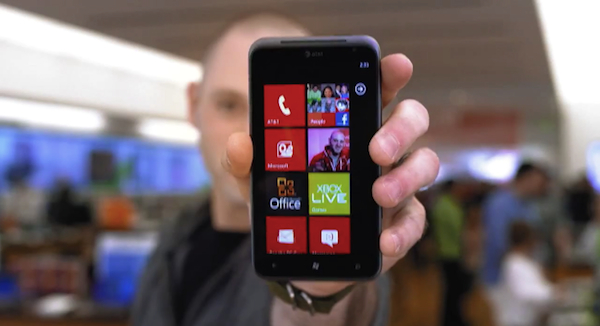
Kinect rejuvenated Xbox sales taking the console to No. 1 status globally. But perhaps something else is needed even more: major carrier support. Right now, Sprint and Verizon are barely on board with Windows Phone. If Verizon pushes Windows Phone as strong as it did Android things could change significantly.
Is the Future Bright?
I personally am not ready to give up on the boys in Redmond and their friends in Finland. While Windows Phone does not have feature parity with iOS or Android right now (apps anyone?), early signs look like that will change. It’s a fantastic platform and has loads of really amazing potential. Microsoft is a patient company and they have proven their ability to iterate over time and eventually trump their competition -- remember when Sony and Nintendo had the top game consoles? You don't.
For the record, I do not believe Nokia is doomed because of their earnings: globally, Nokia doubled Lumia shipments from Q1 to Q2. I also do not believe Windows Phone is toast. What I do believe is that things may get worse before they get better and that the current state of the Windows Phone platform in terms of marketshare is in a pretty dismal state partly (mostly maybe?) due to marketing missteps.
 Robert Johnson is a user interface developer specializing in the user experience (UX) of .NET-based web applications. He has been working in some form of web development and graphic design for 14 years. He loves technology in general, particularly that of Apple, Google and Microsoft. He is a Betanews reader.
Robert Johnson is a user interface developer specializing in the user experience (UX) of .NET-based web applications. He has been working in some form of web development and graphic design for 14 years. He loves technology in general, particularly that of Apple, Google and Microsoft. He is a Betanews reader. -

Nokia could teach Apple a thing or two about customer service
Publié: avril 12, 2012, 4:36pm CEST par Robert Johnson

It’s the biggest product launch of the year so far for Windows Phone and Nokia. The Lumia 900 went on sale April 8th and early reports suggest that sales are better than expected. They're nothing stellar but nevertheless some good news for a platform struggling to gain market share.
Earlier this week, I convinced my mother to purchase her first Windows Phone, the Cyan Lumia 900. Later that afternoon, I learned of a serious software bug causing devices to literally lose their data connections --an essential feature for any smartphone. So admittedly, I was pretty concerned. It turns out, I didn’t need to be.
Nokia quickly responded by apologizing and offering a $100 credit for the troubles caused to Lumia users. One of the most anticipated smartphones of the year suffers a major software glitch at product launch. As bad as that is, Nokia did the right thing. So why is the Apple-loving press saying otherwise?
It’s simple. They’re jealous. When an Apple product suffers a software glitch Apple doesn’t usually respond as if they follow a “customer first” policy. I find that unacceptable for a company that prides itself on producing high-end luxury consumer products. We expect more from the BMW and Porche brands of the world when it comes to customer satisfaction.
Living in Denial
While I’m certainly not an Apple fan, I have given them lots of my hard-earned cash over the past few years and many of you have as well. But am I the only one who finds their passive aggressive behavior in responding to product glitches utterly pathetic? I sure hope not.
How did Apple respond when iPhone 4 had antenna issues? CEO Steve Jobs rebuffed one customer: "Just avoid holding it that way", referring to the typical way most people might grip a phone. Only after weeks of criticism, did Apple respond, by staging an elaborate event to show that they’re not the only ones with the problem and to offer a cheap plastic band-aid covering up the problem. As customers who pay premium pricing for a product made out of glass (think about that), did they really think that’s what we wanted?
Remember, Apple ignored the problem for weeks. Nokia responded immediately -- within hours. Buyers get $100 back, or a replacement phone if they want. A software update to fix the bug is expected in a few days. How did Nokia position its response: "Putting people first".
Remember the malware outbreak last year that infected many Macs? Apple largely ignored their users and initially did nothing to help those who called customer support. The situation with the current Flashback botnet has a lot of similarities. Once again, Apple's silence is deafening.
When you charge high prices for well-made products, it is simply inexcusable for you to ignore customers and act like nothing has happened. Although Apple is addressing the issue, they’re not communicating that to customers. The only possible explanation for this is that they want to save themselves from embarrassment because they spent the last 8 years telling everyone Macs don’t have security problems.
Apple-loving Press Bias
Back to the Lumia. Reading articles from the Apple press about the Lumia glitch, and the various Lumia reviews infuriated me because of the amazing amount of inconsistency. One writer suggested that Microsoft should give up and exit the smartphone race and Nokia should switch to Android. Another suggested that since Windows Phone was on version two, there is no excuse for it lacking certain features Android and iPhone have. This writer gave the Lumia a low review rating.
Apple releases a premium product in the iPad to the masses and suddenly reports appear of heating issues and connectivity problems. What is Apple’s response to the heating problem? “It’s by design”. WOW. The connectivity problem is particularly interesting because it also existed when the iPad 2 was released. Apple had a year to fix this -- and they still cannot seem to get it right? Yet, they charge premium prices for these devices. When customers report problems, if Apple doesn’t ignore them, their responses are usually just as worthless. For a company that prides itself on customer support, I find this utterly sickening.
If Microsoft does not get a pass on Windows Phone, or Nokia on Lumia 900, then neither should a company that sells premium products. Apple should be held to a much higher standard. Unfortunately we cannot expect a press that is largely in Apple’s hip pocket to be this responsible.
The bottom line is, Microsoft and Nokia have shown how important Windows Phone users are to their success as a company and they responded in kind. The criticism of their efforts this week is ridiculous. The only logical explanation for it is pure jealousy: “I wish Apple would treat us like that!” Apple fans, spin it however you want to, but remember this: $100 is a way better response than “You’re holding it wrong”.
Photo Credit: Nokia
 Robert Johnson is a user interface developer specializing in the user experience (UX) of .NET-based web applications. He has been working in some form of web development and graphic design for 14 years. He loves technology in general, particularly that of Apple, Google and Microsoft. He is a Betanews reader.
Robert Johnson is a user interface developer specializing in the user experience (UX) of .NET-based web applications. He has been working in some form of web development and graphic design for 14 years. He loves technology in general, particularly that of Apple, Google and Microsoft. He is a Betanews reader. -

Windows 8 'Metro' is revolutionary
Publié: mars 1, 2012, 7:45pm CET par Robert Johnson
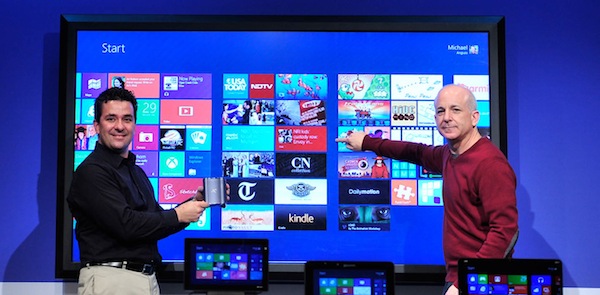
February 29 is the day I waited for for a long time. I downloaded the Windows 8 Consumer Preview to test out the work Microsoft has done so far, and I am very impressed. There are still some rough edges, though, but I like what Microsoft is doing. Strangely, I seem to be one of the few people that actually "get it".
As a designer, I am perfectly on board with anything that allows print and digital to come together in interesting ways. Mike Kruzeniski, who is a Creative Director at Microsoft, gave presentation "How Print Design is the Future of Interaction" at SXSW 2011 discussing this convergence. In interactive, content is important. We are quickly moving to a time where the lines between print and interactive content are blurring. And herein lies the problem with Windows 8. I refer to Metro, Windows 8's new motif that is receiving mixed reaction from testers.
Metro as a design language takes its cues from print: clear sense of hierarchy, reduction of elements (simplicity), generous use of white space and the use of imagery to convey meaning and important information. My point is this: White space scares a lot of people when it comes to applications because for far too long we have been led to believe that the only way to design an application is to add lots of chrome and other interface elements that tend to distract from actual content.
Microsoft is blazing a bold new path into a future where chrome is used when appropriate (Office, Visual Studio, etc.) and when it's not necessary (Metro apps). This is why so many people don't like Metro. The don't like the apps. They don't like the start screen. It's way too different from what they're used to.
But I can't help but think that regardless of how many of us go kicking and screaming into the future of software interaction, Microsoft is on the right track. I believe they should forge ahead with Metro and not look back. Those who don't like it will either switch to another platform or stick with Windows 7. Those of us who are okay with changing our computing habits to adapt to a new way of interacting with our devices will push forward.
One of the biggest challenges I face everyday in designing interfaces is how learnable to make them. In other words, how much do we require the user to learn the interface in order to use the application. The more discoverable features are, the easier an app is to learn and users will potentially use it more. I say potentially because it's easy to believe that the easy discoverability results in an app users love.
Windows interface designers at Microsoft deal with this challenge everyday. As I started navigating my way though the Preview using my mouse and keyboard, I felt many of the interactions were not quite intuitive. But this is not a bad thing! Although they were not intuitive, they were eventually discovered, and once discovered I never forgot them.
The learnability of the Metro interface will be high for some. Some gestures may not be all that intuitive but once you learn them, you don't forget them, and that is what makes an interface a joy to use: content at the forefront and functional/navigational elements hidden but easy to access.
Overall, I am excited about the work I see so far. The fact that is only going to get better makes me as giddy as a virgin on prom night! The Windows user experience team has paid extreme attention to detail and should be applauded. Many of the apps are stunning to look at. Typography is clean. Content is king. Imagery is beautiful and as a co-worker of mine commented while playing with it on a tablet for the first time, "Everything just seems so fluid!"
Metro will be a challenge for those of us used to Windows 7. So what. I'll get over it, just like I did with the changes from XP to Vista. Microsoft should listen to feedback, ignore most of it, and not make any drastic changes. Metro is the right way to go.
 Robert Johnson is a user interface developer specializing in the user experience (UX) of .NET-based web applications. He has been working in some form of web development and graphic design for 14 years. He loves technology in general, particularly that of Apple, Google and Microsoft. He is a Betanews reader.
Robert Johnson is a user interface developer specializing in the user experience (UX) of .NET-based web applications. He has been working in some form of web development and graphic design for 14 years. He loves technology in general, particularly that of Apple, Google and Microsoft. He is a Betanews reader. -

Steve Jobs is gone, Windows 8 is coming and Apple panics
Publié: février 17, 2012, 9:08pm CET par Robert Johnson

I was surprised Apple announced the developer preview of OS X 10.8 yesterday. There is something curiously odd how they went about this, and I believe it has everything to do with the company everyone loves to hate on -- Microsoft.
Anyone following Apple for any length of time should know they are the king of secrecy. Products are announced when they're ready (there are few public betas), usually during invite-only media events. But not this time. Apple claims they did not want to overdo the whole "announcement event" especially having just hosted the iBooks event. That sounds like a pile of crock to me.
According to those in the know, the company hosted private demos among pro-Apple bloggers and journalists -- and as long as two weeks ago. Apple more typically announces a new OS version months before it's made available to anyone, typically during their Worldwide Developer Conference. But with 10.8 things are different. The timing allowed Apple to preempt the release of Windows 8 Consumer Preview, which Microsoft announced in January would be the end of this month.
PC-plus Era
What is so different about today that caused such a drastic change in the way Apple announces and delivers a new operating system? They saw what Microsoft is doing with Windows 8 and panicked.
Say what you want about Microsoft’s Windows 8 strategy, there’s no denying it is aggressive and constitutes one of the biggest shifts in computing the tech industry has seen in almost a decade. Microsoft knows the personal computer's relevance is declining -- hence their use of term "PC-plus" when describing this new era of computing. What we know about Windows 8 and leaked information about Windows Phone 8 confirms their PC-plus mentality. As we will see in Windows 8, the PC becomes a key player along with the phone and TV (Xbox) in productivity and communications.
Apple and Microsoft are attempting to arrive at the same destination from different directions. That destination is mobile computing through device agnostic services and software. The goal: That we as users be able to consume and create content regardless of whether we are mobile or stationary.
Microsoft and Apple have invested much resources in developing continuous services such as sync, continuous communications like FaceTime and Skype and powerful mobile computing capabilities. Microsoft, in making Windows the hub for their PC-plus strategy, instantly has an advantage: Incumbency. Add to that cloud connectivity and sync, parity with Windows Phone and Xbox and ability to run powerful applications, and multiplayer gaming among devices.
The Cat Behind Windows
Take a look at the 10 features Apple revealed about Mountain Lion and compare those Microsoft boasts about Windows 8. Apple is trying to do everything in their power to keep Mac, iPad and iPhone relevant. If that means going to market quickly with features that were planned further down the pipeline, then that’s what they have to do.
Notice how much of iOS they are integrating into OS X: Game Center; Messages; Notification Center; and Reminders. Microsoft has already demoed or mentioned similar services in Windows 8. Game Center is the most telling. Apparently Apple is planning for real-time multiplayer gaming between Apple devices. I don’t believe they are simply copying Microsoft here because this seems to be the way the industry was headed.
My theory is that Apple needed to do something quickly to respond to what Microsoft is doing with Windows 8. This is why we are seeing this new operating system announced as a developer preview in February with a general release in “late summer”.
Windows 8 and its bundled services suddenly makes the iPad, and Mac look less attractive. This smells of panic on the part of Apple, who wants to stay ahead or at least have parity with Windows 8. I think what Microsoft demoed about Windows 8 in September and what has been leaked so far about Windows Phone 8 caused many people to realize OS strategy is not only on the right track but is moving quickly and aggressively to advance the platforms.
Apple will probably release OS X 10.8 long before Windows 8 ships. I can already hear the Apple pundits screaming about how Microsoft overtly copied features of 10.8 that had already been announced for some time. It seems odd to me that the company that coined the term “Post-PC era” is suddenly so “PC-plus” in their strategy.
Photo Credit: Vlue/Shutterstock
 Robert Johnson is a user interface developer specializing in the user experience (UX) of .NET-based web applications. He has been working in some form of web development and graphic design for 14 years. He loves technology in general, particularly that of Apple, Google and Microsoft. He is a Betanews reader.
Robert Johnson is a user interface developer specializing in the user experience (UX) of .NET-based web applications. He has been working in some form of web development and graphic design for 14 years. He loves technology in general, particularly that of Apple, Google and Microsoft. He is a Betanews reader. -

Microsoft, don't screw the pooch
Publié: février 13, 2012, 4:47pm CET par Robert Johnson

In late November, I opined why Microsoft is in trouble. A couple of conversations I had over Thanksgiving led me to believe there are tons of misconceptions about Microsoft consumer products, such as: Windows Phone is dead and Windows PCs are nothing but junk.
But I think the company can correct these problems by aggressively taking action in several key areas: Windows 8 hardware requirements, Windows 8 and Windows Phone marketing, synchronization and natural user interfaces.
Windows 8 Hardware Requirements
Microsoft has a perception problem about Windows PCs being cheap -- and that's not just price -- and that the only quality computers made today come from Apple. This sentiment is a falsehood, and there is a category in the PC realm that competes quite strongly with Apple in the quality arena at the high-end.
For Microsoft to overcome negative perceptions, they will need strict hardware requirements for Windows 8 PCs. Looking at recent ultrabooks, I believe Microsoft is off to a good start here. Going forward, Microsoft should set a high bar for Windows 8 PCs. I personally believe that Microsoft should hold accountable any OEM that wants to develop a Windows 8 device, whether or not it has a logo Why? Unless Microsoft plans to explain to consumers what this logo actually means, I don’t believe many people will care. They simply do not know that the sticker on a PC means anything significant.
If consumers know they can pick up any Windows 8 device and have confidence, regardless of form factor, that it will operate the same, this will go a long way towards removing the notion that all PCs are junk.
Marketing
Apparently Microsoft just laid off a ton of people in their marketing group. I hate to see anyone lose their job. However, I hope it wasn’t all for nothing. Hopefully this is a sign that Microsoft realizes their marketing for some needs improvement. Windows Phone is a perfect example. In January, BetaNews broke the story about Microsoft planning a massive Windows Phone marketing push; I have not seen anything yet.
The NFL playoffs was a great opportunity to launch a Windows Phone ad campaign. What did we see? Apple and Samsung dominating commercial breaks for nearly every game. The aggressive marketing appears to be working as recent financial results reflect. Analysts report that Apple sold 37 million smartphones in Q4; Samsung 36 million.
Microsoft needs to be careful as they plan their upcoming marketing strategy. Consumers don’t really care that much about specs, because they don’t always know what 1.5GHz means. Take 4G LTE, for example: iPhone sold well without it. Over the weekend, a Saturday Night Live Verizon LTE commercial spoof showed how confusing LTE can be.
So instead of telling us specs, Microsoft should show us how Windows Phone can actually make our lives better. Tell us how Local scout will actually help us find a better pizza restaurant. Tell us how the voice features can help us find a move theater in the area. Tell us how Office can help me get work done while getting an oil change on my car. Make us believe that if we don’t get a Windows Phone we’re losers.
If Microsoft wants the new Nokia Lumia 900 to be any sort of success in this country, they have to market the daylights out of that phone. If the phone is launching in March, we should already be seeing commercials praising its benefits like I mentioned above. A low price point at launch is a great start and it definitely piques interest. But the time to start talking about the phone is not after it launches, it’s now. Now is also the right time to announce bundles: Get a free Xbox with your Lumia purchase; switch from iPhone or Android, and Microsoft will pay your contract penalty. These would be great ways to jumpstart device sales in the United States. There’s no reason why we shouldn’t see three or four Windows Phone ads during an evening of TV watching.
My Data Everywhere
Some time ago, Joe Wilcox called sync the killer app for mobile devices. I think he is spot on. From what we know so far, Microsoft is already planning massive upgrades to their SkyDrive service, which will allow many documents to be synced between the PC, phone and TV (Xbox). If Microsoft can successfully execute on this, they will have achieved something that even Apple's iCloud cannot yet accomplish. I believe the following scenarios would be sure winners:
- Allow my entire documents folder to be synced to my SkyDrive. So that any device in which I log on with my Live ID will automatically see those files.
- Allow my music playlists to be syncable. I should be able to access the same playlists from my PC, phone or Xbox. Add a SkyDrive app to the Xbox to make this possible.
- Sync my photos to the phone (this already works) and Xbox. Why is there no SkyDrive app?
- Sync should allow me to easily own Windows 8 devices in multiple form factors and still have access to my data.
- Give me the ability to shoot a photo, video or song from my PC to the phone, phone to Xbox, or PC to Xbox. Microsoft already does this with Windows Phone to Xbox, although in severely limited capacity. Rumor has it that there may even be an Xbox companion app for Windows 8. Let’s hope it enables more functionality.
- I can already use my phone to control my Xbox, how about taking it a step further and allowing me to speak commands into my phone that Kinect will understand. Kinect does not work well when there are many people in a room talking.
- Skype should allow for video communication regardless of device -- PC, phone or Xbox. I should be able to use my phone to make a video call to someone who can answer the call on their Xbox or PC. Microsoft can also take this a step further and allow device-to-device Skype calling. A parent can use their Windows Phone to call their kid's Xbox to tell them to clean their room before Grandma arrives.
- Allow real-time multiplayer gaming between the PC, phone and Xbox. This should work with key games. Microsoft has already demonstrated some of this.
- All of this should be done in a way that is seamless and doesn’t require consumers to have to install anything, or go through lengthy and confusing setup processes. Just like on Windows Phone, I should be able to enter my Live ID and everything should be there or at least start syncing.
NUI NUI NUI
Microsoft has a big head start in this area. Kinect should be in everything: tablets, desktops, phones and TVs through some cheaper Xbox set-top device. I know people balk at the idea of gesturing in front of a monitor while sitting at a desk. But gesturing is not the only aspect of a new user interface (NUI).
Talk and touch are just as important. Imagine you’re in a kitchen handling poultry. The last thing you want to do is touch your phone when it rings. NUI is great for this scenario because it allows the user to send a voice command or gesture over the device to have it respond. A technology does not have to be used every day to be valuable; it just needs to work when it’s needed.
Conclusion
This year has the potential to be the biggest in Microsoft history -- there are so many exciting products in the pipeline. It would truly be sad for the big software underdog to screw-the-pooch and lose out to its competitors in the consumer space. Marketing, sync and NUI are, in my opinion, key execution areas if Microsoft wants to get our attention and win the hearts of consumers. What do you think are the key areas Microsoft needs to execute on to win the hearts of consumers -- or do you think it’s already a lost cause?
 Robert Johnson is a user interface developer specializing in the user experience (UX) of .NET-based web applications. He has been working in some form of web development and graphic design for 14 years. He loves technology in general, particularly that of Apple, Google and Microsoft. He is a Betanews reader.
Robert Johnson is a user interface developer specializing in the user experience (UX) of .NET-based web applications. He has been working in some form of web development and graphic design for 14 years. He loves technology in general, particularly that of Apple, Google and Microsoft. He is a Betanews reader. -

Windows Phone is the best phone you aren't using
Publié: décembre 13, 2011, 7:39pm CET par Robert Johnson

I am a new Windows Phone user -- HTC Titan -- and I cannot be more excited about it. As a UX developer it is very apparent that Microsoft has paid some serious attention to detail in ways I have never seen before. In my opinion, Windows Phone really is the best phone people aren’t using.
Every day, hundreds of thousands of consumers make smartphone purchasing decisions and every day most of them choose Android or iPhone? Why? Because they think they're better since most sales technicians at Verizon and AT&T will push Android or iPhone over and above Windows Phone.
How I bought Windows Phone
A friend of mine and I were out looking for a phone for his wife one day so he decided to visit the Verizon store since the family already has a contract there. As we walked into the store, we were immediately greeted by a sales associate; friendly guy. My buddy asked him where the Windows Phones were. Interestingly the sales dude directed us over to the one phone Verizon had, the HTC Trophy. The associate then said, "It’s a good phone. I have one with me, and I use it for work". After looking at the phone for a few minutes my friend asked about the Motorola Razor. The associate then said, "Now that's a phone!"
Two weeks ago, I explained the problems Microsoft faces with Windows Phone and the perception people have about it. Marketing from Android and iPhone continuously put more focus on these two platforms in the minds of consumers, as being the best. It doesn’t matter that when you first set up a Windows Phone how smooth things come together. It doesn’t matter that Windows Phone has a better and more unique interface than either Android or iPhone. It doesn’t matter that Microsoft paid more attention to detail in an OS than they have ever. If Microsoft doesn’t communicate how Windows Phone stands out from the rest, why should anyone even consider it?
Cellular companies that push potential buyers towards Android and iPhone will continue to cause Microsoft to have low Windows Phone sales. That’s a sad situation considering how good this phone actually is.
Wow, What Easy Setup
Setting up my Windows Phone for the first time was pretty surprising. I already knew that Windows Phone relied heavily on a Windows Live ID and that connecting a WL account to Twitter, Facebook or a host of other online services would make the setup experience a lot easier. However, I chose not to do that just to see if the experience of setting up the phone was different.
My Windows Live account was not connected to Facebook or Twitter. However, connecting my phone to those services, including Gmail could not have been easier. Microsoft has done a fantastic job of streamlining the setup experience. Setting up an account for Twitter, Facebook or Gmail was as easy as logging into those accounts.
Joe Wilcox previously wrote about how well company's do sync will define their platforms. While I do not want to suggest that Windows Phone is perfect in this area, I would say that Microsoft is on the right track for sure. How well Windows Phone utilizes Skydrive surprised. When I navigated to the Office Hub for the first time, it automatically started downloading my office documents and OneNote files saved from Office 2010 to my SkyDrive space. Admittedly Microsoft still has some significant work it needs to do to make sync better but they are off to a great start. For instance, Live Mesh allows you to automatically sync documents between devices (PCs) but Mesh and SkyDrive are not quite fully integrated yet.
You Can Take Back Your Life
Using the HTC Titan Windows Phone is joyous. The phone is huge (4.7-inch display) but somehow not overly big. Windows Phone has lots to like about it. As an iOS user since the original iPod touch and current iPad 2 owner, I think Apple has traditionally been known as the company that pays strict attention to detail. iOS 5 is a slick OS, and there it not much to criticize it for. However, Windows Phone 7.5 does a much better job at putting the most basic and common tasks at the forefront.
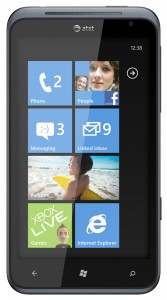 Microsoft marketing takes a "people first", "glance-and-go" approach to Windows Phone. I am here to tell you it’s true. Windows Phone really does make people a priority. I'll explain. Phones are used to primarily interact with human beings: we text, make phone calls and interact on social networks. I had heard for the past year how Windows Phone makes interacting with people tons easier than the other platforms. Having used it in real world experiences for the first time I can actually say it’s true.
Microsoft marketing takes a "people first", "glance-and-go" approach to Windows Phone. I am here to tell you it’s true. Windows Phone really does make people a priority. I'll explain. Phones are used to primarily interact with human beings: we text, make phone calls and interact on social networks. I had heard for the past year how Windows Phone makes interacting with people tons easier than the other platforms. Having used it in real world experiences for the first time I can actually say it’s true.Navigating from the home screen to the People Hub gives you the ability to see what your friends are either posting to various social networks or give you the ability to message them through text or IM (whether it be on Facebook, Windows Messenger or SMS): all in one location without having to jump in and out of apps. I personally find that Android and iOS come up way short.
The other day, I visited a very busy shopping mall but could not find the mall map. I remembered Bing had announced that they had released maps of major malls across America. Assuming these were only on their online maps, I decided to take a look anyway -- to my surprise there it was: a map of the mall I was in. I clicked the map and it gave me a long list of stores; I searched for my store, clicked it and it showed me my current location within the mall and pinpointed exactly where the store was located. Now that's glance and go.
As an avid Xbox user and a huge fan of the console as well, I have to say that Microsoft has done a bang-up job integrating the Xbox experience into the phone. Going to the Xbox hub for the first time, I was surprised to see my avatar appear on the screen exactly as I had customized it. Taping the avatar, results in it doing all sorts of funny things like dancing or trying to sneak off the screen. Having my gamer information seamlessly transition from my Xbox to my phone is convenient and amazing. I like being able to send messages to my Xbox friends to play a game on Xbox Live.
Where Windows Phone Falls Short
As much as I like Windows Phone, it certainly has its issues and I think Microsoft needs to address some of these as soon as possible. I was shocked at how many borderline pornographic applications Microsoft allows at the top of the app list in the Windows Phone Marketplace. If I navigate to Entertainment apps I see "Betty’s Boobs" long before I see Netflix or IMDB! This makes no sense to me at all.
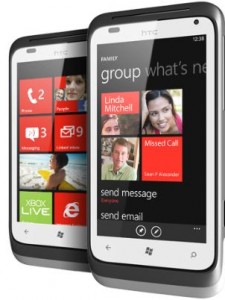 Another issue I think needs to be addressed is with the Bing Maps. Microsoft shows traffic for major highways, but as far as side roads are concerned, nothing. As a former Android user, one of the things I really liked about Android was the maps. The turn-by-turn directions proved to be very useful at times. However, I found the talking voice to be consistently annoying. With Bing, Microsoft took a different (albeit controversial) approach. Instead of hearing the voice at every turn, Windows Phone lets you know by a chime wither or not you are on the right path. Navigate outside the recommended directions and the voice chimes in and lets you know. However, as long as you remain on the right path, you get a very noticeable yet subtle chime sound on your phone. If you want to hear the voice, all you have to do is tap the screen.
Another issue I think needs to be addressed is with the Bing Maps. Microsoft shows traffic for major highways, but as far as side roads are concerned, nothing. As a former Android user, one of the things I really liked about Android was the maps. The turn-by-turn directions proved to be very useful at times. However, I found the talking voice to be consistently annoying. With Bing, Microsoft took a different (albeit controversial) approach. Instead of hearing the voice at every turn, Windows Phone lets you know by a chime wither or not you are on the right path. Navigate outside the recommended directions and the voice chimes in and lets you know. However, as long as you remain on the right path, you get a very noticeable yet subtle chime sound on your phone. If you want to hear the voice, all you have to do is tap the screen.Another area where Microsoft can make improvements is in the area of natural user interfaces (NUIs). There is no reason why a company that has demonstrated voice and gesture technology in the past would release one of the most successful consumer products in history in the Kinect and not figure out a way to get it into the phone. It's simply inexcusable in my mind, and CEO Steve Ballmer does not deserve his bonus this year because of this (and many other issues of course). Apple has Siri and Microsoft has TellMe. Microsoft demonstrated Siri-like feature on Windows Phone long before Apple released iPhone 4S. The future of this platform form a NUI perspective looks very promising.
Better Xbox integration is sorely needed. Last week, Microsoft released the Xbox companion for Windows Phone, but they need to do more. Xbox should be able to play any type of media on my phone: video, music and even pictures.
Almost There?
A buddy of mine recently was in the market for his first smartphone. So what did he choose? Android? Windows Phone? iPhone? He chose iPhone. I asked him why. He explained how much he liked what he saw in Windows Phone but was not ready to take the risk. Take the risk? On a Microsoft product? He would wait for Windows Phone 8. For now though, he wanted something that is much more refined and feature complete. I feel there are many more people like him who will make the same choice against Windows Phone. Microsoft has a daunting task ahead of them.
New Season of Microsoft's Life
Overall, Microsoft has paid so much attention to details in Windows Phone that the overall experience is enjoyable! This, my friend, is a key aspect of user experience design and development. As long as you give end users an enjoyable experience, they will be able to deal with and accept the shortcomings. Whether you believe it or not, it’s true. When developers design software that delight consumers, they overlook errors and inconsistencies.
Windows Phone is not perfect. However, I would definitely recommend WP to new smartphone users. It simply makes sense that if you have a PC (because of SkyDrive) and Xbox, Windows Phone is the best choice. If you are primarily a Mac user, well, you know.
Windows Phone is elegant, smooth, intuitive, practical and extremely fun to use. It’s a new season in the life of Microsoft. This company is thinking, designing, developing and executing in ways it never has before. Perhaps you should give Windows Phone some serious consideration for your next smartphone purchase. It really is the best smartphone you are not using.
 Robert Johnson is a user interface developer specializing in the user experience (UX) of .NET-based web applications. He has been working in some form of web development and graphic design for 14 years. He loves technology in general, particularly that of Apple, Google and Microsoft. He is a Betanews reader.
Robert Johnson is a user interface developer specializing in the user experience (UX) of .NET-based web applications. He has been working in some form of web development and graphic design for 14 years. He loves technology in general, particularly that of Apple, Google and Microsoft. He is a Betanews reader. -

Microsoft is in trouble
Publié: novembre 29, 2011, 1:45am CET par Robert Johnson
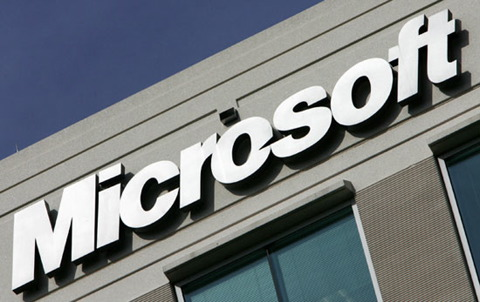
From a technology perspective, Thanksgiving 2011 ranks as one of my most insightful and frustrating holidays ever. I'm an enthusiast who wants to see Microsoft make a strong comeback among consumers. Unfortunately, three Turkey Day incidents left me disheartened.
Microsoft has got a big perception problem.
Three Thanksgiving Day Tales
Incident #1: All Windows PCs are cheap and unreliable. The holiday started at a friend’s house for our yearly Thanksgiving brunch. He and his wife were looking for a new laptop for his parents, because their previous portables -- two Acer netbooks -- finally crapped out on them. My friends told me their budget, and we began our search on Craigslist, then moved on to a few other sites.
As we looked, his wife said she not only wanted to look at Windows PCs but Macs as well. I acknowledged and as we searched, one other person chimed in and said that anything Windows was cheap and unreliable. I asked her why she felt that way and before I could explain why her statement was not true she told me about spending $2,000 on a Gateway machine years ago only to have it give up on her after a few years of use. I explained that Gateways weren't anywhere close to being high-end, and that there are plenty of reliable, handsome and affordable Windows PCs to choose from now.
At this point, my friend's wife is only looking at Macs and not considering Windows PCs at all.
Incident #2: Windows Phones are dead. Later on, my buddy’s brother walks up to me to ask me what cell phone I use. "Original Motorola Droid. But I will be switching to Windows Phone once they go on sale for one penny". (Since, I am officially a new Windows Phone user, by the way.) His response: "Why? Everyone has stopped selling those phones because they are not selling well".
I told him that wasn't true because Windows Phone 7.5 models started selling a few weeks ago and what he had heard or read was most likely retailers clearing out older stock. I told him that Nokia has bought into the WP7 platform and that their new Lumia 800 smartphone sells well -- it's even sold out in some markets.
I then asked him where he was getting his news from and he said, "Google searches that lead to various articles". I told him that was his first problem and suggested several sites to get more accurate technology news.
A similar scenario played out a few minutes later when I shared with my buddy excitement to order my first Windows Phone. "Why? Why not get an iPhone?" My answer is better suited for another post, but he seemed to understand how Windows Phone would better fit my needs.
Incident #3: Microsoft’s absent marketing. I'm a football junkie every Thanksgiving Day -- who isn't? I watched the Packers and Lions, Cowboys and Miami (Go Cowboys!) and my beloved Aggies and Longhorns (how devastating!). One thing I noticed during commercial breaks: Apple and Samsung (to a lesser degree) dominated technology advertising. Where was Microsoft? One commercial: where the dad is in the store using his Windows Phone OneNote application shopping list. Perhaps you saw more?
Microsoft’s Big Problem This Holiday Season
As I contemplate the three incidents, it becomes very apparent to me that Microsoft has some pretty large hills to climb. I can't escape the feeling that they may be in really big trouble. Have things really gotten so much out of hand that no matter how amazing Windows 8, Windows Phone 7.5/8 or any manner of Xbox integration into these platforms is, that Microsoft will not be able to overcome the odds that are stacked against them? I personally do not believe that is the case but let me explain briefly why I believe these three incidents pose some very big challenges for CEO Steve Ballmer and Microsoft.
Cheap-quality Windows PCs? Many people really do believe that the Windows PCs they see in BestBuy, Walmart, Target and many other retailers represent the entire PC industry, that every PC is cheap -- and why not when Macs cost so much more? Why would Apple charge so much more for pretty computers if they weren't better? Many consumers have this unfortunate mentality.
This perception hurts Microsoft. HP and Dell have been running commercials advertising high-end PCs in the Envy and XPS lines that easily compete with Macs. But commercials like these are not enough to change perceptions.
Microsoft has a perception problem and they need to address it much more stridently in their marketing. Many Windows PCs really do offer better value and provide a much more solid user experience than can be obtained on a competing Mac. But who really knows this!
There is a generation of young people growing up with iPods and Macs -- and all they know is Apple. They have never used a Windows PC. Someday this generation will become the decision makers in IT departments and they will choose Macs over Windows PCs. They'll know pretty Apple products and believe Windows PCs are cheap, unreliable and destructive to the financial bottom line of IT departments. They will want something they think is more reliable, and an Apple logo will be on it.
What is a Windows Phone? Version 7.5 "Mango" launched nearly eight weeks ago, and the first new WPs started earlier this month. While I have seen some TV commercials for the products, there are nowhere near as many as iPad and iPhone 4S.
I am not a big fan of Microsoft's "We’re a Family" commercials so far because I do not think they do the best job at clearly articulating why a Windows Phone, PC or Xbox is better than the competition.
It’s my personal opinion that Apple is onto something with their commercials. In many of them they pick one feature and hammer it home. I prefer this approach because there are so many people who do not know that Windows Phone also includes the ability to talk to the phone and have it perform certain tasks, for example.
Thanksgiving football is a perfect opportunity to get your products on the minds of millions the day before Black Friday. How Microsoft could be so absent in its advertising at this critical juncture is appalling. Just like with Windows Vista, they’re letting someone else -- Apple obsessed-biased media -- tell the story of one of their key but struggling products.
What Do You Think?
I really believe Microsoft has created some compelling products in Windows Phone and Windows 7. But I don't think they are being aggressive enough at combating some of the negative perceptions that work against them. Many poeple are unwilling to give Microsoft products a try because they automatically assume that anything with an Apple logo is anointed with unicorn tears.
What do you think? Is Microsoft in trouble? Is their Windows Phone marketing ineffective so far? What can Microsoft do to overcome the perception that all Windows PCs are unreliable pieces of junk? Sound off in the comments below.
 Robert Johnson is a user interface developer specializing in the user experience (UX) of .NET-based web applications. He has been working in some form of web development and graphic design for 14 years. He loves technology in general, particularly that of Apple, Google and Microsoft. He is a Betanews reader.
Robert Johnson is a user interface developer specializing in the user experience (UX) of .NET-based web applications. He has been working in some form of web development and graphic design for 14 years. He loves technology in general, particularly that of Apple, Google and Microsoft. He is a Betanews reader.